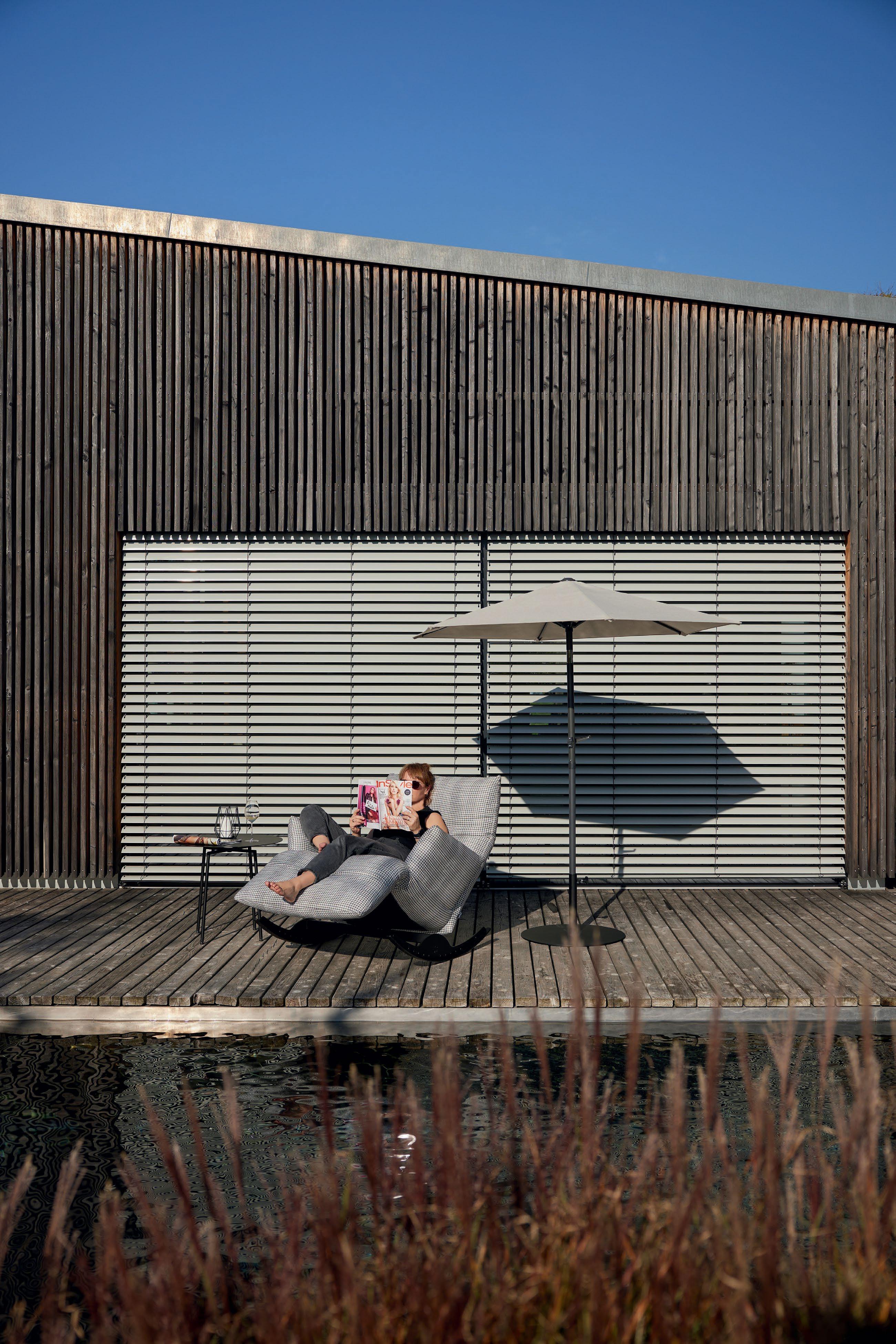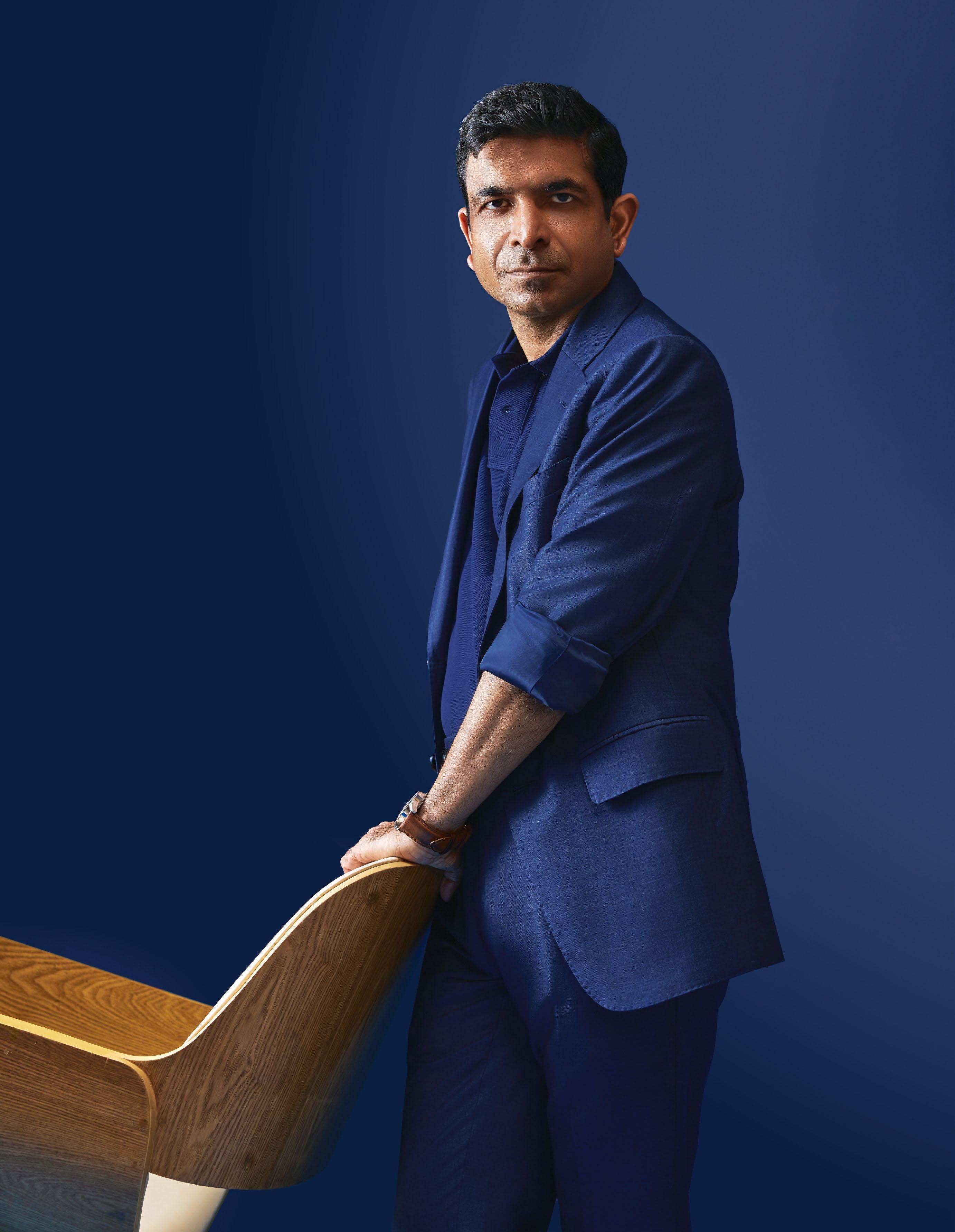
BIG DEALS, SAFE BETS
Ashish Jakhanwala, SAMHI’s Chairman, CEO & MD, on making strategic moves, staying boring, and why the real growth story is only beginning.


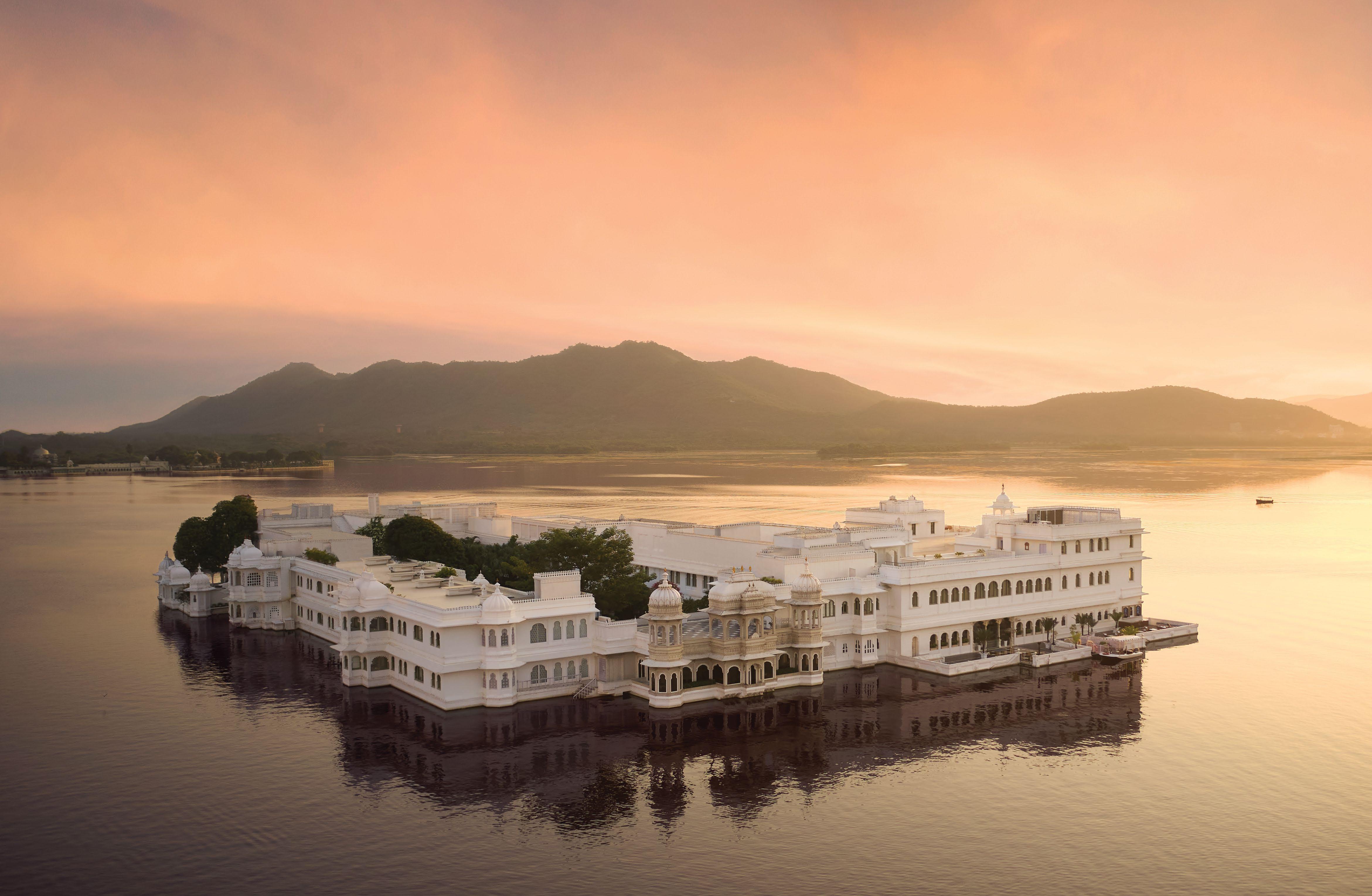
CREATING LEGACIES WAS A ROYAL TRADITION. KEEPING THEM ALIVE IS OURS.




Ashish Jakhanwala, SAMHI’s Chairman, CEO & MD, on making strategic moves, staying boring, and why the real growth story is only beginning.



CREATING LEGACIES WAS A ROYAL TRADITION. KEEPING THEM ALIVE IS OURS.


There’s something thrilling about the way Indian food is showing up on the global stage today— bolder, prouder, and more deeply rooted than ever before.
You see it in New York, where Chef Vijay Kumar serves banana leaf fish and gunpowder potatoes at Michelin‑starred Semma, unapologetically channelling his Tamil Nadu childhood. You taste it in Bangkok, where Garima Arora’s Gaa, the first Indian restaurant in Thailand helmed by a woman to earn a Michelin star, crafts a new lexicon for Indian flavours—seasonal, subtle, and soulfully inspired. You experience it in Bungalow, where Vikas Khanna—drawing from his Amritsari roots— has created an iconic gastronomic destination that blends nostalgia with finesse, and everyday flavours with quiet luxury.
And the list keeps growing. In Dubai, Chef Himanshu Saini and Bhupender Nath’s Trèsind Studio became the world’s first Indian restaurant to be awarded three Michelin stars. Gaggan Anand’s Gaggan was just named The Best Restaurant in Asia 2025, reaffirming his place as one of the world’s most inventive chefs. In Singapore, Chef Manjunath Mural led The Song of India to its Michelin starred moment—still the only Indian restaurant in Southeast Asia with that honour. In London, Gymkhana won its second star in 2024, and Birmingham’s Opheem, led by Chef Aktar Islam, also rose to two Michelin stars. Vineet Bhatia and Atul Kochhar—trailblazers in the UK—were among the first to put Indian cuisine on the Michelin map.
This isn’t just global acclaim—it’s a global reframe. Indian cuisine is no longer being reduced to stereotypes or simplified for palates. It’s being celebrated for its nuance, its integrity, and its emotional memory.
This passion is also simmering within India’s own kitchens.
Across the country, chefs—many of whom trained abroad—are turning their gaze inward. The regional lens has widened into a movement. Menus are now led by millets, foraged greens, single‑origin oils, and hyper‑local traditions once deemed too rustic for fine dining. It’s not a trend; it’s a tectonic shift. Across boutique hotels and fine‑dining spaces, these ingredients are reappearing—not exoticised, but respected.
Take the rise of locavore philosophy in Indian hospitality. In boutique hotels, coastal resorts, and urban flagships alike, chefs are asking new questions: What’s native to this region? What do the locals cook when it rains? What ingredient have we overlooked for too long? And they’re answering with food that is both exquisite and emotionally resonant—jackfruit curries, fermented kanji, hand‑pounded chutneys, and age‑old pickles that feel like a warm hug from another time.
Luxury, too, is being redefined. It’s no longer foie gras and flown‑in truffle. It’s heirloom rice from a neighbouring farm. It’s the fragrance of mustard oil, the comfort of rasam, the surprise of finding something beautifully unfamiliar on your plate— and realising it’s from just one district over.
What we’re witnessing is not just a culinary evolution. It’s a cultural one. A reclamation of wisdom. A restoration of pride. A reconnection with the land, the seasons, the grandmothers, the forgotten recipes.
For years, Indian food travelled the world, seeking recognition. Now, it’s the world that’s arriving at our doorstep—curious, open, and ready for the richness we’ve always carried. And this time, we’re not just telling our story. We’re serving it, beautifully.

GURMEET KAUR SACHDEV gurmeetsachdev@soulinkkworldwidemedia.com

CRAFTED FOR HOTELS THAT OFFER MORE THAN A STAY

World’s Largest Mattress Group — spanning 5 continents, 62 countries, and 78 licensees, Eclipse brings global expertise to every room.

We are chosen by the finest
Institutional Sales (India & Sub Continents)
Call +91 9899222559
Email sdutta@eclipsemattress.in
Website www.eclipsemattress.in

Institutional Sales (India & Sub Continents)
Call +91 9029373942
Email a.rawal@eclipsemattress.in
Website www.eclipsemattress.in
WE BELIEVE THAT REAL BEAUT Y LIES IN THE DETAILS and many more.




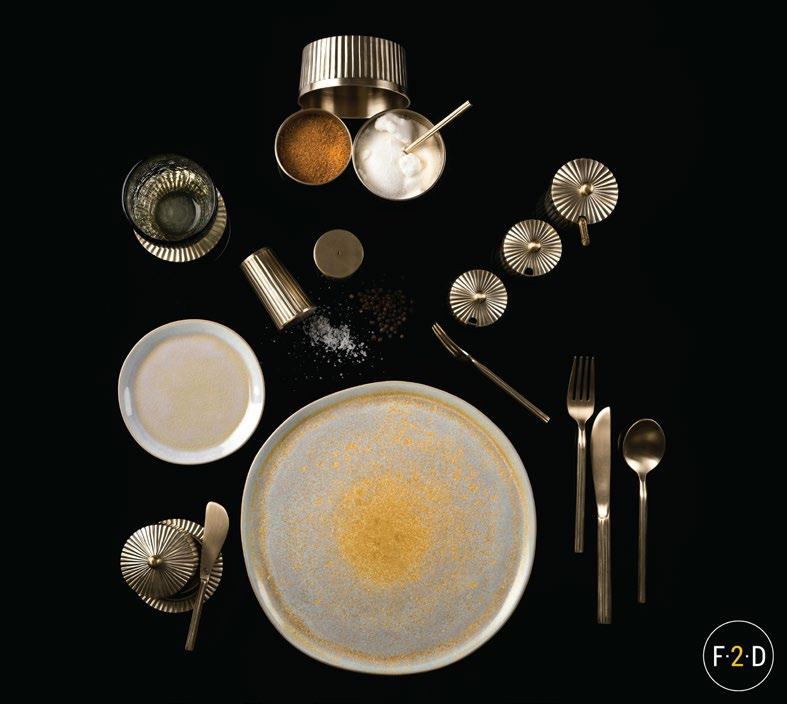


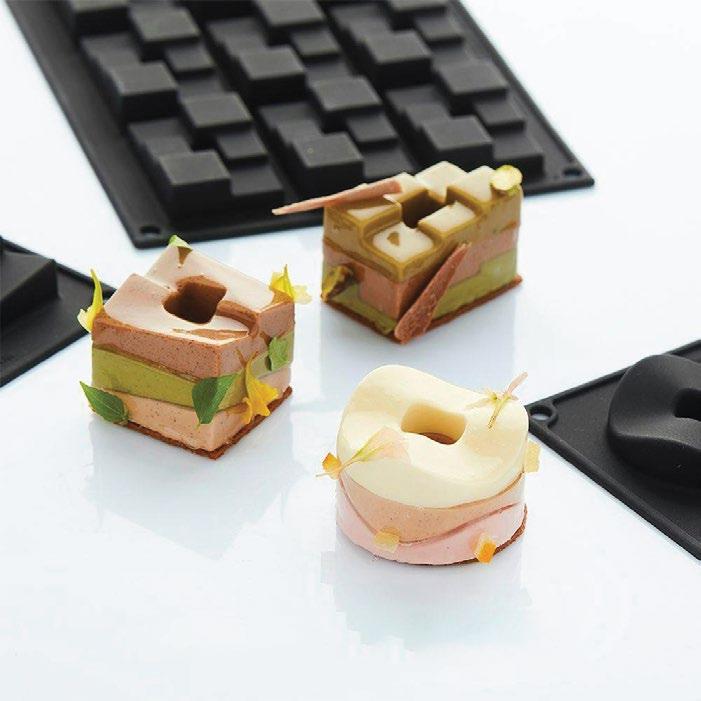
There are hotel owners who invest not just money, but passion—creating exceptional properties that have shaped India’s hospitality landscape. And then there are institutional investors bringing scale, discipline, and long-term vision. Ashish Jakhanwala’s SAMHI exemplifies this shift—turning around underperforming assets, partnering with global brands, and emerging as one of India’s largest hotel owners. In our cover story, Jakhanwala—candid and characteristically witty—reflects on SAMHI’s journey, its 2023 IPO, and the wave of listings reshaping the industry.
In our Market Intelligence section, we turn to Odisha—a jewel of eastern India often overlooked by travellers. Long relegated to the bottom of India’s tourism charts, the state is now making a strategic push with new policies and projects, from ecological tourism to spiritual circuits, to attract those seeking pristine, offbeat destinations.
Equally offbeat is Ajabgarh, where boutique brand Ananta Resorts and Spas has opened its latest property. In a state known for heritage hotels and traditional architecture, Ananta stands apart with its contemporary design and organic minimalism. In Boutique Blueprint, we explore how the brand is anchoring itself in lesser-known destinations with a focus on eco-conscious, off-the-grid hospitality.
Also not to miss: our in-depth story on F&B consultants—a feature that took months to research. With India seeing a new wave of aspiring restaurateurs and bar owners, chefs and bartender-entrepreneurs are stepping in as consultants, helping navigate a glamorous yet risky business. This piece breaks down the evolving playbook behind launching successful food and beverage ventures.
Enjoy the read.
Warm regards,
DEEPALI NANDWANI, EDITOR, SOH
Founder and Publisher
Gurmeet Sachdev
Editorial
Editor Deepali Nandwani
Managing Editor Rupali Sebastian
Contributing Editor Suman Tarafdar
Digital Editor Rachna Virdi
Contributing Writer
Chandreyi Bandyopadhyay
Columnists
Mary Gostelow
Creative
Creative Director Tanvi Shah
Team Shiv Soni
Business Head
Vipin Yadav
Delhi, +91 99998 85515 vipin@soulinkkworldwidemedia.com
Sales Manager
Deepa Rao
Mumbai, +91 9136 000369 sales@soulinkkworldwidemedia.com
Office Manager
Deepak Rao
Accounts Head
Amey Acharekar
For queries: editorial@soulinkkworldwidemedia.com sales@soulinkkworldwidemedia.com info@soulinkkworldwidemedia.com
Printed and Published by Gurmeet Sachdev on behalf of Soulinkk World-Wide Media LLP. Registered office: 1/2, Old Anand Nagar, Nehru Road, Santacruz East, Mumbai, Maharashtra - 400055. Printed at Silverpoint Press Pvt. Ltd., A-403, TTC Industrial Area, Near Anthony Motors, Mahape, Navi Mumbai – 400709. Editor: Deepali Nandwani. All rights reserved worldwide. Reproducing in any manner without prior written permission prohibited. SOH takes no responsibility for unsolicited photographs or material all photographs, unless otherwise indicated, are used for illustrative purposes only. Unsolicited manuscripts will not be returned unless accompanied by a postage pre-paid envelope. All disputes are subject to the exclusive jurisdiction of competent courts and forums in Mumbai only. Copyright Soulinkk World-Wide Media LLP.

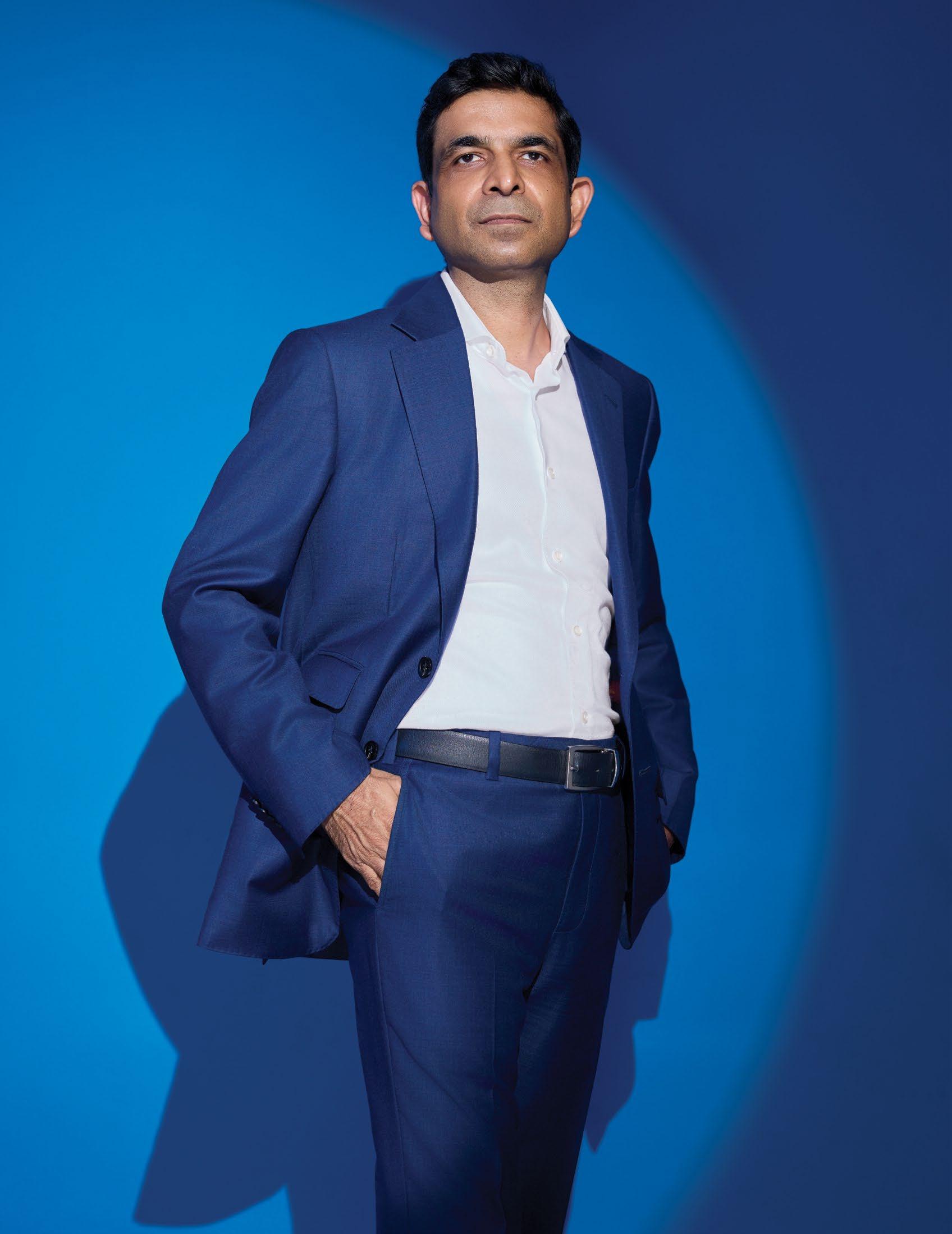
48
Ashish Jakhanwala and the Art of the Bold Bet
With SAMHI Hotels, he’s reimagining India’s hospitality playbook—through strategic acquisitions, institutional capital, and a sharp focus on high-demand urban markets.



16
Spiced with Story Indian fine dining embraces Middle Eastern soul, depth.
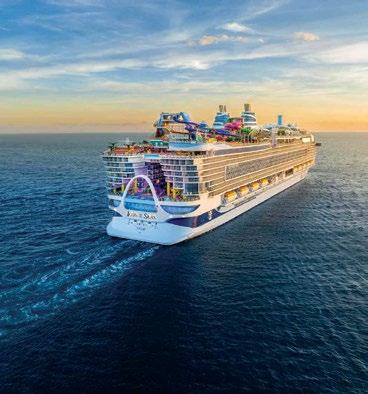
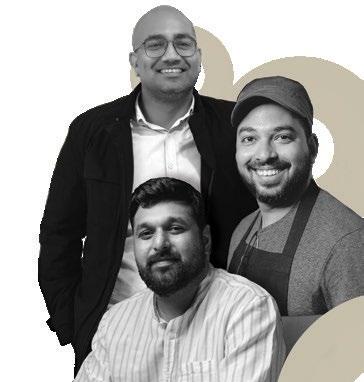
112 Menu Mentors
Consultants help decode success in India’s restaurants.
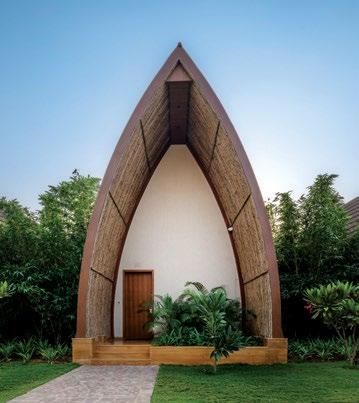
Soulful Stays
Ananta offers spiritual luxury and conscious hospitality experiences.
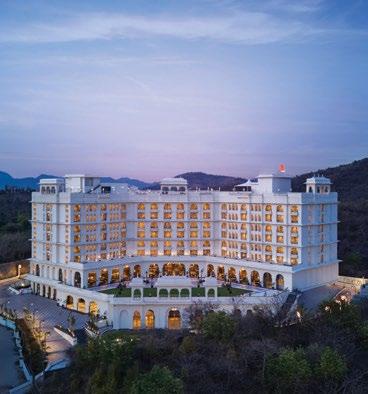
82 Rooted Refinement Marriott Udaipur channels the city’s spirit elegantly.

92
Queerly Global For Sushant Divgikar, travel is where identity breathes free.
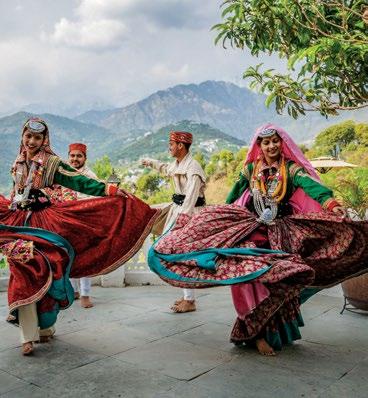
74
Craft Revivalists Hotels embrace culture, elevating local arts to luxury status.
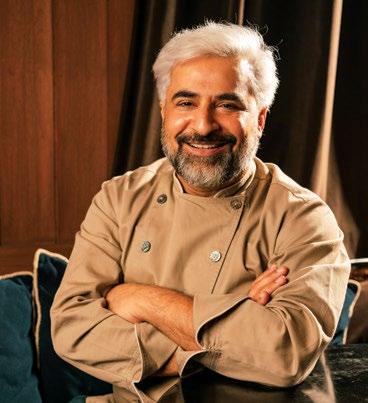
122
Pride on a Plate
Chef Suvir Saran serves truth, spice, and trailblazing vision.





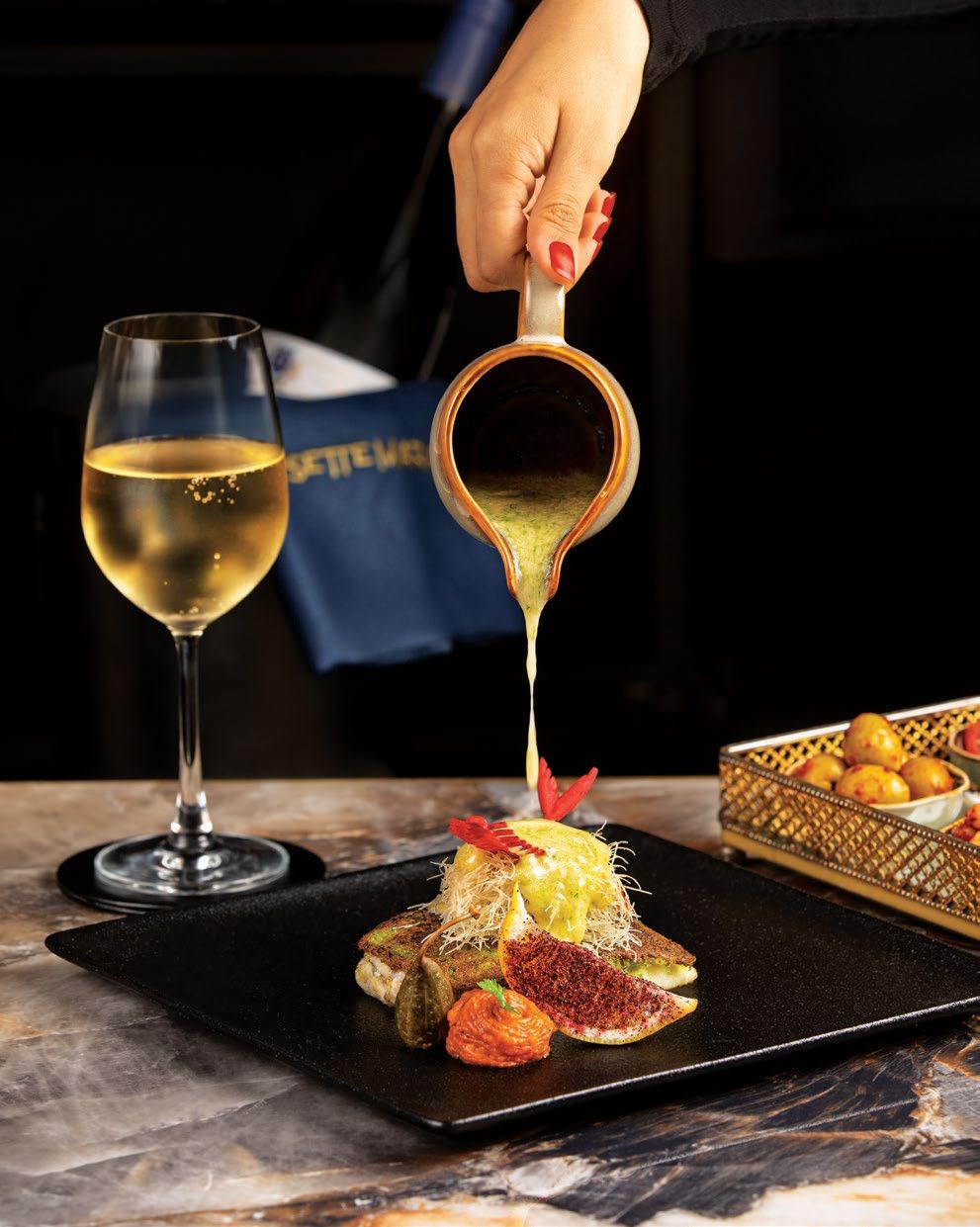


With storytelling, ingredient authenticity, and regional nuance at the forefront, a handful of high-end restaurants in India are reshaping perceptions of Middle Eastern food—from casual staples to cultural statements.
DEEPALI NANDWANI
There’s more to Middle Eastern cuisine than we realise. Yes, there’s labneh, falafel, hummus, and pita bread. But the food from this region—which spans the Arabian Peninsula, the Levant, Turkey, Egypt, Iran, and Iraq—goes far beyond these familiar staples.
Indians, even the less adventurous, have long been connoisseurs of Middle Eastern cuisine. Its bold flavours, aromatic spices, and hearty dishes have earned it a special place in the country’s culinary landscape. Yet, in India, our experience of the cuisine has largely remained limited to hummus platters and falafel.
Till now. A new wave of fine-dining restaurants— both standalone venues and those housed in luxury hotels—is shifting the narrative. These places are pushing the boundaries of tradition, serving inventive dishes that offer a plethora of flavours and reveal the true depth and diversity of Middle Eastern culinary heritage.
Here are our favourites from across India.
THE TAJ MAHAL PALACE MUMBAI
Perched on the rooftop of The Taj Mahal Palace, Mumbai, with a bird’s-eye view of the Arabian Sea, Souk is an IHCL classic. “What sets us apart is the authenticity of our recipes, many of which are guided by our Syrian masterchef, ensuring true-to-origin flavours,” says Executive Chef Amit Chowdhary.
The space channels the spirit of a Middle Eastern bazaar. On the menu: delicately spiced tagines, mezzes, and grill platters. “Traditionally, Indian diners weren’t familiar with Middle Eastern cuisine beyond a few well-known items. However, in recent years, there has been a noticeable shift. More people are exploring the cuisine in its depth and diversity, venturing beyond the basics into regional specialities. At Souk, we’ve seen a growing appreciation for complex flavours like sumac, pomegranate molasses, and za’atar.”
Souk’s menu reflects a rich tapestry of flavours from across the Middle East and Eastern Mediterranean—Syria, Turkey, Lebanon, Morocco, and Greece. The chefs work with distinctive ingredients: Mahleb, a subtle cherry-kernel spice used in breads and pastries; barberries, tart, jewel-like berries that brighten rice dishes; and mastic, a natural resin that lends aromatic depth to both savoury and sweet preparations.
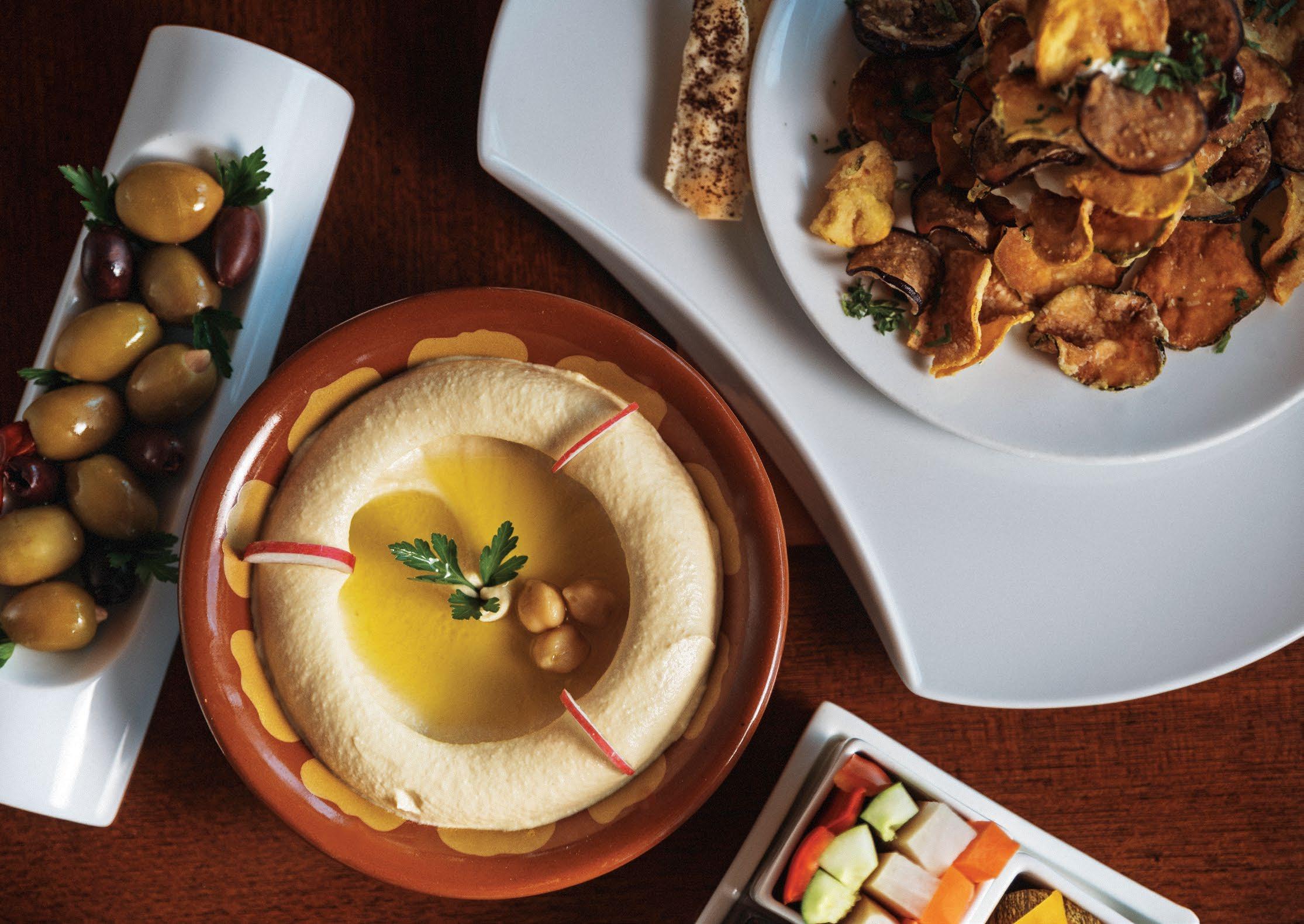
Signature dishes span the region—Hunkar Begendi and Lahmacun from Turkey, Kotosoupa Avgholemono and Tirokafteri from Greece. “Subtle touches—like saffron, pomegranate molasses, and sumac— showcase the wide-ranging flavours across the region,” says Chowdhary. “We use ingredients with distinct profiles: za’atar and sumac for herbaceous and citrusy notes; date syrup and pomegranate molasses for natural sweetness and depth in salads; Turkish chilli paste to add smoky heat to grills like Samak Meshwi and Turkish-style vegetables; and Kibbeh spiced with Baharat, a warm blend that brings signature Middle Eastern complexity.”
The Hummus Bil Toum with Black Garlic, a creative spin on the classic, carries deep umami notes from aged black garlic. Tagine dishes are slow-cooked and served in traditional conical pots, staying true to Moroccan heritage while adding theatrical flair to the table. “We also integrate interactive elements to engage guests—like our Rose Petal Ice Cream, served over dry ice. The mist creates a dramatic effect and amplifies the floral aroma, turning dessert into an experience.”
Even the cold dips in the mezze platter nod to geography. Each— like Muhammara or Tirokafteri—is plated with a carved “well” in the centre, filled with extra virgin olive oil. The presentation is both visually striking and rich in flavour.
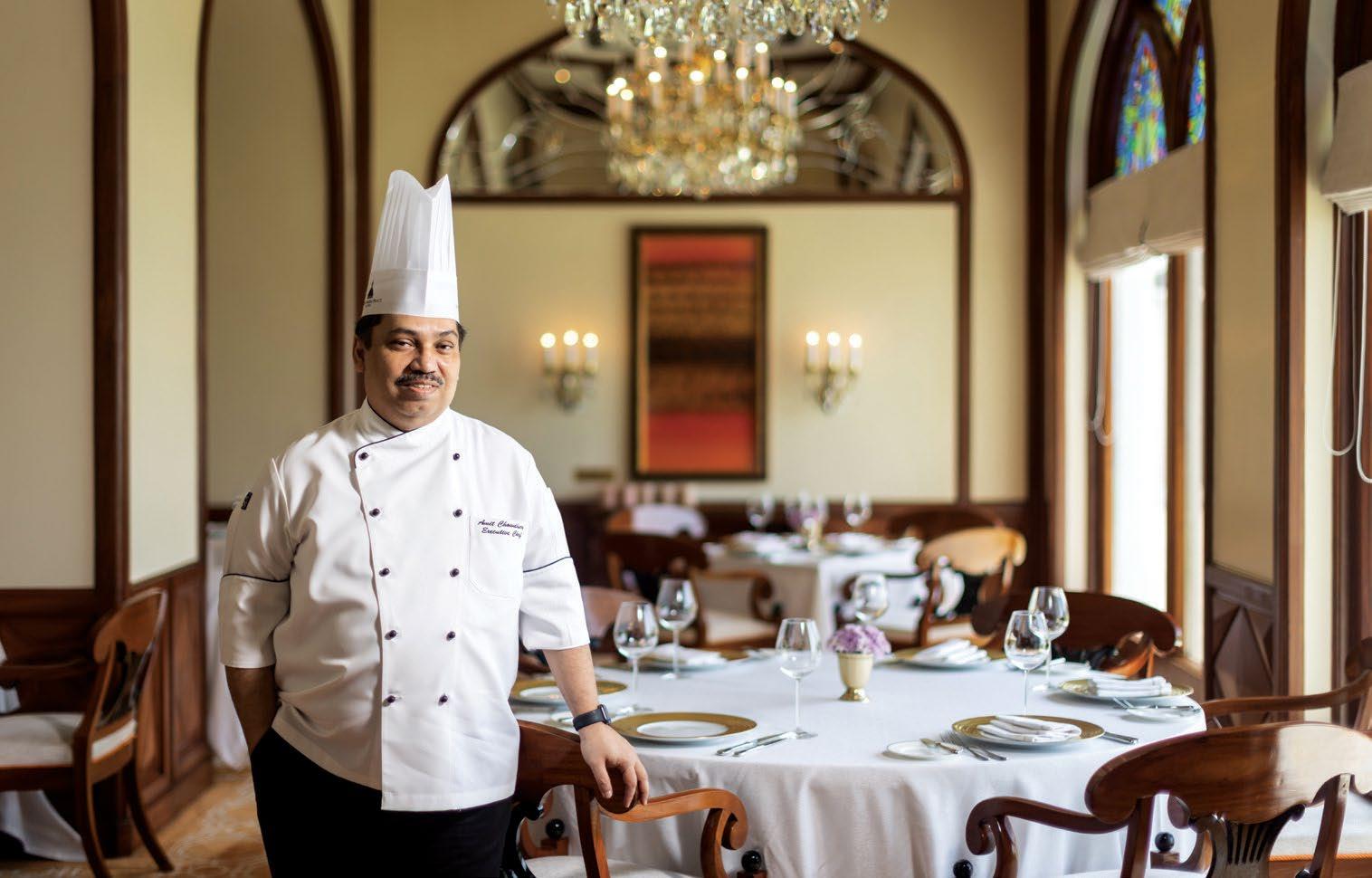

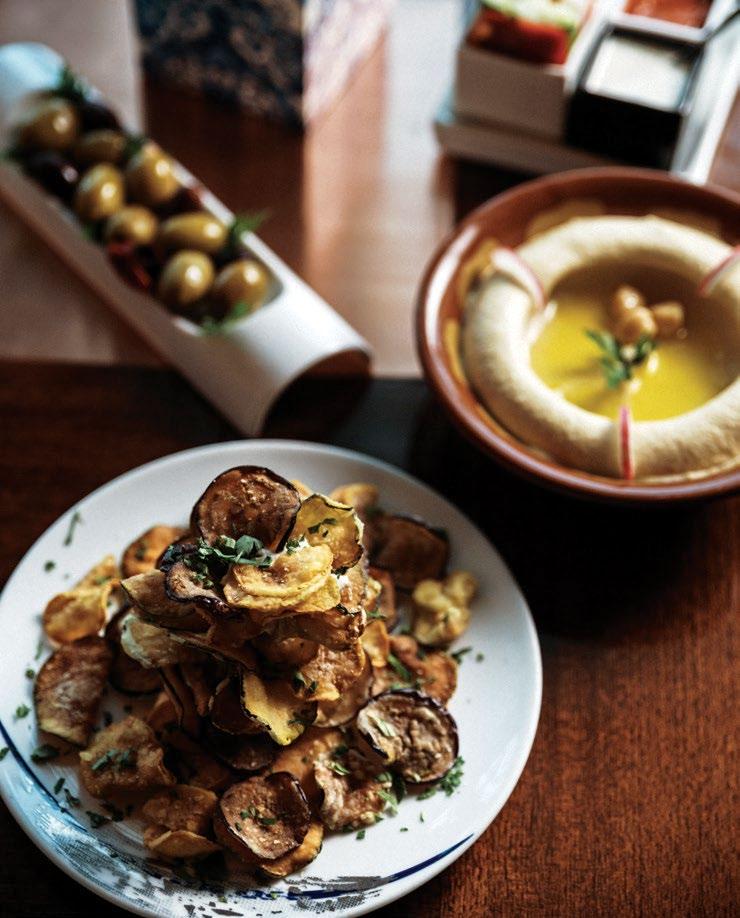


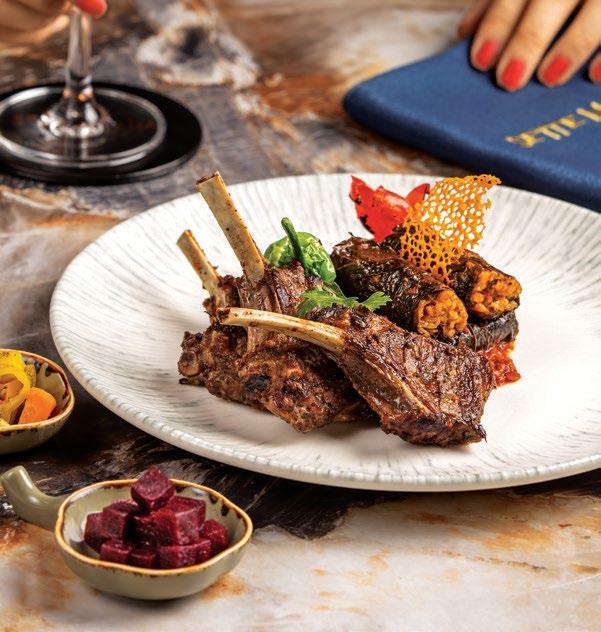



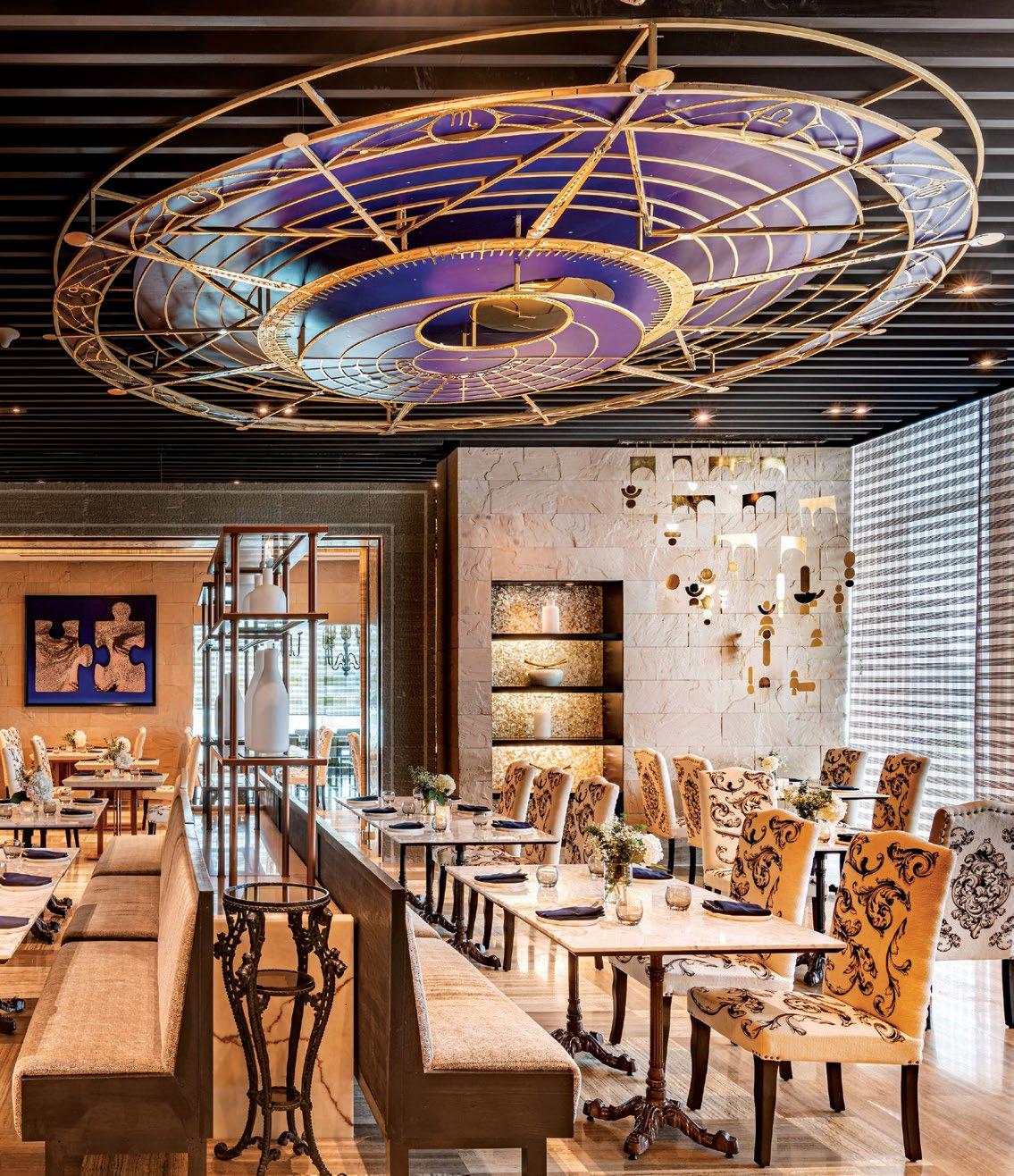


The menu at Sette Mara draws from the rich culinary traditions of the Levant and the countries surrounding the Mediterranean Sea. “It’s curated with deep nuances of aromatic spices and wholesome ingredients from the vibrant cultures of Greece, Turkey, Egypt, Morocco, Lebanon, Persia, and Georgia,” says Director of Culinary, chef Paul Kini.
Sette Mara is a deep blue space, anchored by a suspended navigational constellation compass above the dining area. The lounge and bar evoke the atmosphere of Middle Eastern ports, with burnished rusts, burgundies, and cinnamon tones reminiscent of cargo—spices, wines, and perfumes.
The dishes on the menu share a common geographical thread but are prepared using a variety of techniques and ingredients. “In an effort to change the perception of Middle Eastern cuisine, Sette Mara offers a wide variety of Levantine delicacies that showcase both tradition and the cuisine’s adaptability to modern times,” says Kini.
Highlights include Yemeni Kabsah, Lebanese Baklava, and the Egyptian dessert Umm Ali. Signature kebab platters represent the Mediterranean’s three culinary foundations—farm, ocean, and land: Baharat Spiced Halloumi and Berbere Portobello from the farm, Charred Rock Lobster and Tiger Prawn from the sea, and Lamb Shish and Chicken Taouk from the land.
Alongside traditional Mediterranean mezze like Shakshuka and Dolma, the menu infuses Levantine flavours into dishes such as Vegetables in Za’atar Butter and Baklava Cheesecake. While the flavours often stay rooted in tradition, the plating and presentation are distinctly contemporary. “Many Middle Eastern ingredients are used in other cuisines where their origins go unrecognised,” notes Kini. “Take Halloumi cheese, for instance—it’s salty, tangy, slightly minty, with a firm, chewy texture. We feature it in our hot mezze—Halloumi Sambousek, a crispy, flaky savoury pastry.”
A rare inclusion is Pul Biber, or Aleppo pepper—a coarsely ground, semi-dried, seedless red pepper flake known for its mild heat and fruity tang. It adds depth to the restaurant’s signature spicy harissa, used in dishes like Sette Mara Batata Harrah and Lamb Arayes.
At Anar, a Middle Eastern restaurant with a lush Anjuna field view, bold and beautiful flavours from parts of the Middle East—including Iran—are served in dishes rarely seen before. Head chef Rishabh Law presents a menu where nostalgia meets novelty, drawing from a region connected by shared ingredients and origin stories. “The dining experience at Anar is meant to be immersive, intimate, and transportive,” says Anant Kataria, co-founder of Anar. “The food is Persian-forward but weaves in flavours and influences from Lebanon, Syria, Turkey, Saudi Arabia, the UAE, and Afghanistan.”

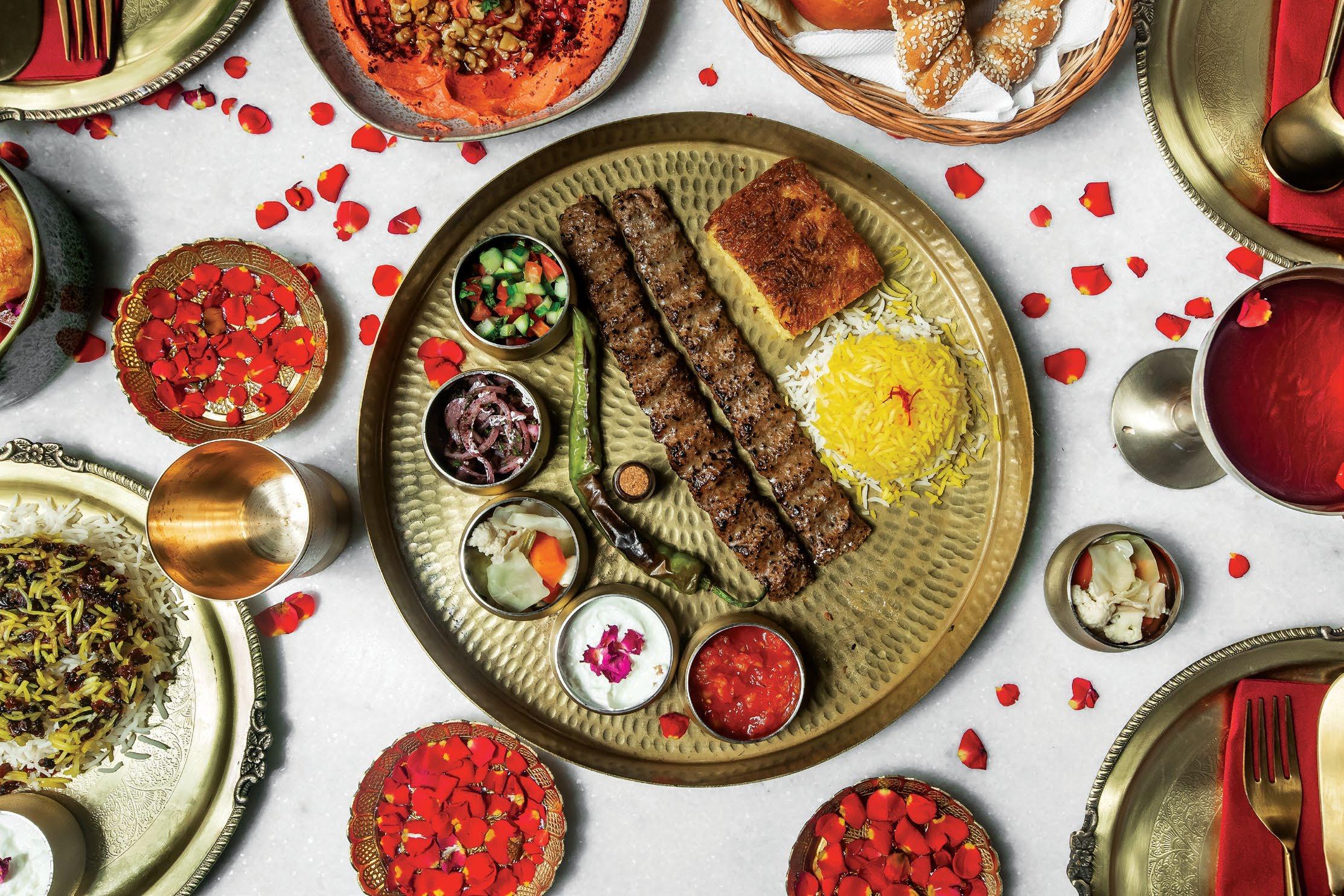



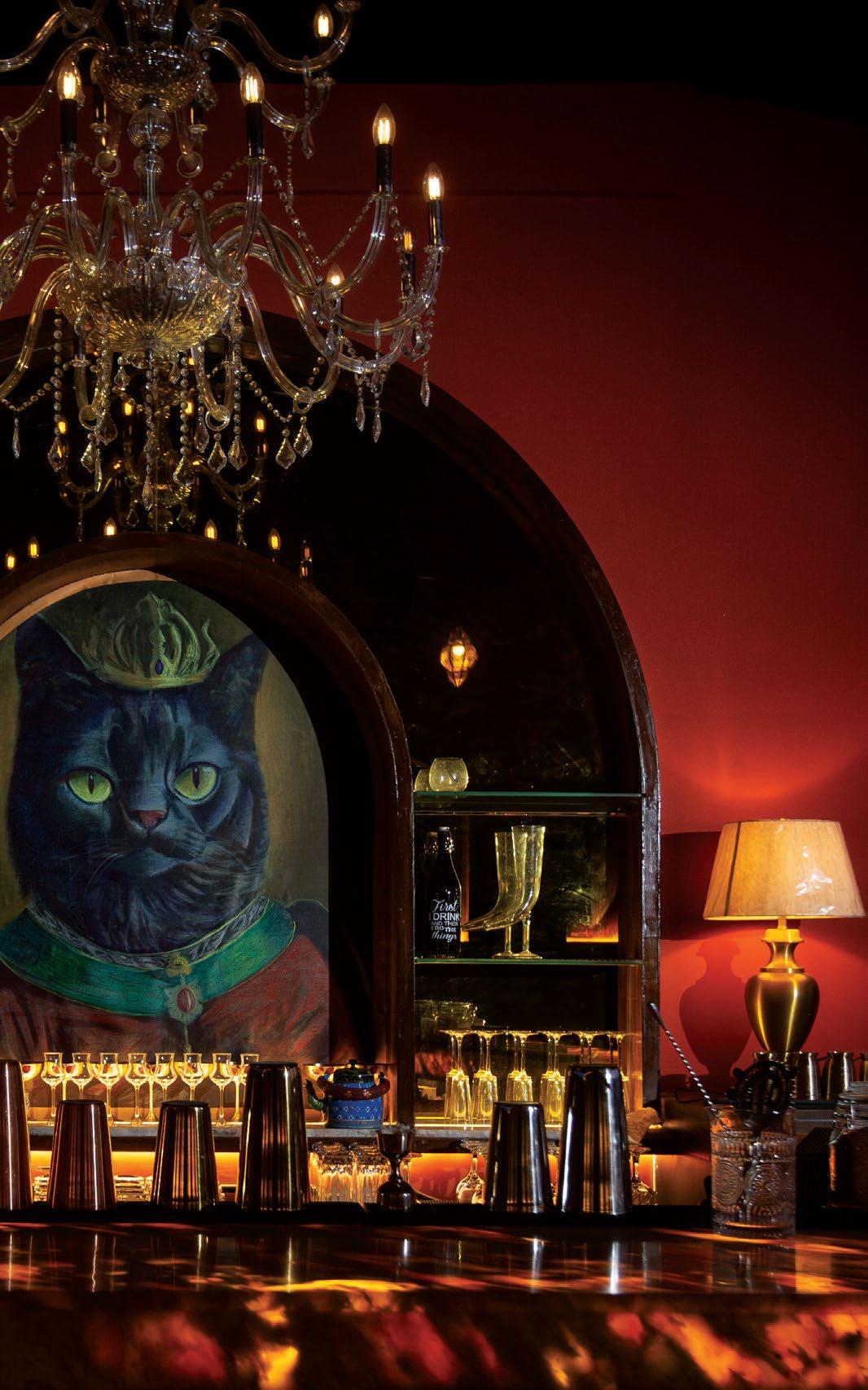
The open-air space mirrors Middle Eastern aesthetics: red walls, glowing brass accents, and handcrafted furniture set the tone, while playful warrior cat murals add character. The mood shifts with natural light by day and candlelight by night.
Storytelling defines the Anar experience. Pomegranate motifs— anar—appear on the cutlery and throughout the space. “Every detail, from crockery and music to cocktails, is designed to transport the diner,” says Kataria. “We aren’t trying to replicate a single country’s cuisine. Instead, we present a broader, more layered vision of the Middle East—one that balances elegance with comfort, nostalgia with novelty.”

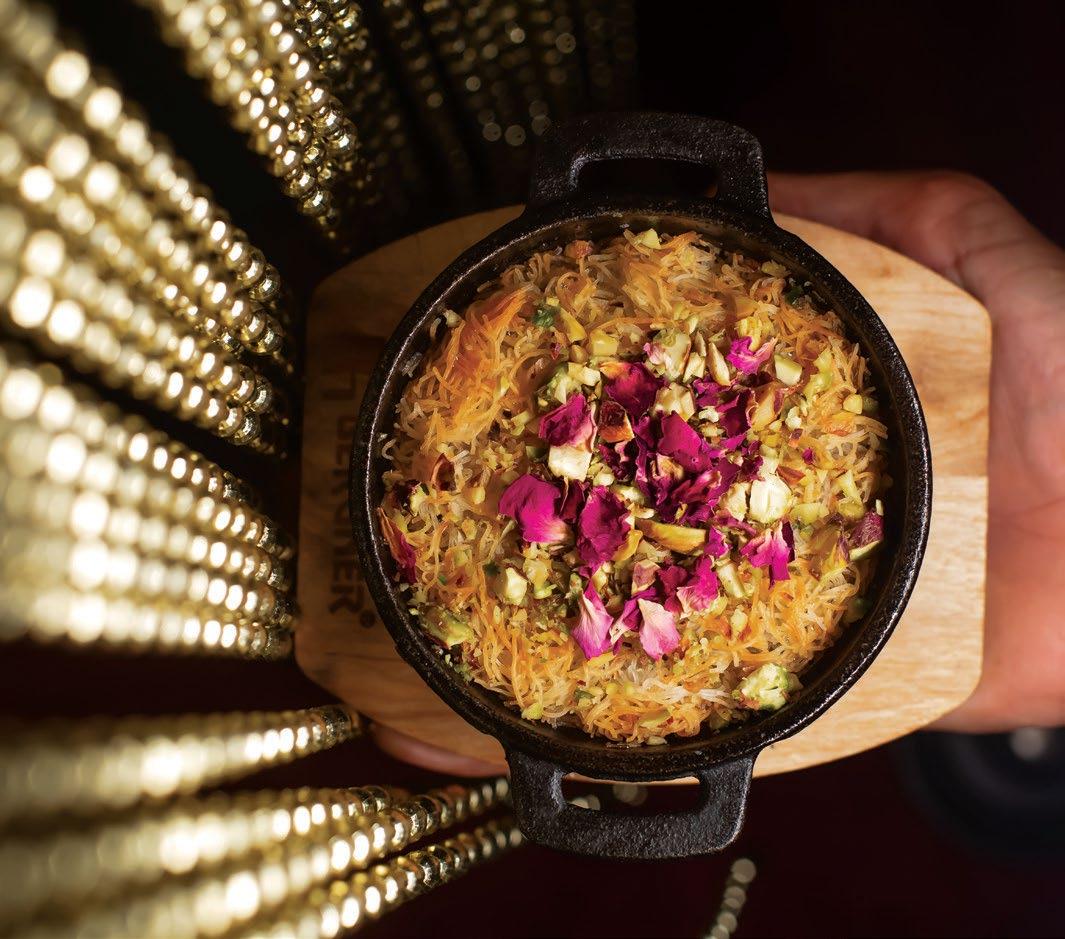
Two dishes particularly stand out—one surprisingly vegetarian in a largely meat-heavy cuisine. Ghormeh Sabzi is a Persian herb stew made with fenugreek, parsley, coriander, dried limes, and slowcooked kidney beans. “It’s rich, earthy, and comforting—a dish that showcases the complexity of Middle Eastern vegetarian cooking,” says Kataria. The second, Kabab Koobideh, is a Persian-style minced lamb kebab marinated with onion and subtle spices, then grilled over charcoal until juicy and smoky. “Served with sumac onions and saffron rice, it’s a dish that guests return for.”
Also gaining ground is Kabab Torsh—charcoal-grilled beef tenderloin marinated with walnuts, pomegranate molasses, and herbs, served over creamy hummus. “It’s a dish of bold contrasts: the richness of the meat, the tart sweetness of the marinade, and the earthiness of the walnut-herb mix,” Kataria explains.

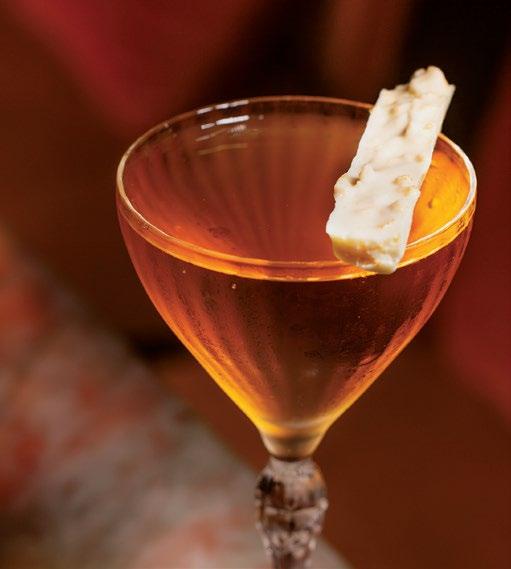
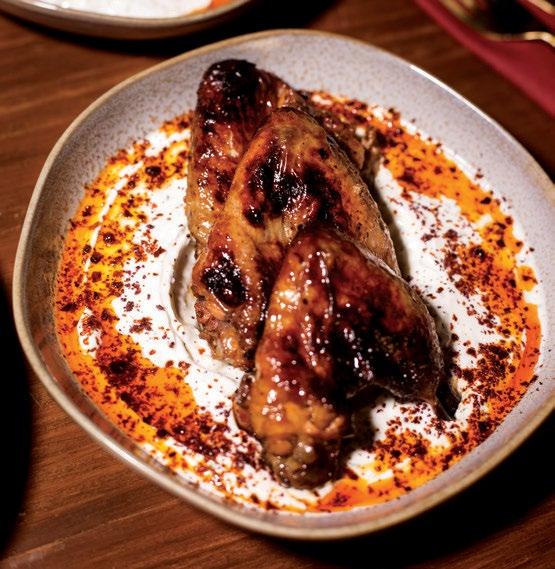
The bar, Mashrub, crafts cocktails using Middle Eastern ingredients. Anar, the signature drink, is an aromatic blend of gin, pomegranate molasses, Fernet Branca, and sweet vermouth—evoking the essence of a Persian bazaar. Zalabia Walk, made with tequila, grapefruit za’atar shrub, Campari, and soda, is bright, herbaceous, and perfectly bitter. “The goal was to create cocktails that don’t just accompany the food but elevate the entire experience.”
The research behind Anar was deeply personal. “Roshni (Kapoor), my co-founder, and I travelled across the Middle East—exploring homes, kitchens, street food joints, and restaurants. Rather than relying on consultants, we trusted our instincts,” says Kataria. “We experimented, tasted endlessly, and refined dishes until they felt just right—authentic in soul, but appealing to the modern Indian diner.”
Anar seeks natural overlaps in flavour—spice, tang, smoke—staying true to the region while making it resonate in India.
CLOCKWISE FROM RIGHT:
The curving roads in the Western Ghats that lead to the twin hill stations; strawberries have become synonymous with a Mahabaleshwar holiday; waterfalls in Mahabaleshwar offer an excellent place to visit for nature lovers and adventure seekers.


The slow allure of Maharashtra’s twin hill stations, Mahabaleshwar and Panchgani, is being repackaged and served up by MTDC. Yet, their enduring appeal lies in its languid pace of life, its colonial, Parsi and spiritual heritage, and its strawberry farms.





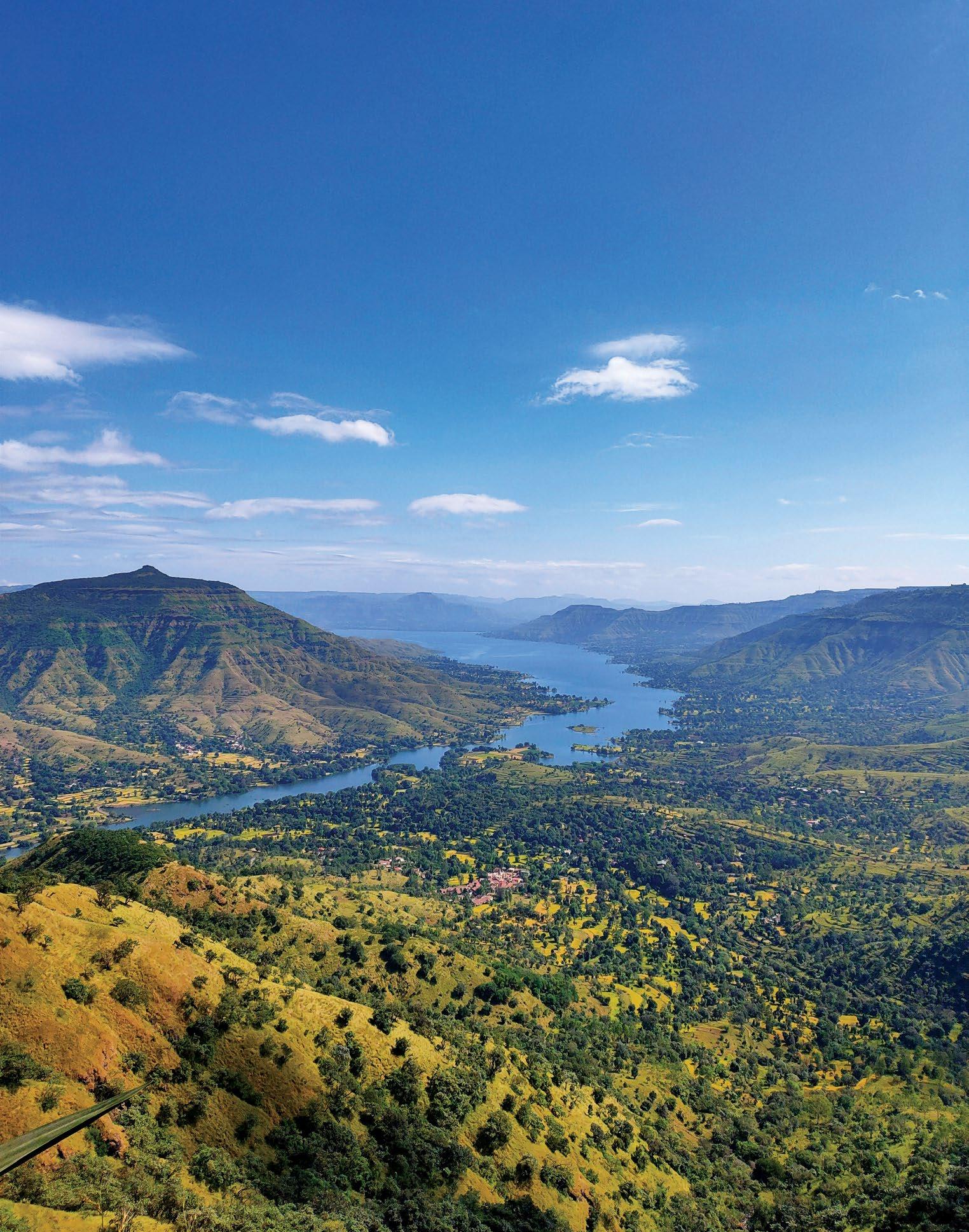
CLOCKWISE FROM TOP LEFT: Venna Lake, constructed in 1842; Mahabaleshwar overlooks the Krishna River which originates near the city; Il Palazzo, one of Panchgani's oldest heritage resorts.
How many hill stations in India still feel like hill stations—a concept introduced by the British, who sought refuge in these cooler climes during summer? Not many, I’d say. Overrun by tourists, many have lost their quaint colonial charm and laidback pace.
In the twin hill stations of Mahabaleshwar and Panchgani, however, the slow life and an oldworld character survive in patches. I visited these towns at the invitation of the Maharashtra Tourism Development Corporation (MTDC) to attend the Maha Paryatan Utsav 2025, for which a tent city had been set up between the two.
The Utsav drew crowds in search of adventure, scenic beauty, cultural experiences, and fun. For
me, it was a chance to rediscover the hill stations of my childhood memories and explore how MTDC is reintroducing them as destinations rich in history, culture, and cuisine.
Accessible by road from Pune and Mumbai, Mahabaleshwar and Panchgani lies in the forested Satara district, near the imposing Pratapgad Fort. Commissioned in the 17th century by Chhatrapati Shivaji Maharaj, this historic hilltop fortress remains a favourite among serious trekkers. My aim, however, was not to go on an arduous climb to the fort, but to explore the charm and potential of the twin hill cities—and understand why MTDC sees them as premier tourism offerings.
Efforts to preserve their heritage are evident. The Sahyadri Trekkers Association regularly cleans up after negligent tourists. Mumbaiites and Punekars who’ve restored colonial homes are working with locals to protect Mahabaleshwar’s natural and historical identity. The beauty of these destinations is that there are no malls, no multiplexes, no huge shopping centres…just villages, cafes, bakeries, and bazaars, known to sell the local crafts and produce,


ABOVE: The second largest mountain plateau in Asia, Tableland, Panchgani, gives you beautiful views of the Krishna Valley.
LEFT: A carved stone cow from whose mouth water flows continuously represents the source of Krishna river at Krishnabai Temple.
like the beautiful shoes they handcraft, the honey produced here or the fruit wine that is made locally. At the Devrai Art Village in Panchgani, the old art of beaten copper craft has been turned into modern artefacts and jewellery.
A vacation here can be as simple and satisfying as strolling through shaded lanes lined with charming homes, browsing local bazaars, and spending leisurely afternoons and evenings in one of the many inviting cafés.
Here’s why, with a spot of thoughtful planning, these towns could become India’s top hill destinations.
Mahabaleshwar’s spiritual significance centres on Lord Shiva, after whom the town is named—Mahabali, the powerful one. The 13th-century Mahabaleshwar Temple houses a self-manifested lingam and is steeped in legend, including tales of the Pandavas visiting the area.
The temple trail includes Panchganga Temple, where five rivers—one of them, as local beliefs go, the mythical Saraswati—are believed to converge. Its open-air structure is now covered by a colonial-era industrial-style canopy. The stone temples in Old Mahabaleshwar date from the 13th to 15th centuries, when it was a major pilgrimage centre. The stunning Krishnabai Temple, dedicated to the river goddess, sits quietly at the origin point of the Krishna River, its black stone floors and carved pillars offering a moment of tranquil beauty away from the commercial bustle.
Historically, the region's strategic hilltop location made it a crucial part of the Maratha Empire under Chattrapati Shivaji Maharaj. The Mahabaleshwar Temple likely served as a religious centre during his reign.
The British—and later, the Parsis—transformed these villages into the summer capital of Bombay Presidency. Heritage bungalows still stand tall, including one owned by Pranlal Bhogilal, a textiles and spice trader better known as India’s pioneering classic car collector and founder of the Vintage and Classic Car Club of India.
Walk through Raj Bhavan with its grand verandas visible from Wilson Point, or explore Babington House with its cross-shaped layout and grand dining hall. The Gothic-style Holy Trinity Church, the colonialera Dina Hotel (once speculated to have belonged to Muhammad Ali Jinnah and named after his daughter, Dina), and many other such sites whisper the stories of the past.
Strawberries, native to Europe and North America, were introduced here in the mid-19th century by the British. Third-generation farmer Rajendra Dhage believes it was an Australian who first planted them,

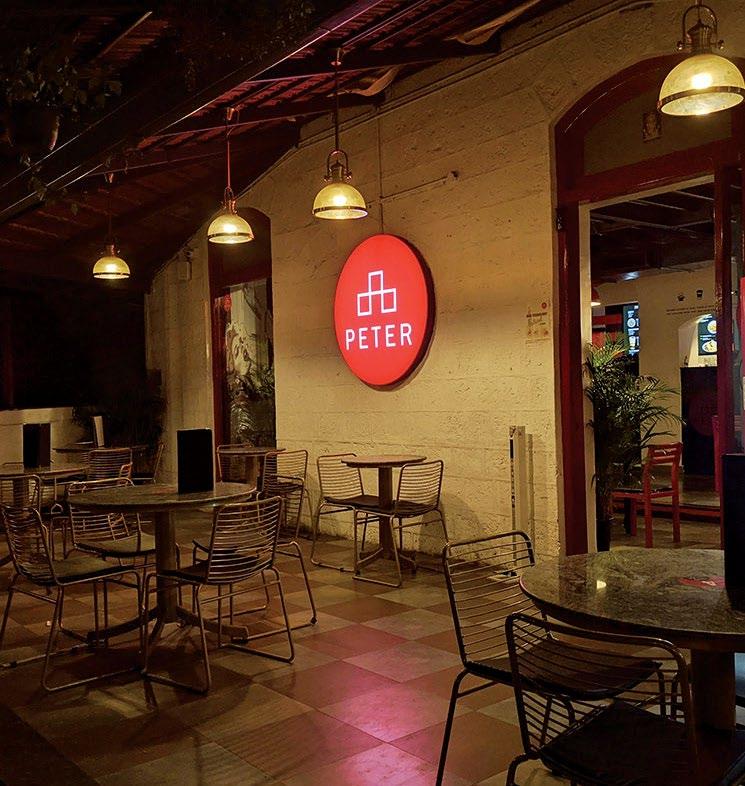

and the variety is known as, well, ‘Australia’. The berries eventually took root in the local soil—cool, acidic, and well-drained—and thrived. Now, some 80 varieties are cultivated here, with mother plants imported from abroad. Strawberry farming blankets the region. Visitors can walk through farms, pick fresh berries, and indulge in strawberry and cream at one of the many charming cafés.
Mahabaleshwar and Panchgani are home to some of the cosiest cafés and bakeries, a few dating back over a century. In Mahabaleshwar’s Main Market is Elsie’s Dairy and Bakery, a local institution since 1849, beloved for its truffle cake, carrot cake, and mushroom patties. Bagicha Corner on the Mahabaleshwar–Panchgani Road is a local favourite for strawberry and cream. Café Peter, a vegetarian café with a ‘mindful’ menu, was a personal favourite for its Japanese curry rice, lemon ginger tea, and pizzas. Lucky Restaurant and Bakery brings an oldworld Irani café charm to the mix.
The ‘points’—lookouts with dramatic views—were named and popularised by the British. Kate’s Point, named after the daughter of Governor Sir John Malcolm, overlooks Krishna Valley. Sydney Point, named after Sir Sidney Beckwith, offers views of the

Pandavgad and Mandhardeo ranges. Wilson Point, the sunrise spot, sits at 1,435 metres. Arthur’s Seat offers views of Konkan Valley and Savitri River. Parsi Point pays homage to the community that summered here. Today, the twin towns are also known for adventure tourism, with trekking, paragliding, and paramotoring activities promoted by MTDC to attract younger travellers seeking more than heritage alone.

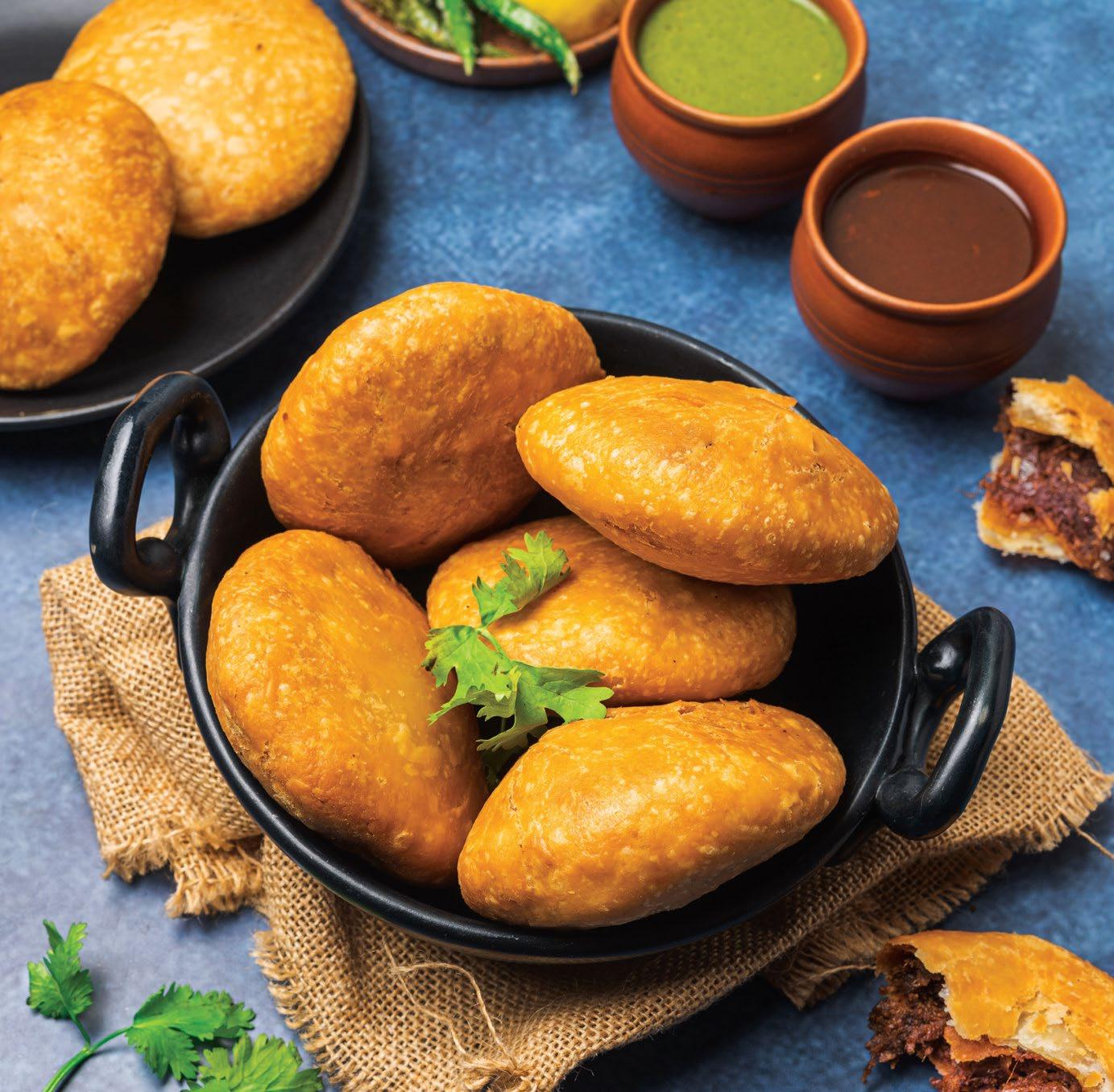




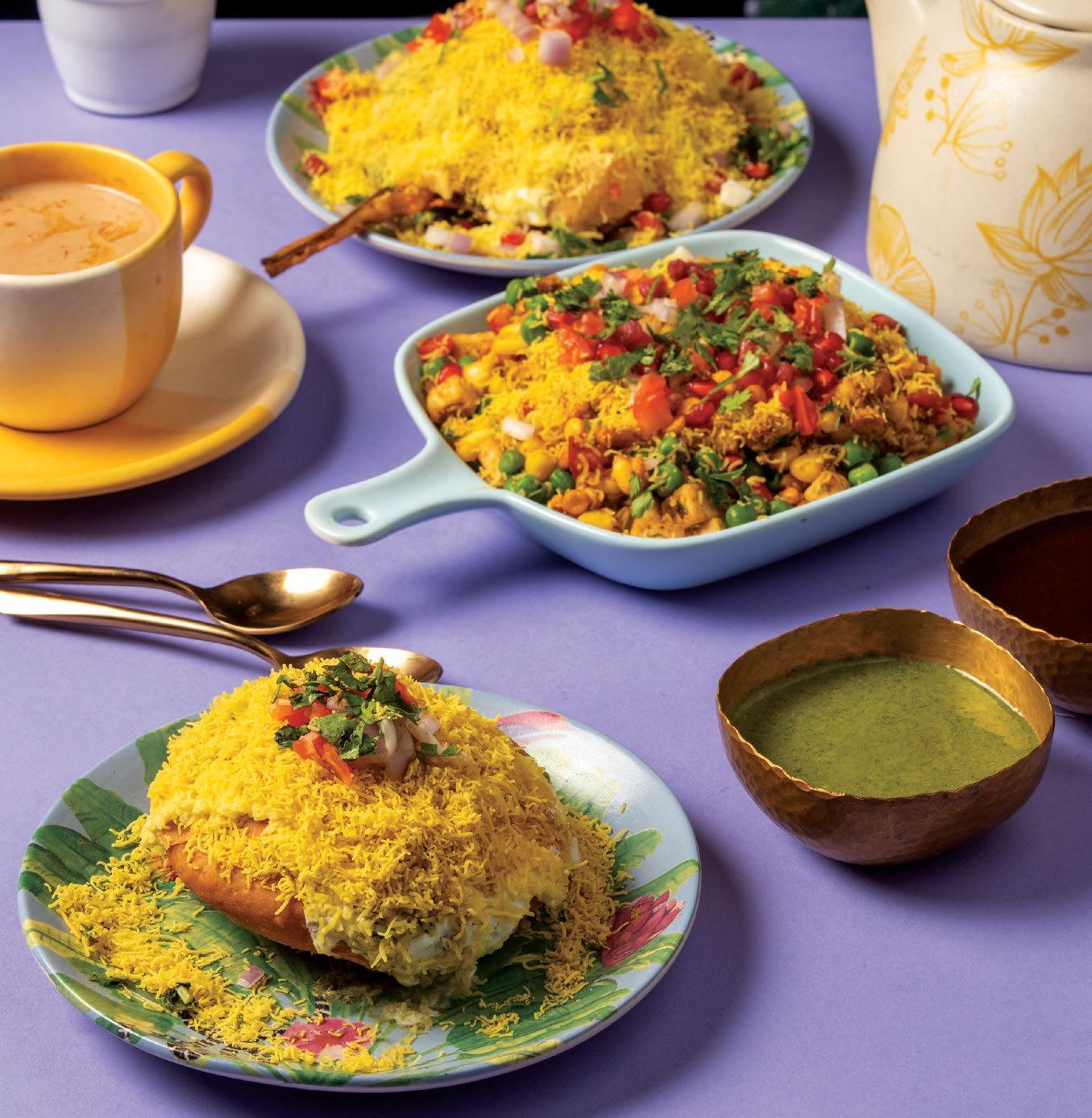
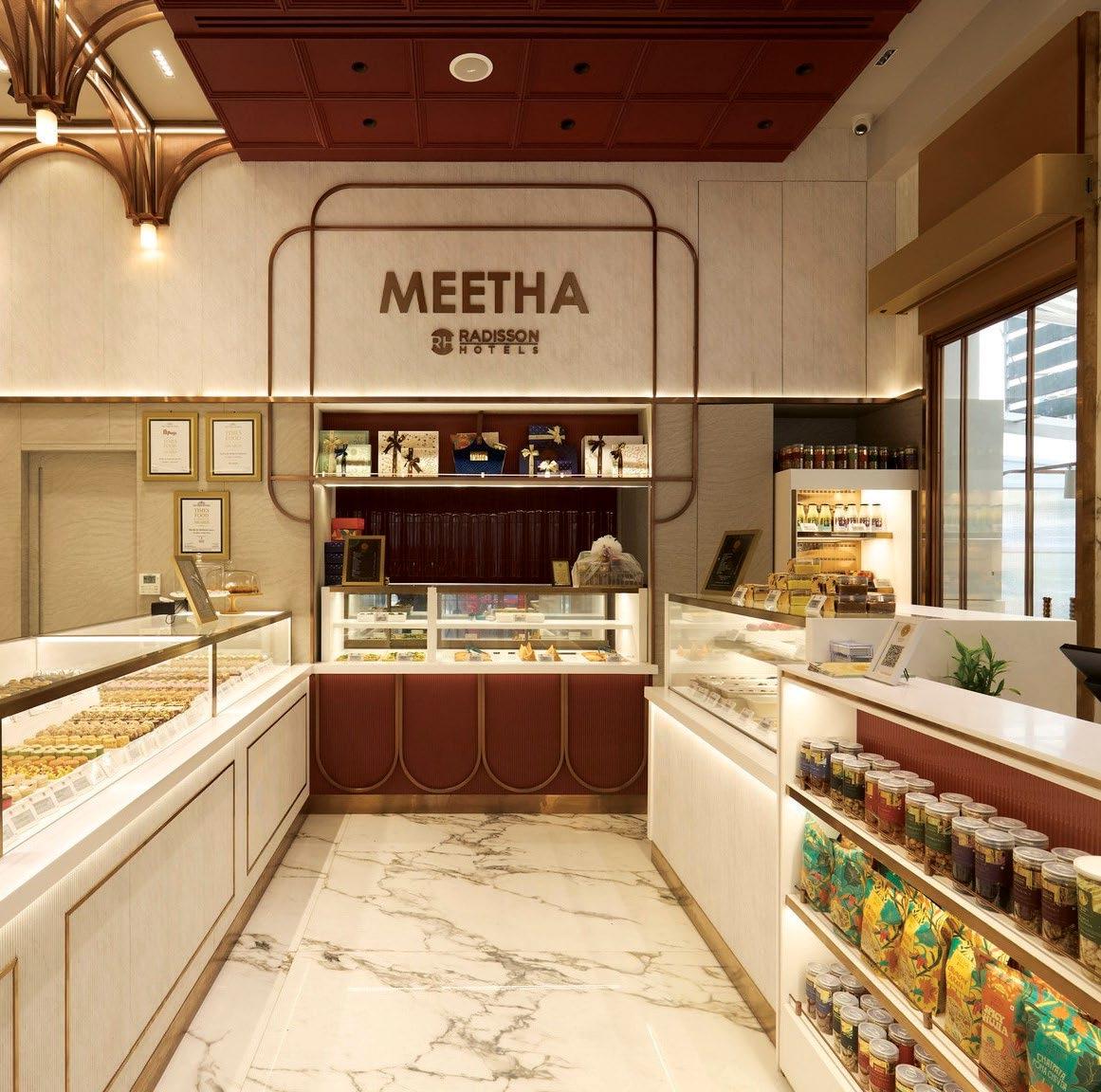
A new generation is reimagining India’s mithai legacy with innovation, aesthetics, and scale. Leading the endeavour is Meetha by Radisson—a premium brand blending tradition with hospitality finesse.
India’s halwaiwalas are as old as the tradition of mithai itself —keepers of recipes passed down through generations and artisans of sweets that have marked every celebration, festival, and moment of joy. The concept of sweets—or mithai (from the Sanskrit mithas, meaning sweet)—is deeply embedded in Indian culture. Ancient Sanskrit texts like the Rigveda (c. 1500–1200 BCE) mention sweets such as apūpa, a barley cake fried in ghee and dipped in honey, resembling the modern malpua.
Since then, decadent mithai, meetha, and halwais (sweetmakers) have remained an enduring legacy of India’s culinary landscape. While traditional halwais and mithaiwalas still hold sway from their time-honoured shops, a new generation of artisanal mithaiwalas is sweetening our lives in fresh ways. Their offerings go beyond beautifully packaged mithai and wide distribution networks—there’s an embrace of experimentation and the use of machines in mithai-making.
What stands out about a brand like Meetha is its backing by Radisson Hotels. India’s dessert scene, driven by premiumisation, innovation, and strong gifting culture, is valued at approximately ₹1 lakh crore and growing at 25% annually.
Meetha by Radisson fits this trend perfectly— arguably even pioneering it. Launched by Radisson Hotel Group, South Asia, Meetha is a premium mithai brand focused on both traditional and innovative sweets. Backed by Radisson’s hospitality expertise, it maintains high hygiene and quality standards. It began in Delhi-NCR in 2020 and expanded to Mumbai, with further plans for Bengaluru, Hyderabad, Guwahati, and more cities.
In Mumbai, the concept debuted at Radisson Goregaon, now managed by an all-women team. The entire Mumbai circuit and Maharashtra are now serviced from a central kitchen in Goregaon, run by the Balwa Group, which owns Radisson Goregaon and Fairfield by Marriott International Airport.

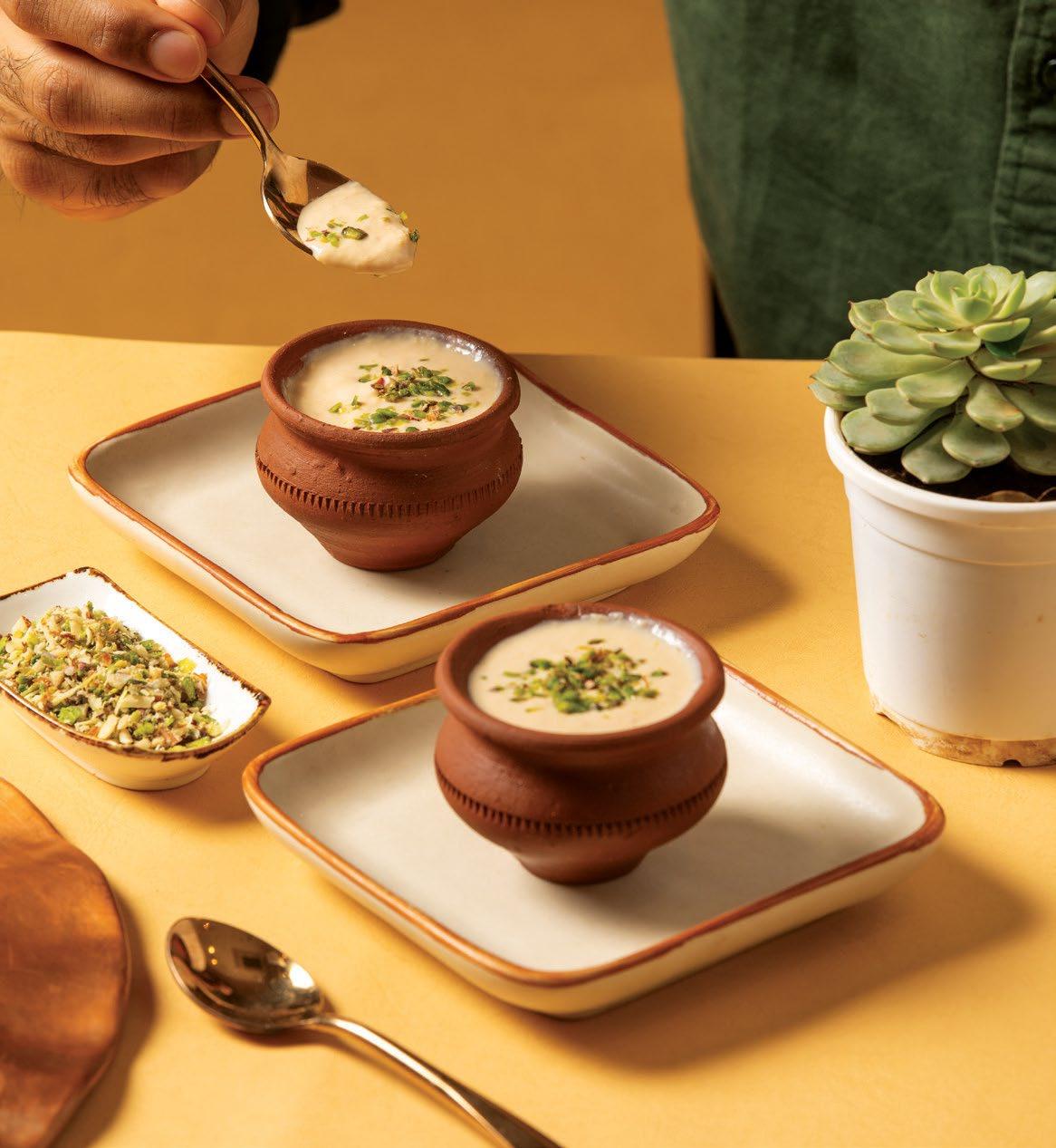
“Typically, hotels only have bakeries and pastry shops. So when this concept of selling mithai came up, we thought it was a brilliant idea. Indians love mithai—so why not have that in hotels too, as a proper product line?” says Ajoy Balkrishna, Vice President, Balwa Group. “The Balwas, who comes from a long line of restaurateurs, really believed in the concept. When it came to us, we took it seriously and opened the first Meetha shop in Radisson Goregaon, starting with a small kitchen.”
As demand grew and the Balwa Group realised people preferred buying mithai from a more artisanal brand over small local shops, they began expanding Meetha’s footprint in the city. “Radisson wants to scale it across the country. While it hasn’t expanded exponentially yet, it’s growing steadily,” says Ajoy Balkrishna.
Mumbai currently has four Meetha stores, all owned by the Balwa Group, with outlets in South Mumbai and Thane in the pipeline. The central factory also supplies the sweets and desserts to Meetha outlets across the western region, which are managed by other Radisson.
The first Meetha opened at Radisson Goregaon, and as demand surged, the Balwa Group set up a 14,000 sq. ft. central kitchen near the hotel. “We started the factory just a year and a half ago. Before that, we had a small kitchen catering to just one outlet,” says Balkrishna. “But during Diwali and other festivals, demand increases tenfold. For regular operations, the small kitchen was fine. But in India, there are festivals almost year-round—Diwali, Holi, Ram Navami, Dussehra—each with its special mithai. Because of that year-round demand, we realised we needed to scale up. Radisson gave us the mandate for the western region. So we are now the sole suppliers for their properties in this part of the country.”
Tucked away in a lane off the main road, the factory is equipped with top-of-the-line equipment. Many mithai-making processes have been automated, making several steps almost hands-free. “Of course, you can’t make Indian mithai entirely without human involvement,” says Chef Raghavendra Singh, the master halwai who steers the Meetha brand in Mumbai. Motichoor ladoos are lovingly hand-rolled by women working in the factory, while halwais often temper and reduce the khoya by hand using huge ladles, rather than relying solely on machines.
And yet, machines now cut and shape mithais—and in the case of kaju katli, even layer them with silver varq—making the process not just easier but faster. “A lot of prep work is now semi-automated,” says Chef Singh.
The idea and concept were developed by Chef Rakesh Sethi, Radisson’s corporate chef. When the brand launched, he was instrumental in creating 12 to 14 mithais that could be made using automation.
“Now, we roll out 100 varieties of mithais across a vast spectrum from all over the country, catering to every festival from Eid to Diwali, besides a range of savouries,” says Chef Singh. The core menu is consistent across all stores, especially since most orders come online—via Zomato and Swiggy. “That said, we do change items seasonally. For example, in winter, we use more ghee. We also offer fusion mithais, which is our strength—since we have both a hotel bakery and a mithai shop. It gives us creative flexibility that a regular mithai shop may not have,” says Chef Singh.
Among the experiments by Chef Sethi and his team are Motichoor Cheesecake (a cheesecake infused with the sweet warmth of motichoor), Gulkand Gulab Jamun, Kesar Pista Gulab Jamun, Mango Angoori Rabdi, and Biscoff Kalakand (a Biscoff-flavoured, reduced khoya sweet with a grainy texture), along with vegan and sugar-free options.
The Goregaon outlet, with a separate entrance from the hotel (so you don’t need to enter the property to access the shop), has the ambience of a café: a few loungy, comfortable chairs to sit and enjoy a treat, mithais displayed behind glass counters like they are in a bakery, soft lighting, and a showcase of their elegant packaging.
Packaging is a large part of the Meetha gameplan— sleek and modern, yet traditional enough to feature Indian motifs that link back to our cultural roots, which mithai so deeply represents.
A dedicated kitchen at Radisson Goregaon also crafts the mithais, and guests are often invited to explore it.
“We use really good ingredients. If you don’t use good ingredients, you won’t get a good product—it’s as simple as that,” says Santosh Singh, the general manager of the hotel. “Even our mithai isn’t overly sweet, unlike the typical ones that are loaded with sugar. So you don’t have to feel guilty eating them. The shop complements the other F&B offerings at the hotel.”
Winner of several awards, Meetha caters to individual buyers while positioning itself as a luxury product—particularly with its new minimal packaging, aligned with the premiumisation of the space. Its focus on quality, hygiene, and unique initiatives like women-led outlets firmly place it in the premium segment.



LEFT: Onion Samosa BELOW CLOCKWISE: Mango Rasgulla; Angoori Chocotine brings together grapes and chocolates; sophisticated packaging is among Meetha by Radisson’s strengths as it appeals to an urban, younger audience.
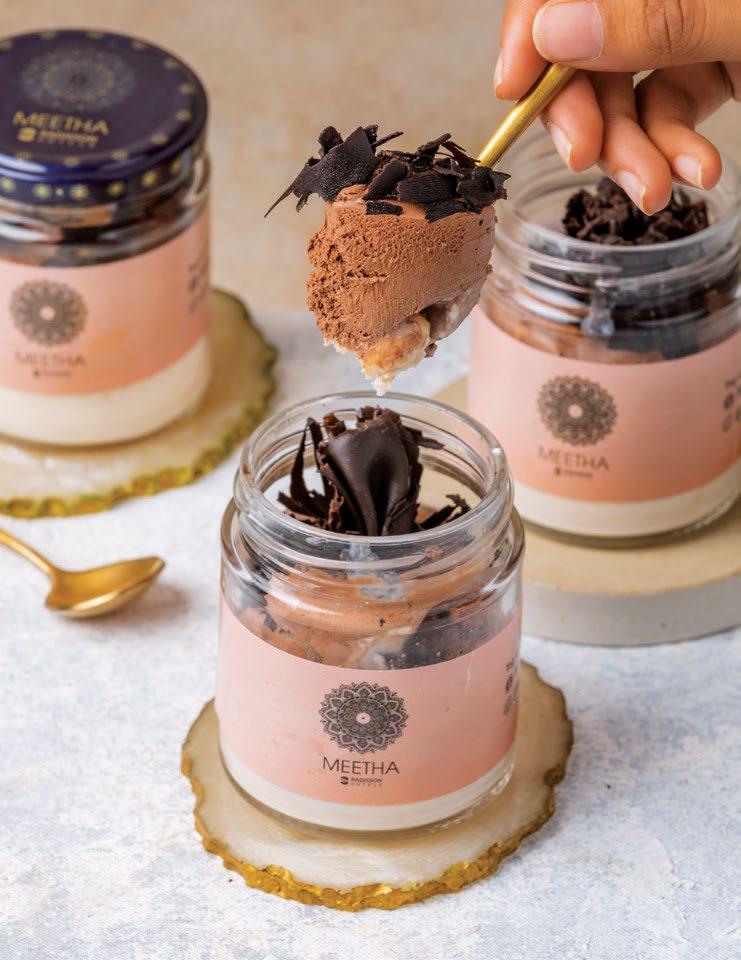
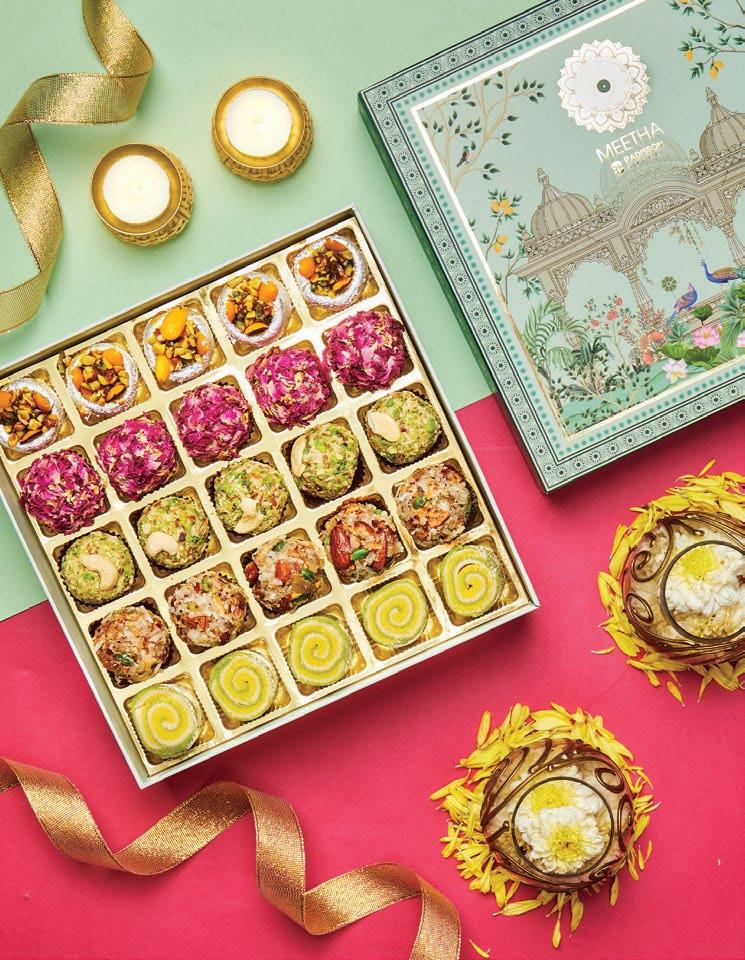
When fire is the language and flavour of the medium, few stages are as visceral— or as venerated—as Tasmania’s Dark Mofo. This winter, Mumbai’s chef Niyati Rao became the first Indian invited to join its primal feast.

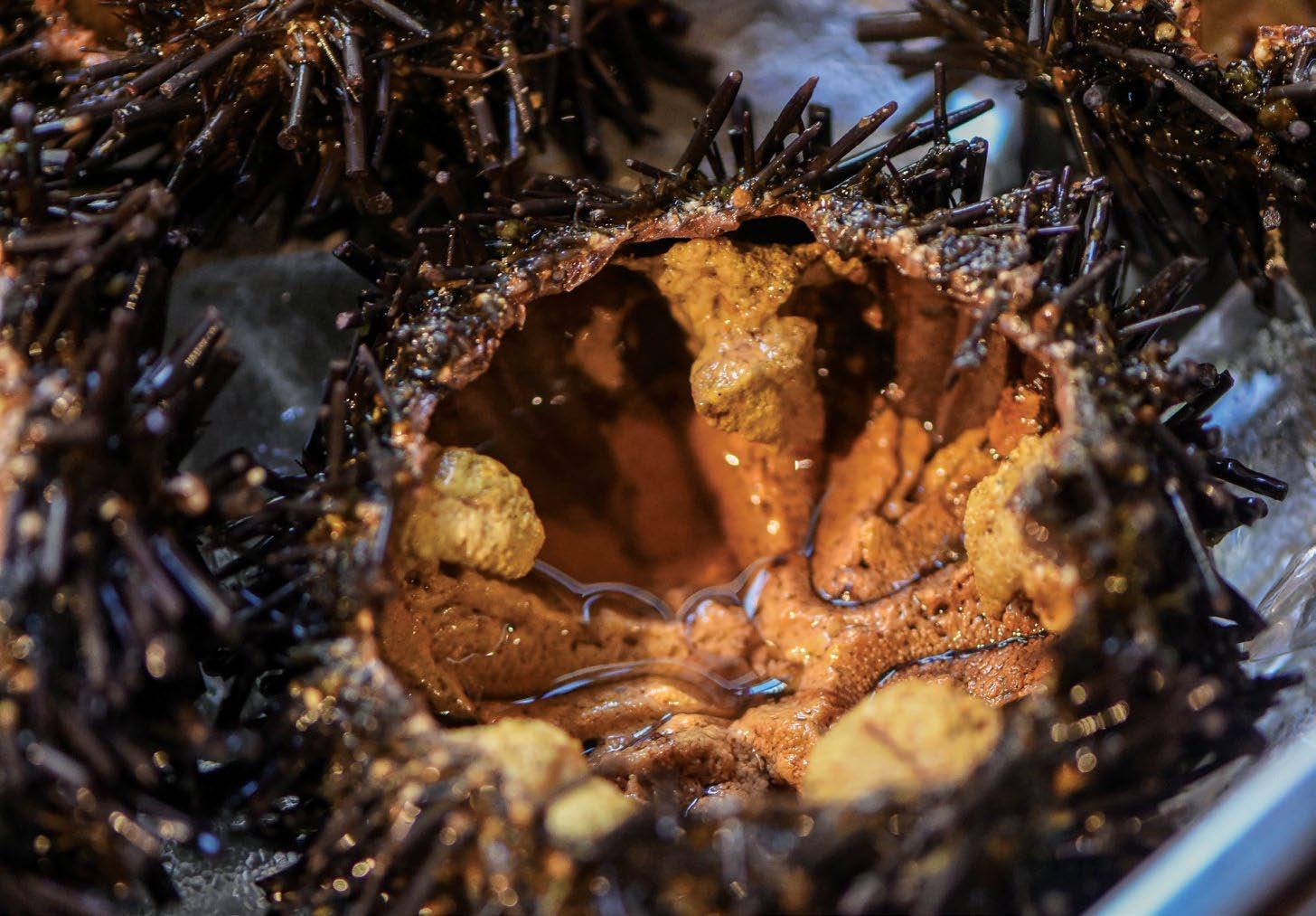
ABOVE: Chef Niyati Rao is known for her ingredient-driven, no-rules approach to cooking.
LEFT: The sea urchin bisque, inspired by Rao's mother’s monsoon crab curry.
When chef Niyati Rao was invited to represent India at Tasmania’s renowned Dark Mofo 2025 festival as the only Indian chosen, she embraced it as a rare opportunity to showcase Indian culinary artistry on a stage that resonates far beyond food. “It was an absolute honour,” Rao reflects. “Dark Mofo isn’t just a festival— it’s where art, music, culture, and food converge in a primal celebration of winter’s dark rituals. The cooking is elemental, open-fire, and raw, hearkening back to humanity’s earliest culinary expressions.”
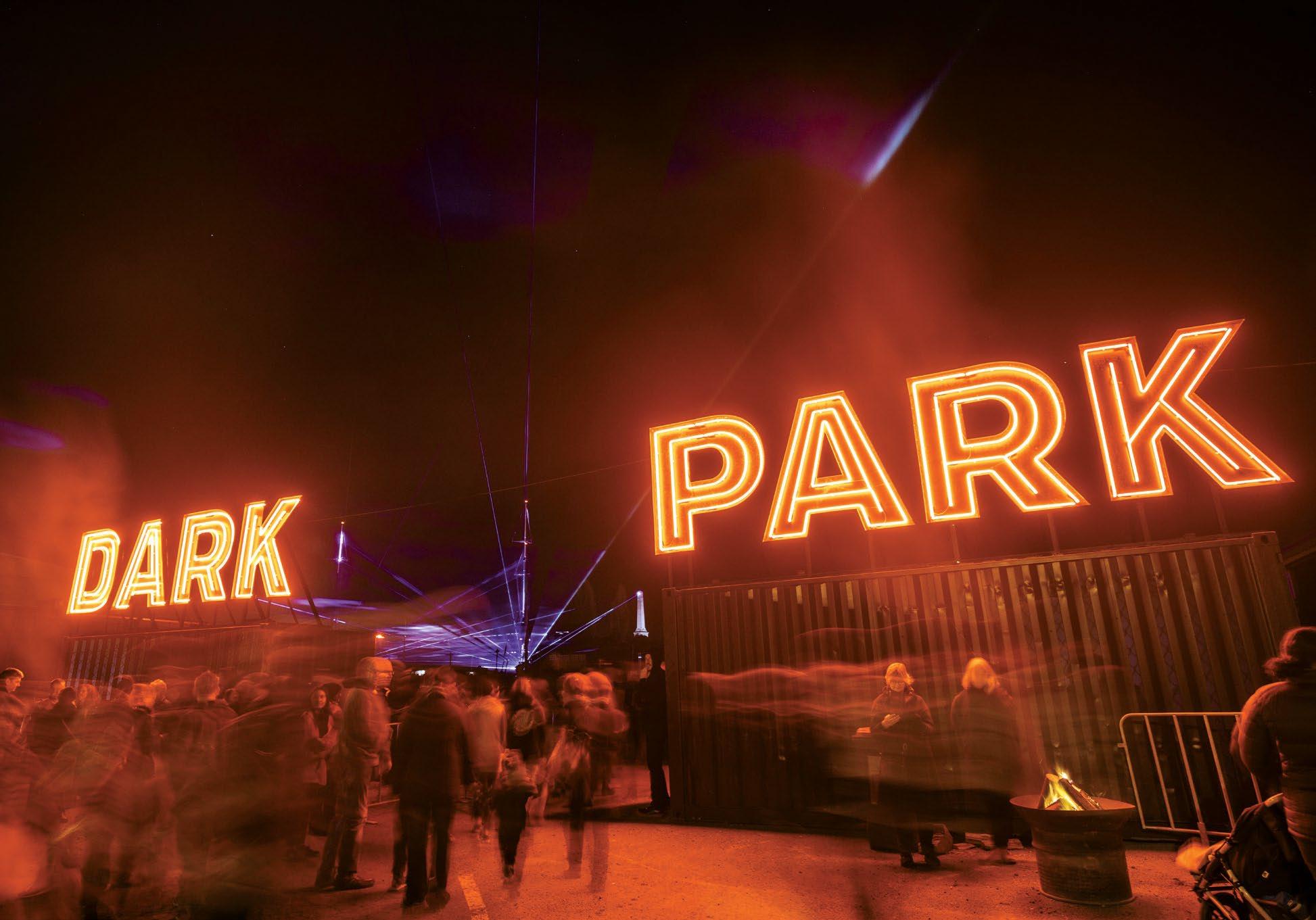
The collaboration with Stillwater, one of Tasmania’s premier restaurants, was orchestrated with an understanding that this fusion of local terroir and Indian boldness would be a perfect match. “Chef Craig and Stillwater are ideal partners. Their deep respect for Tasmanian ingredients aligns beautifully with our ingredient-centric ethos at my fine dining restaurant Ekaa, in Mumbai.”
From Mumbai’s urban pulse to Lutruwita’s wild larder
Tasmania, or Lutruwita in the language of its indigenous people, offered a fresh and untamed canvas for Rao’s culinary exploration. “Coming
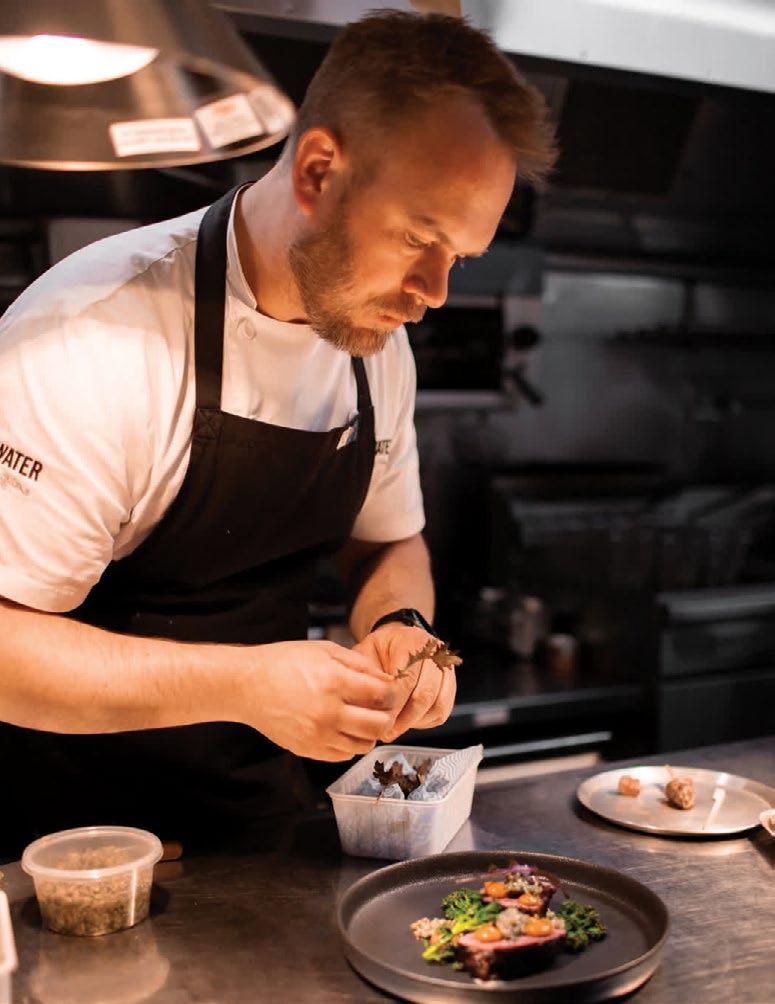
from Mumbai, where sourcing diverse ingredients is a passion and necessity, Tasmania was a new and exciting playground,” she says. “What fascinated me most were the native bush foods—pepperberry, wattleseed, quandongs—ingredients with stories and flavours waiting to be discovered.”
Rao’s excitement is palpable as she speaks of Palawa Kipli’s traditional food walks, where native ingredients and ancestral cooking techniques are celebrated. “I’m especially eager to work with yula (also called) the mutton bird. It’s a bold ingredient that perfectly suits the festival’s primal spirit.”
The winter feast menu reads like an incantation— wallaby wings, sea urchin broth, whisky-pandan pudding—each dish a narrative woven from the threads of tradition, terroir, and innovation. Rao elaborates, “Dark Mofo is about invoking the primal: death, rebirth, instinct, and desire. Our cooking method had to reflect that. Open fire is the most primal technique. It connects us viscerally with nature, with history.”
Her dishes embody this philosophy: “The sea urchin bisque, inspired by my mother’s rainy season crab curry, marries delicacy and power. It’s spiced with a secret blend, paired with bread roasted over embers—a homage to both my heritage and the wild Tasmanian landscape.”

Blending India’s intense flavours with Tasmania’s unique produce was both a challenge and an opportunity for Rao. “We spent months researching, trialling, and pairing. Tasmanian ingredients such as pepperberry share surprising affinities with Indian counterparts such as Nagaland’s mountain pepper,” she explains. “Thanks to Chef Craig’s expertise, we navigated unfamiliar ingredients with precision. It was a rare moment when everything clicked early in the process, which, as a chef, is nothing short of a miracle.”
This synergy, Rao notes, springs from shared boldness. “Both Indian and Tasmanian ingredients have strong characters, which made the fusion natural rather than forced.”
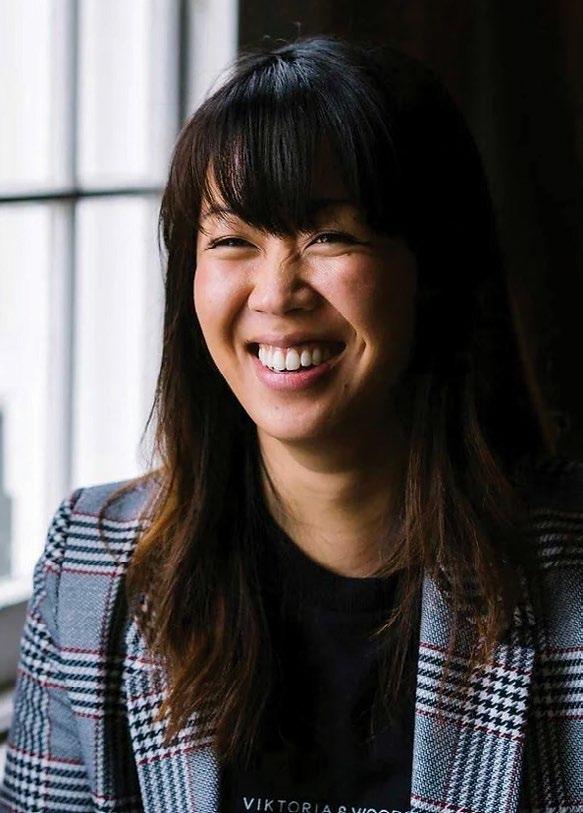
Rao’s extensive experience at global culinary institutions like Noma and Wasabi by Morimoto informs her approach to this elemental feast. “Openfire cooking demands an almost mystical intuition— you have to ‘talk’ to the fire,” she says. “At Wasabi and Noma, I developed a deep respect for this primal craft. Fire imparts a flavour and texture no modern appliance can replicate.”
For Rao, the festival’s communal fires evoke a deeper human connection. “It’s about gathering around warmth and sustenance in winter’s chill — a timeless ritual that feeds body and soul.”
Beyond the culinary innovation, Rao sees her participation as a vital act of cultural representation. “To be the voice of India at Dark Mofo is profoundly humbling. Indian cuisine is vast and varied, yet its
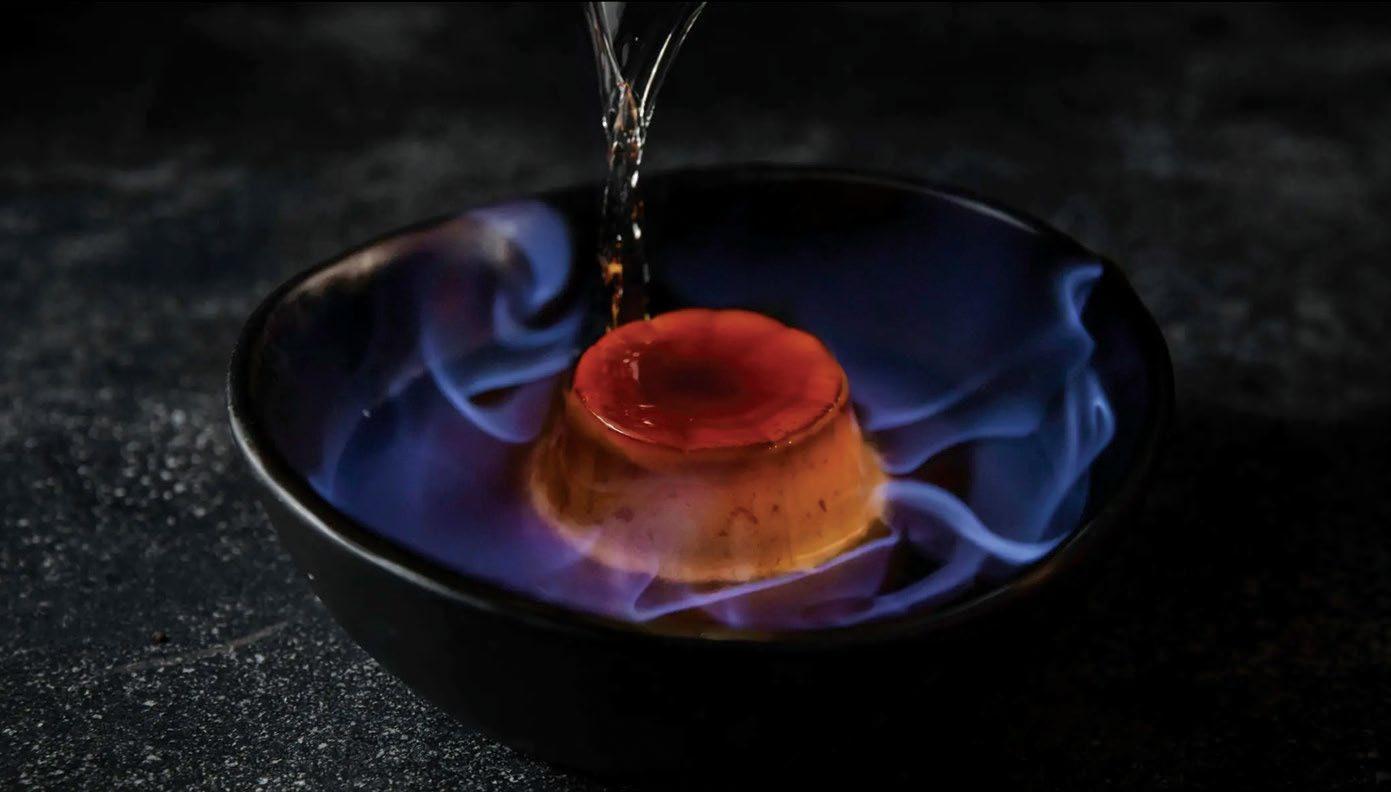
micro-cuisines and indigenous ingredients remain largely undiscovered globally. This festival is a platform to showcase India’s culinary depth and to highlight how Indian flavours can harmonise with other terroirs in vibrant, unexpected ways.”

Asked what she hopes guests will carry away from the Winter Feast, Rao smiles, “Pure, unadulterated joy. Food is the ultimate connector—transcending language, culture, and distance. When Indian boldness meets Tasmanian wildness over an open flame, the experience becomes more than a meal. It’s a celebration of life’s elemental pleasures.”

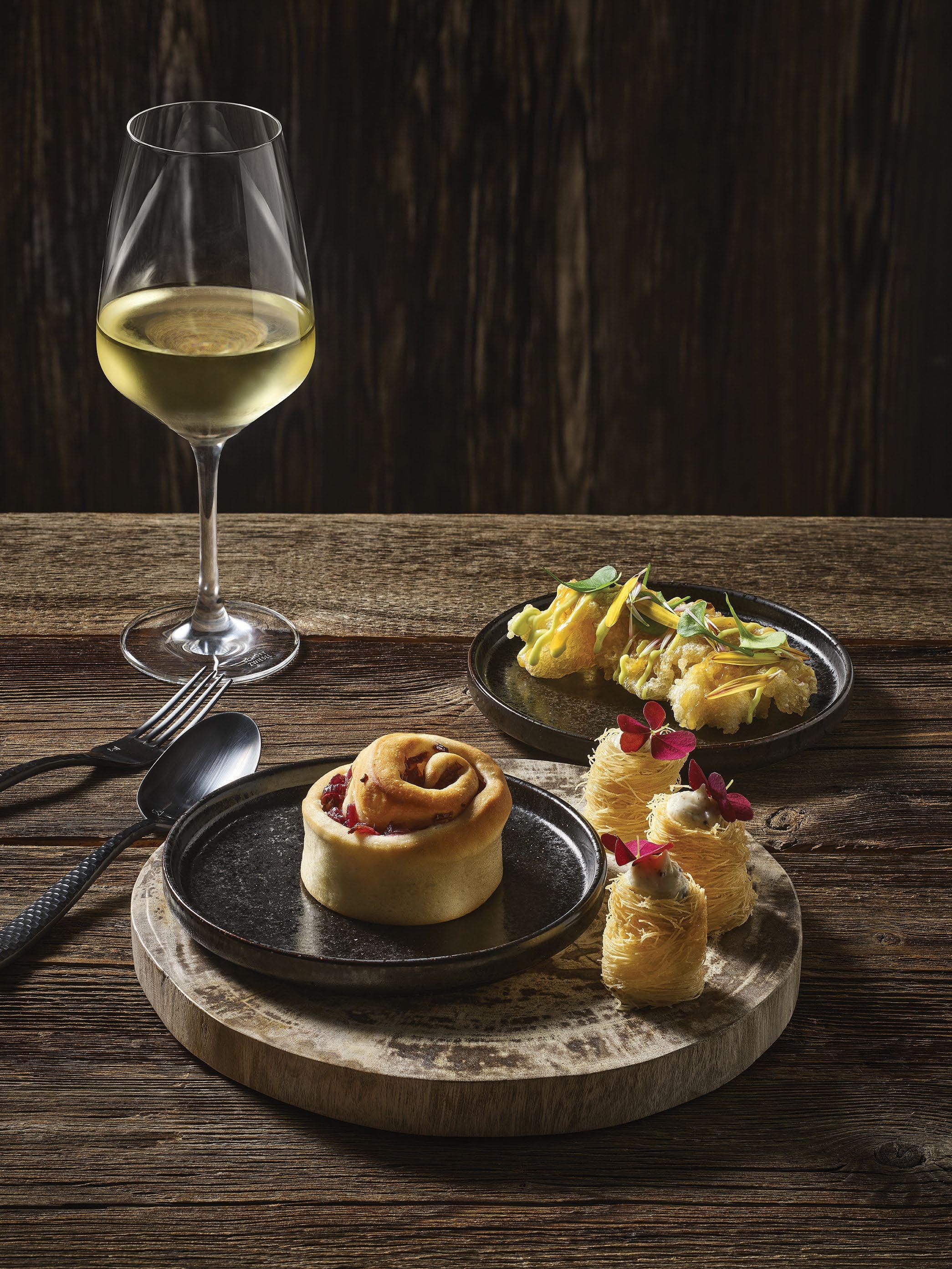
Reimagined to match modern tastes and capitalise on its unparalleled location, XO & Mì at Le Meridien is a case study of how thoughtful design, market-driven menus, and storytelling through space can reposition a legacy restaurant for contemporary relevance and standout appeal in a crowded market.
SUMAN TARAFDAR
Which restaurant offers an unparalleled view of Lutyens’ Delhi? One that stretches from India Gate to the old and new Parliament buildings, the National Museum, National Archives, and iconic institutions that shaped modern India—Krishi Bhavan, Udyog Bhavan, Nirman Bhavan, Vayu Sena Bhavan— and, of course, the North and South Blocks, flanking the majestic Rashtrapati Bhawan, often rising through a veil of mist or, well, the city's now charateristic smog that only enhances its ethereal presence.
Turn another way and the distinctive skyline of the city’s CBD towers comes into view. Shift your gaze again, and the outlines of old Delhi’s historic monuments appear in the distance. Beyond India Gate, you might spot the National Stadium, Jawaharlal Nehru Stadium, Humayun’s Tomb, and the landmark high-rises of south-central Delhi. Remarkably, all of this seems to emerge from a planned ‘forest’—a green cover envisioned nearly a century ago, now offering a sweeping, leafy canvas.
Think vast tree canopies interspersed with structures that embody the historical, administrative, and cultural heart of contemporary India.

XO & Mì @ Le Belvédère at Delhi’s Le Meridien undoubtedly offers excellent dining, but the views are in themselves just as big an attraction. While Le Belvédère has been a longstanding much-favoured culinary destination, it has just been renovated. In its new avatar, the restaurant embodies a far more casual vibe, embracing a look where minimalism meets richness, soothing pastel tones complimenting the spectacular views.
XO & Mì, named after the Chinese seafood sauce and Vietnamese noodles, serves pan-Asian cuisine. Think of the usual suspects—Japanese, Thai, Korean, Singaporean, Chinese and Vietnamese. In a significant departure from its earlier avatar, the


focus is on Asian street food and the lightness and playfulness of the food. Note the muted earthy tones, soft neutrals, deep charcoals, and touches of gold that convey understated opulence. The interiors feature a neutral palette where hand-finished wood, textured ceramics, and subtle stone surfaces complement each other for a stunning first impression. Modern Asian artworks celebrate the region’s heritage through a contemporary gaze.
“This is one of the most spectacular locations for a restaurant in the city if not the country,” points out Meena Bhatia, Vice President & General Manager, Le Meridien New Delhi. “We wanted to reimagine the restaurant to today's palette and time. Even though
there are many Pan Asian restaurants in the city, we opted for it as the cuisine is very close to the Indian palate,” says Bhatia. “We wanted to make it a little bit more playful. It offers classic dishes that you would not want to miss when you visit these countries.”
The 80-cover restaurant is located on the southern side of the hotel, itself an early trendsetter by its use of chocolate and dark shades for its glass façade. Which, for those in the know, means direct views of the sites of federal ministry buildings, including the new ones.
The hotel, established nearly four decades ago, brought on Secret Ingredient, a food and kitchen consulting firm. Beginning with in-depth internal research and a feasibility study, the team conducted a

deep dive into the target audience, local demographics, and market trends. This strategic groundwork shaped a distinctive restaurant identity—one that captures the vibrant spirit of Asia’s street food culture, refined with a modern, sophisticated edge.
“At Secret Ingredient, our mission is to help brands tell their stories through exceptional dining experiences—and XO & Mi reflects that,” says Sid Mathur, founder of Secret Ingredient. “Every detail, from concept to execution, was thoughtfully crafted to deliver a memorable culinary journey. We collaborated closely with designers to shape everything from interior mood boards to brand touchpoints, ensuring each element contributed to the immersive experience.”
The menu captures the essence of the featured cuisines by offering their highlights—think Yuzu Tom Kha, Laksa Prawn Wonton, Greens Gomae, Tamarind Prawn & Glass Noodles, and Sichuan Pulled Chicken. While the number of vegetarian dishes exceeds what you'd typically find on actual street corners in those countries, it thoughtfully caters to Indian preferences.
Cold Plates offer inventive picks like Watermelon & Mint Crudo and Thai Chilli Guacamole, alongside familiar favourites like Tuna Tataki. In hot plates, Tom Yum Edamame and Gochujang Cauliflower with green apple salsa stand out, as does the Okonomi Prawn Toast.
Japan’s best-known export—sushi—features a vibrant range: from the creamy Avocado Dragon Roll with shichimi to the fiery Torched Tuna Hot Hot with charred jalapeños. Also notable are the Hurricane Salmon Roll and Rock Shrimp Tempura. At the heart of XO & Mì’s theatre is the Robata grill, delivering flamekissed skewers like Charred Chicken Satay, Panang Grilled Prawns, Bulgogi Grilled NZ Lamb Chops, and Lemon Miso Broccoli.
Adding a touch of street-style flair is the live dim sum trolley, serving favourites such as Shiitake & Water Chestnut, Asparagus & Cream Cheese, Chicken Shanghai Soup Dumplings, and Roasted Garlic Pork Shrimp Sui Mai. Meanwhile, the katsu and tempura section delivers Japanese comfort with dishes like Tonkatsu Pork Cutlet with Japanese BBQ sauce and the Tempura Basket, a light, crunchy mix of prawn, calamari, and vegetables—each bite layered with crunch, creamy sauces, and balanced seasoning. Celebrating the Cantonese philosophy of ‘breath
Muted earthy tones, soft neutrals, deep charcoals, and touches of gold convey understated opulence.
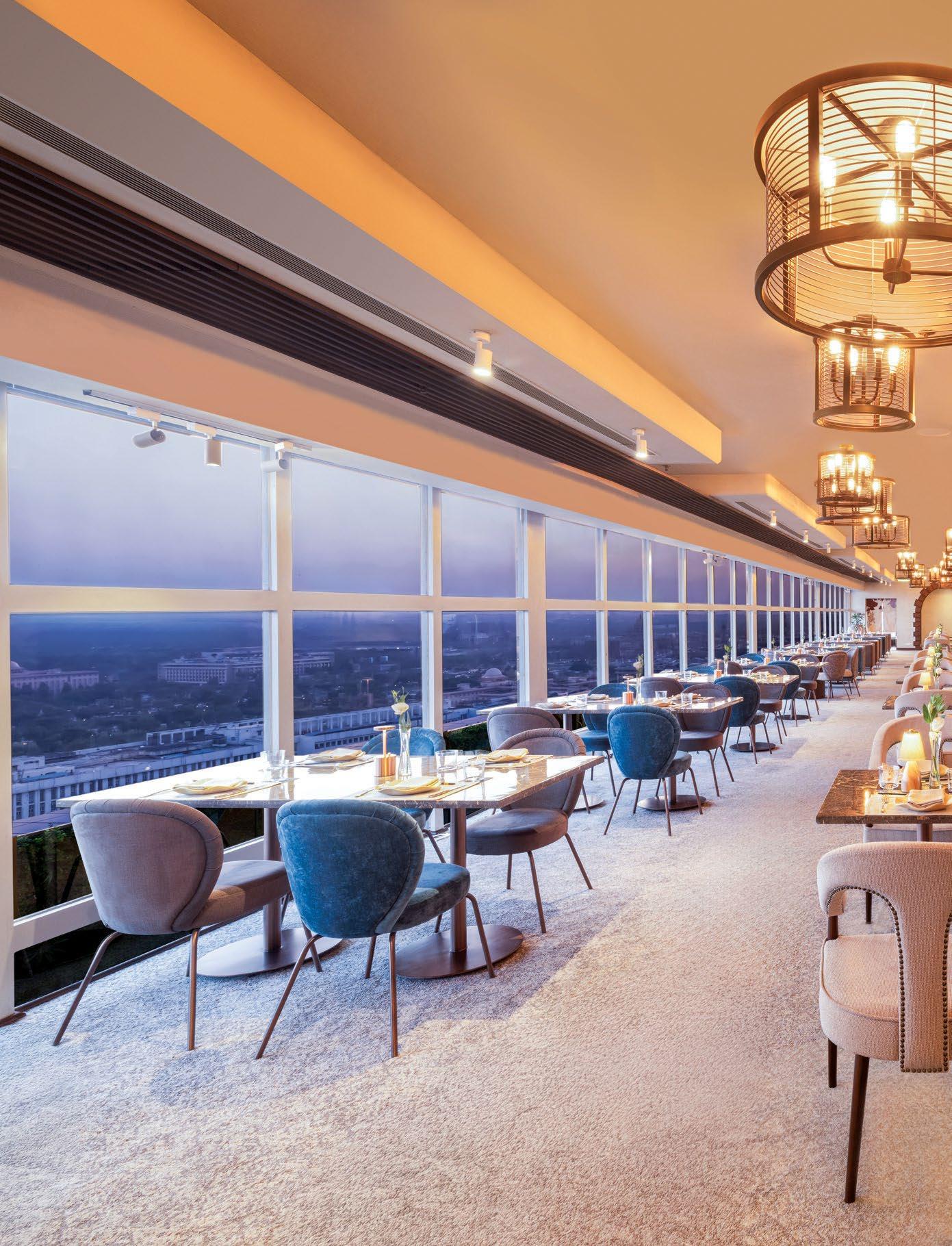
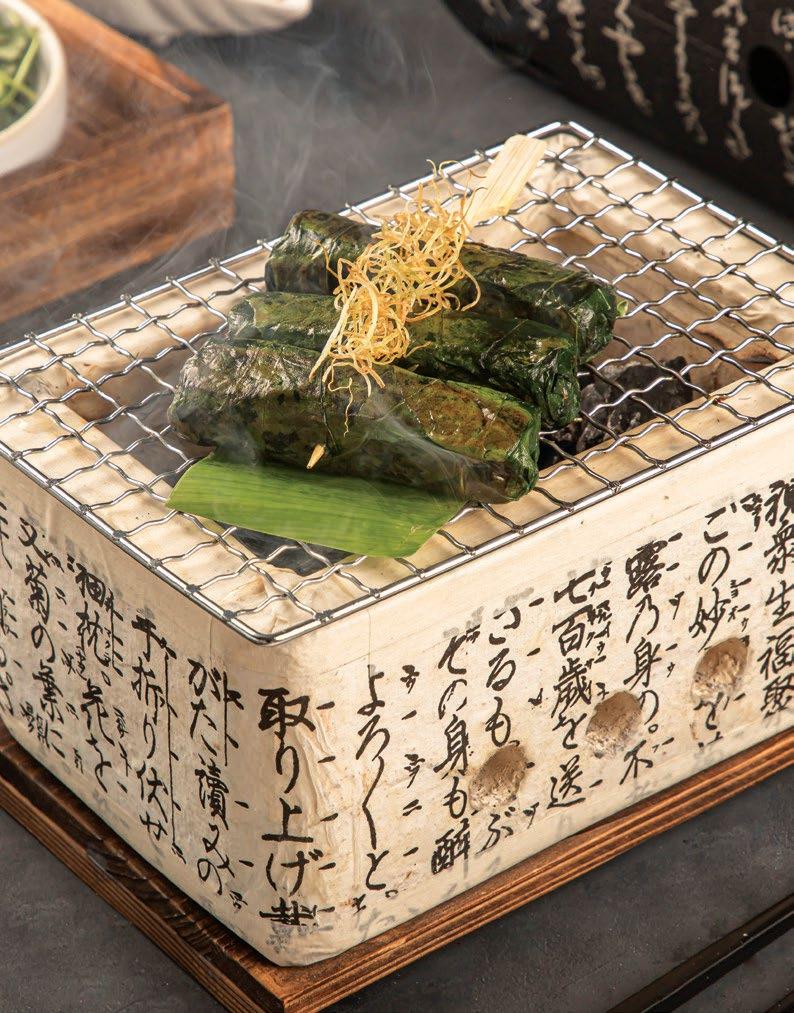
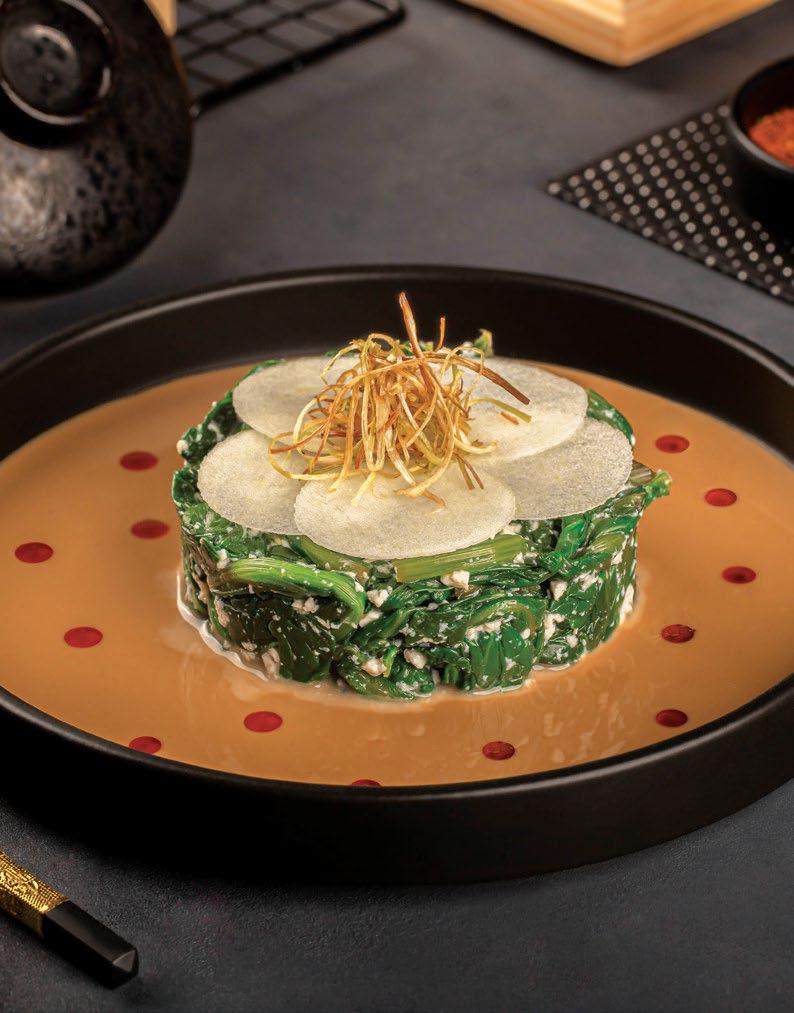



of the wok,’ the Wok Hei section delivers bold, smoky, umami-rich stir-fries. Standouts include the fiery Firecracker Kung Pao, Pad Kra Pao with minced chicken and holy basil, Five Spice Duck, and Hong Kong Chilli Lamb. The curry section features Red and Green Thai Curries, Lamb Massaman Curry, and Claypot Adobo.
While indulgence is inevitable, don’t skip the range of Asian-style desserts. Highlights include the Miso Caramel Chocolate Fondant with roasted almond ice cream, Coconut Panna Cotta with a lemongrass soak, and the Hot Honey Shibuya Toast. For a decadent finish, the Vietnamese Coffee Tres Leches layers coffee jelly with Kahlua milk syrup.
The beverage section is equally ambitious. The ‘Legends of the Orient’ cocktail collection offers signature mixes inspired by Asian folklore and flavours—each crafted with house infusions, exotic botanicals, and regional ingredients. The Sake Bar showcases a premium selection of Japan’s finest, from delicate junmai to bold daiginjo, alongside Korean soju and Japanese whiskies. Tucked to the side is The Permit Room—a cosy nook with more breathtaking views, this time toward the east and northeast.
A tip. While every table offers spectacular views, to catch the best contours of the Rashtrapati Bhavan, opt for the PDR. The superb flavours at XO & Mì are of course on offer wherever you opt to seat yourself.


India’s cruise tourism industry is undergoing a major transformation, leveraging its vast coastline, inland waterways, and expanding infrastructure to emerge as a global hub.

WITH INPUTS BY SOH TEAM
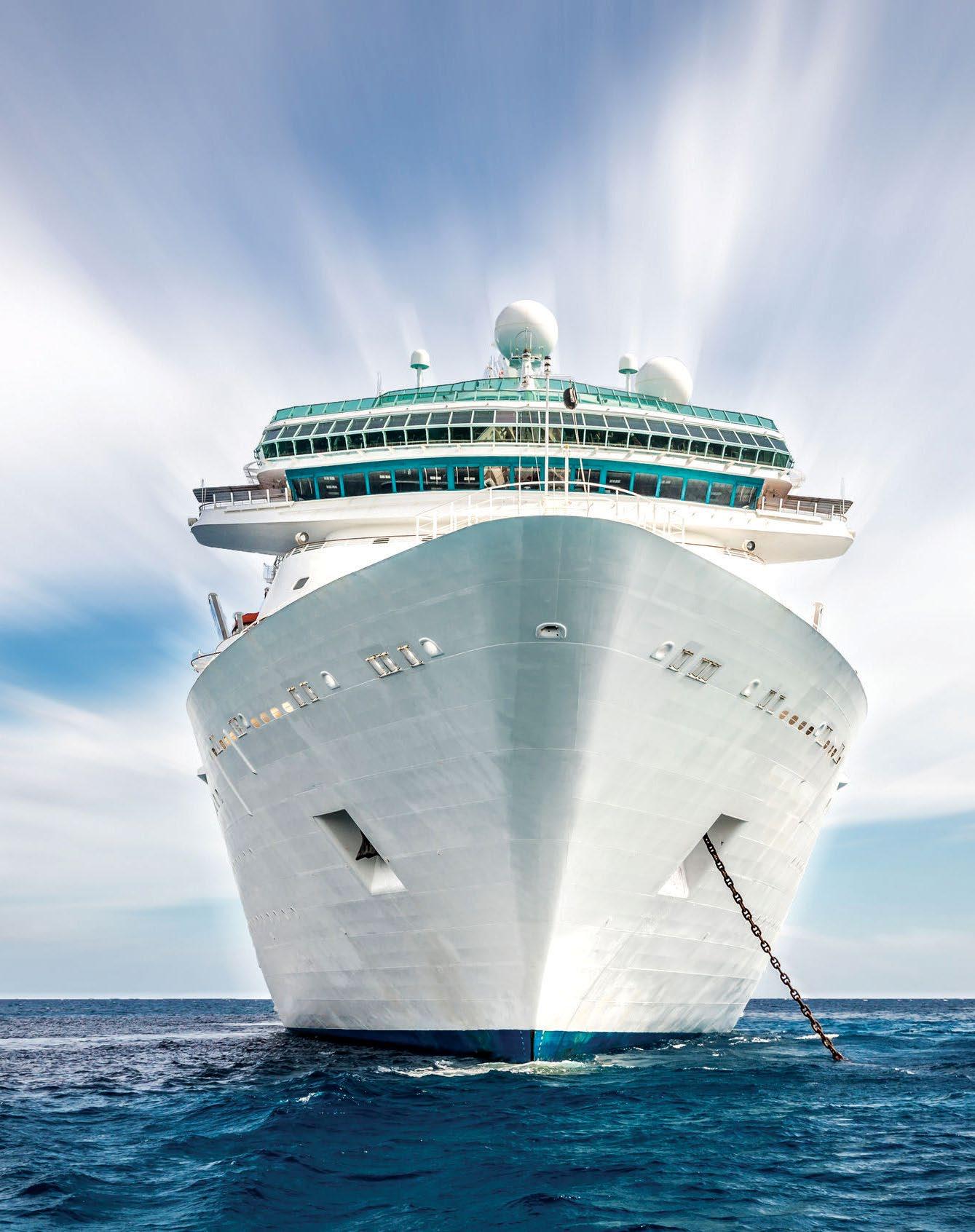
In 2025, India’s cruise tourism industry is finally poised to harness its vast and largely untapped potential. With a 7,500km. coastline, 12 major ports, over 200 minor ports, and an intricate 20,000km. network of 110 navigable waterways connecting more than 400 rivers, the country is abundantly endowed with natural assets ideal for cruise-based travel. Along these coasts and riverbanks lies a rich mosaic of states, union territories, and over 1,300 islands—each offering fertile ground for thematic, waterborne journeys that appeal to every segment, from ultra-luxury to more accessible experiences.
Despite its global reputation in hospitality, India’s cruise sector has historically lagged behind more agile counterparts such as Singapore and Dubai, falling short of the progress seen in its hotel, luxury train, and aviation industries. That tide, however, may finally be turning. Supported by progressive policy reforms, major infrastructure investments, and strategic regional alliances, India is now charting a bold new course—ready, perhaps, to claim its place on the global cruise map.
What’s bringing about the change?

MINISTER OF PORTS, SHIPPING AND WATERWAYS
“India has a vast and beautiful coastline, virgin forests, idyllic islands, art and culture, and that brings uniqueness to the proposition. The government wants to promote India’s art and culture through both sea and river cruise.”
The Sagarmala Programme is India’s flagship portled development initiative, aimed at enhancing port infrastructure, promoting coastal shipping, and boosting cruise tourism. As part of this programme, several cruise terminals have been developed or are underway across key ports.
Among coastal cities with ports, the most modern is the Mumbai International Cruise Terminal (MICT), India’s largest cruise terminal, inaugurated on April 21, 2025. Built at a cost of ₹556 crore, it is designed to handle one million passengers annually, with a daily capacity of 10,000–15,000 passengers.
Located at Ballard Pier near iconic Mumbai landmarks like the Gateway of India and Colaba, the terminal spans 4.15 lakhsq. ft. (38,554sq.m.) over four floors. Its design pays tribute to Mumbai’s coastal heritage, featuring a maritime-inspired ceiling, rose gold accents, and wave-shaped seating. The first two levels are dedicated to passenger operations, while the upper two will house sea-view cafes, retail stores, dining zones, and leisure areas. A shore-to-ship electric supply system allows vessels to draw onshore electricity, reducing emissions and supporting the green port initiative.
More terminals are in progress. The Chennai Port has been upgraded to support cruise tourism, including berthing facilities, as has Vizag. A new terminal is under construction at Mormugao Port, Goa, which recorded a 40% surge in cruise passengers and a 15% rise in vessel calls in 2024. Cochin Port is undergoing enhancements, while a new terminal is being built at Ernakulam Wharf. Many existing ports, however, still lack the infrastructure to accommodate large cruise ships, requiring significant investment in berthing, passenger handling, and sustainability features.
India aims to double cruise passenger traffic by 2029 and generate $4.9 billion in cruise revenue by 2041. In pursuit of a world-class cruise tourism experience, the Ministry of Ports, Shipping, and Waterways launched the Cruise Bharat Mission in September 2024—a sweeping initiative to achieve these targets.
Announced by Minister of Ports, Shipping and Waterways, Sarbananda Sonowal, aboard the M.V. Cordelia Empress, the three-phase plan envisions India as a premier cruise hub, tapping both sea and river routes. Sonowal called the mission “a watershed moment in the revamp of the cruise sector of India”, aimed at transforming the maritime landscape through world-class infrastructure and by harnessing the potential of India's extensive coastline and waterways.
“Cruise, with its tremendous potential in our country, has remained unexplored for long. With this visionary mission, it is aimed at transforming our maritime landscape and harnessing the potential of India’s vast coastline and waterways through cruise tourism. India has a vast beautiful coastline, virgin forests, idyllic islands, art and culture, and that brings uniqueness
OPPOSITE: Angriya Cruises were pioneers in domestic luxury cruise industry.
BELOW: International liners such as Celebrity Cruises would dock briefly, refuel, and move on to more scenic, infrastructure-ready ports elsewhere in Asia.


CHADHA CEO, TIRUN TRAVEL MARKETING
“There is a growing demand for luxury and experiential cruising.
When we began in 1993, only about 200 Indians had experienced an international cruise. Today, thousands choose cruises annually.”
to the proposition. The government wants to promote India’s art and culture through sea and river cruise.”
Aligned with the Maritime India Vision 2030, the Cruise Bharat Mission addresses infrastructure gaps and regulatory frameworks essential for sustained sector growth. Key measures include simplifying port charges, waiving cabotage laws for foreign ships, and introducing e-visa facilities. The mission targets an increase in sea cruise tourists to 10 lakh annually. Additionally, a presumptive taxation regime has been introduced for non-resident businesses operating cruise ships.
CLOCKWISE FROM LEFT: The interiors of Silversea's Silver Dawn; delectable fare aboard Cordelia Express and the spa facility at Silversea's Silver Dawn.
These initiatives are part of India’s broader strategy to become a global cruise tourism hub, while also enhancing maritime infrastructure and regional economies. Passenger-friendly policies—such as standardised berthing rates, guaranteed berths and e-visa/on-arrival services—are being implemented. A single e-landing card, now valid across all Indian ports, further simplifies transit for international cruise passengers.
India occupies an enviable position between Southeast Asia, the Middle East, and East Africa. Its proximity to key corridors like the Strait of Malacca and the Suez Canal offers a natural advantage. Yet until recently, cruise operators largely bypassed Indian ports. The reasons are as predictable as they are persistent: underdeveloped terminals, cumbersome cabotage laws (governing the right to operate within a country’s territory), poor last-mile connectivity, and a lack of unified regulation.
As a result, India remained little more than a fuelling stop on the global cruise map. International liners such as Costa Cruises, AIDA Cruises, and Celebrity Cruises would dock briefly, refuel, and move on to more scenic, infrastructure-ready ports elsewhere in Asia. The allure of India’s coastline—from the Portuguese quarters of Goa to the spice-scented backwaters of Kochi—remained largely untapped, constrained by infrastructural gaps, visa hurdles, and limited coordinated tourism promotion.
The downturn worsened after 2016, when major cruise lines began pulling out of Indian ports altogether. Thoothukudi in Tamil Nadu, for instance, did not receive a single international vessel for six years. Cruise tourism, which thrives on efficiency and experience, found Indian ports lacking in both.
But the tide began to turn in November 2022, when Le Champlain, a French expedition ship operated by Ponant, marked a symbolic return—sailing into Mumbai, Goa, and Kochi before continuing to Galle and Trincomalee in Sri Lanka. The comeback gathered momentum when the Bahamas-flagged M.S. Amera, operated by Germany’s Phoenix Reisen, docked in Thoothukudi on 11 January 2023, ending its long hiatus.



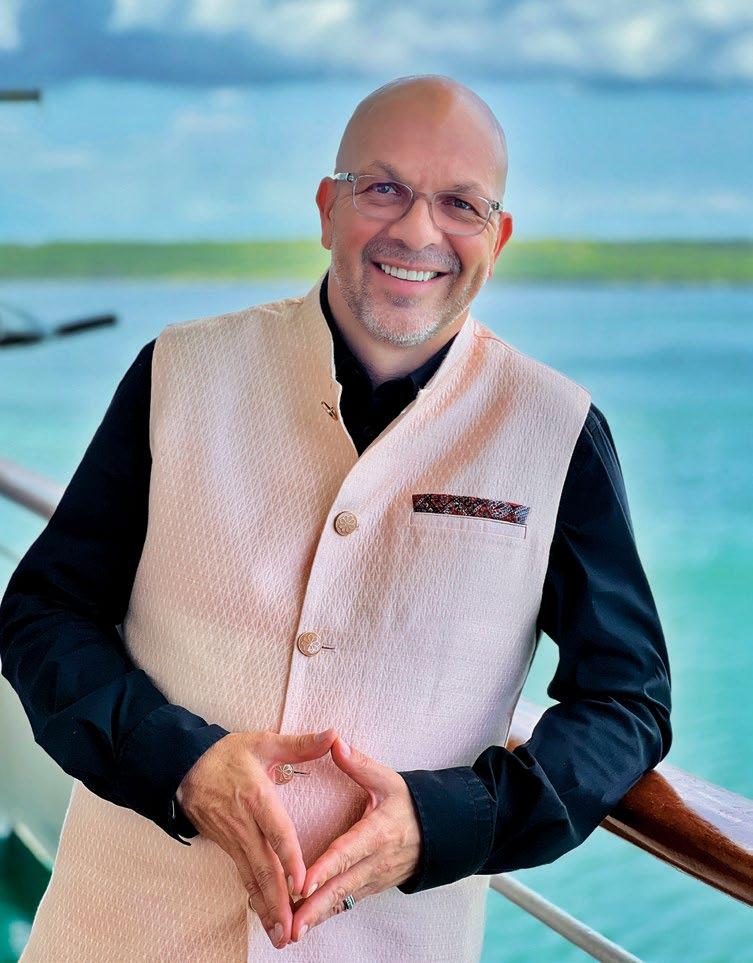
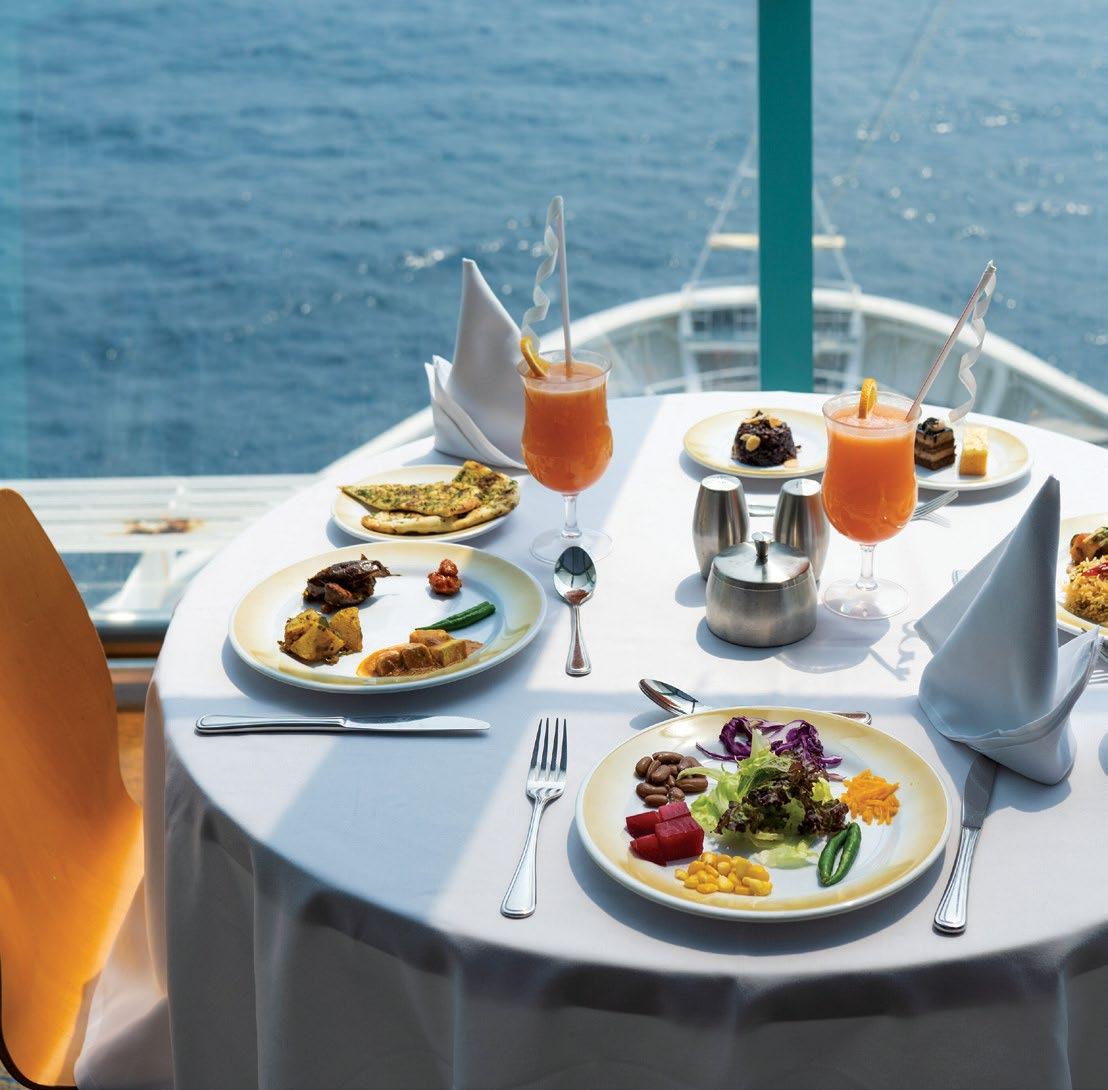
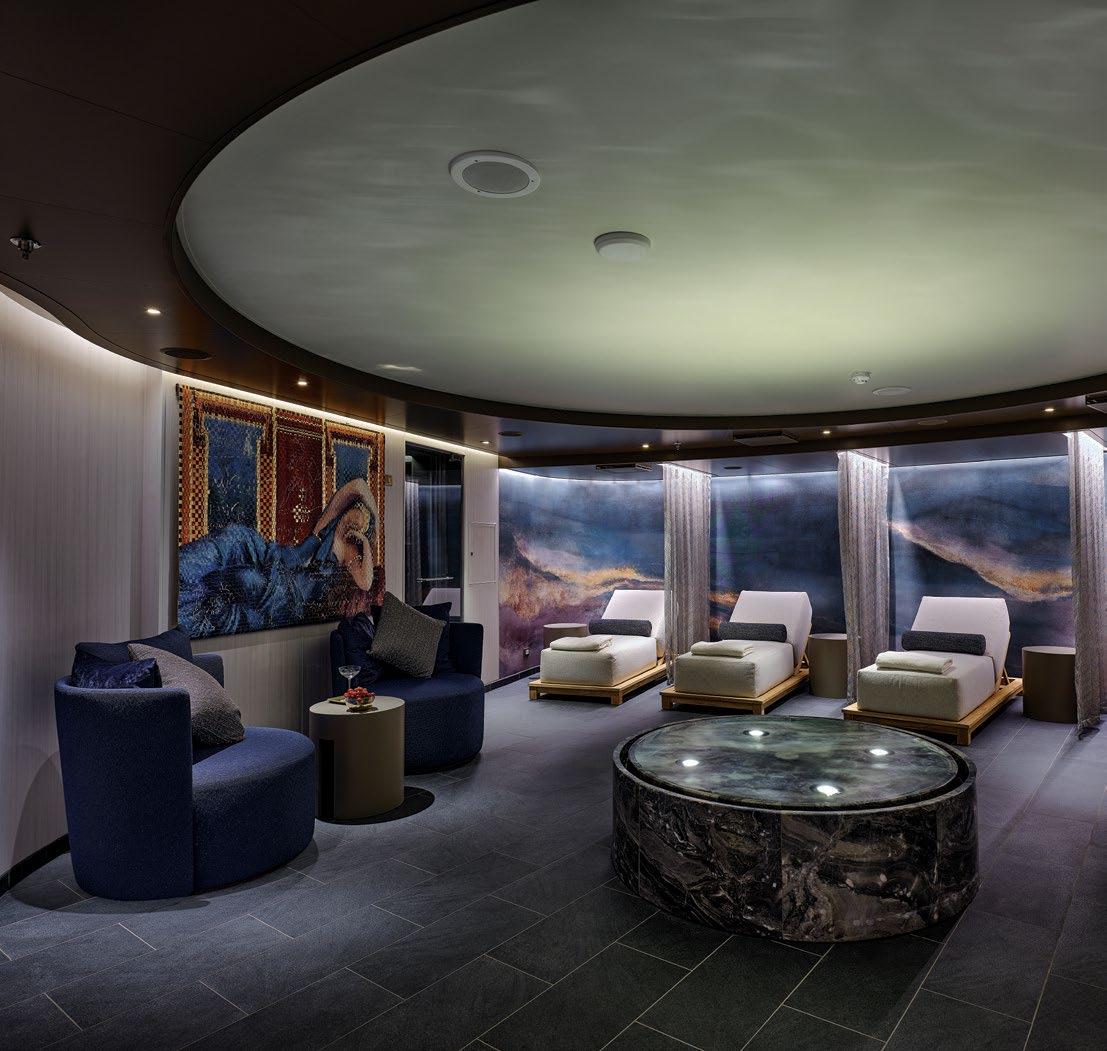
JURGEN BAILOM CEO, CORDELIA CRUISES
“Before the two COVID years, only about 150,000 to 200,000 Indians cruised internationally each year, mostly to destinations like Singapore, Thailand, and occasionally the Caribbean. That’s what sparked the idea—India needed its own cruise company. The outbound travel numbers showed there was a strong demand, but also a clear gap in domestic offerings.”

ABOVE:
OPPOSITE:
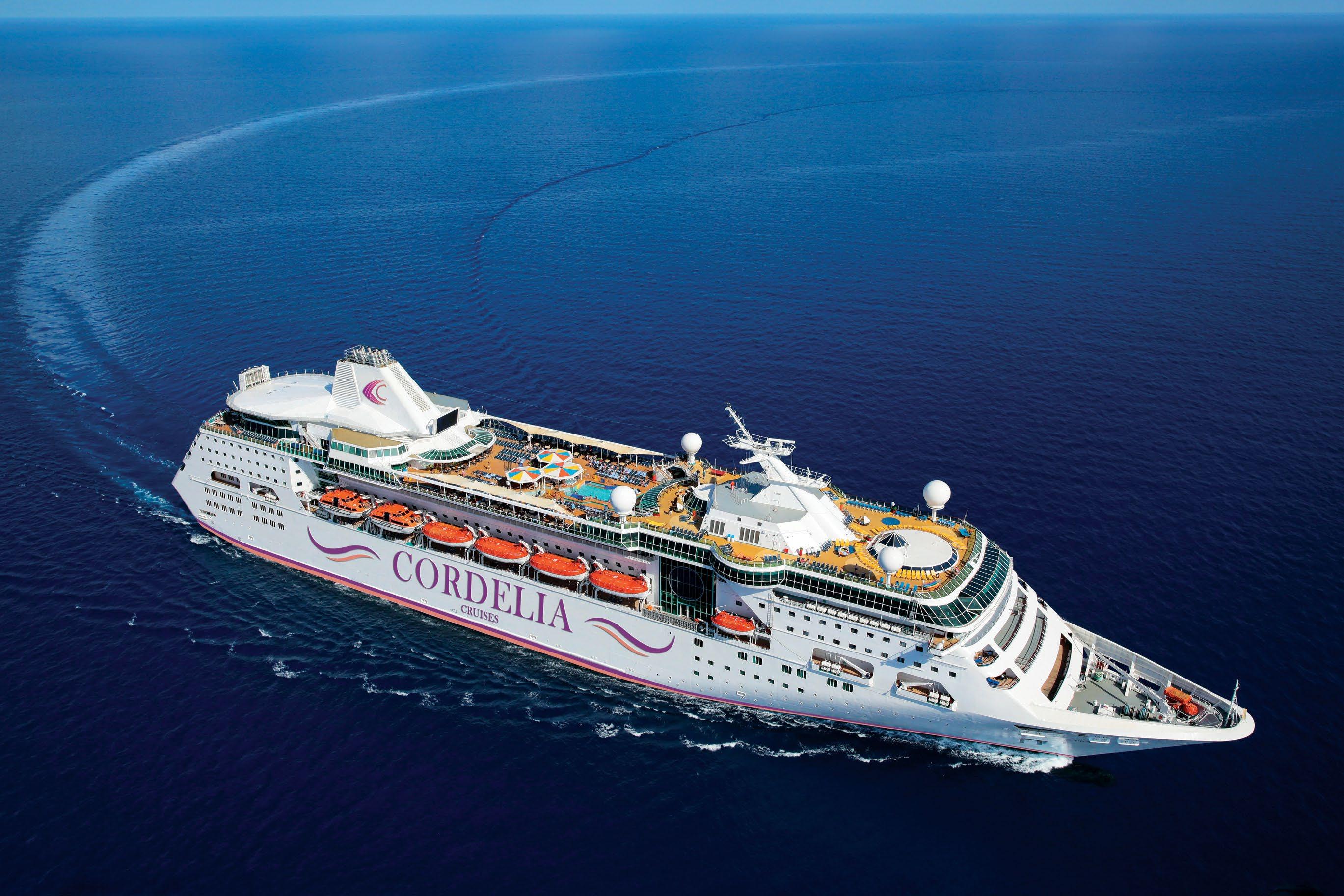

Several developments have signalled a shift. In May 2022, the Mumbai Port Authority hosted India’s first International Cruise Conference, drawing stakeholders from global cruise giants like Royal Caribbean, MSC Cruises, and Holland America Line. The agenda was clear: ‘How can India evolve from a pit stop to a port of call?’ “In 2019, we had more than 400 cruise vessels coming to our shores and reached four lakh cruise passengers,” announced Dr. Sanjeev Ranjan, Secretary of the Ministry of Ports, Shipping & Waterways, during the inaugural session of the conference.
Today, smaller luxury liners like Ponant, Seabourn, and Azamara Cruises—each carrying 200 to 300 passengers—have begun weaving India into their itineraries. But the bigger challenge lies ahead: attracting mega-ships that host 1,000 to 1,500 guests and require not just deeper berths and world-class terminals, but also seamless immigration, curated excursions, and efficient last-mile connectivity.
Progress is visible—ports like Mangalore have been added to cruise routes, and Lakshadweep is emerging as a boutique island destination. The conversation has shifted from feasibility to opportunity. India’s cruise revival is still in its infancy, but the compass is finally pointing in the right direction.
India’s domestic cruise industry has faced its own set of challenges. Angriya Cruises, the country’s first luxury domestic liner, launched in October 2018 with a 16-hour voyage between Mumbai and Goa. Offering a range of luxurious amenities, it marked a significant milestone for the nascent sector. However, operations were suspended in March 2020 due to the COVID-19 pandemic. During the hiatus, the vessel was repurposed for sea bubble services in Sri Lanka to assist stranded seafarers. Although there were plans to resume in mid-2021, Angriya Cruises remains nonoperational as of April 2025.
“As pioneers in the domestic cruise industry, we faced the challenge of creating an entirely new infrastructure from scratch—both in Mumbai and Goa. In Goa, we managed the entire boarding process ourselves, while in Mumbai, the port eventually supported us with the necessary facilities. A significant hurdle was training our staff, as the skill sets required for a domestic cruise differ greatly from those for international ships,” says Leena Kamath Prabhu, former Managing Director of Angriya Cruises.
Prabhu also recalls a lighthearted anecdote from the liner's early days. “The first week was an eyeopener—passengers were so excited, they’d bring out their mattresses to sleep under the stars and feel the waves crash—experiences we never anticipated but embraced wholeheartedly,” she laughs.
Meanwhile, Jalesh Cruises, India’s first premium cruise line launched in April 2019 under the Essel Group, faced operational and financial difficulties, ultimately declaring bankruptcy in October 2020. The brand was acquired by the Waterways Leisure Tourism division of New York-based Chatwal Group and rebranded as Cordelia Cruises in 2021. Despite early setbacks, Cordelia has since established itself as a dominant player in the Indian cruise industry.
With its sole ship, the Cordelia Empress, operating at full capacity, Cordelia Cruises is set to expand its fleet with two new ships—the Cordelia Sun and Cordelia Sky. This will boost capacity by 4,000 guests, adding up to 2,200 additional staterooms and suites. The expansion aligns with Cordelia’s vision to meet the growing demand for luxury cruises in India.
"The addition of these ships will allow us to offer more exclusive experiences, furthering our mission to make India a leading cruise destination while providing guests with even more luxurious and vibrant options," says Jurgen Bailom, CEO of Cordelia Cruises.
(Oct 2024–Sep 2025)
Master planning, regional cooperation, and upgrades to existing terminals and marinas.
Mumbai Port ₹556 crore
(Late 2025–2027)
Launch of new cruise circuits and the construction of new terminals.
(2027–2029)
Integration of domestic and international cruise networks with continued infrastructure expansion.
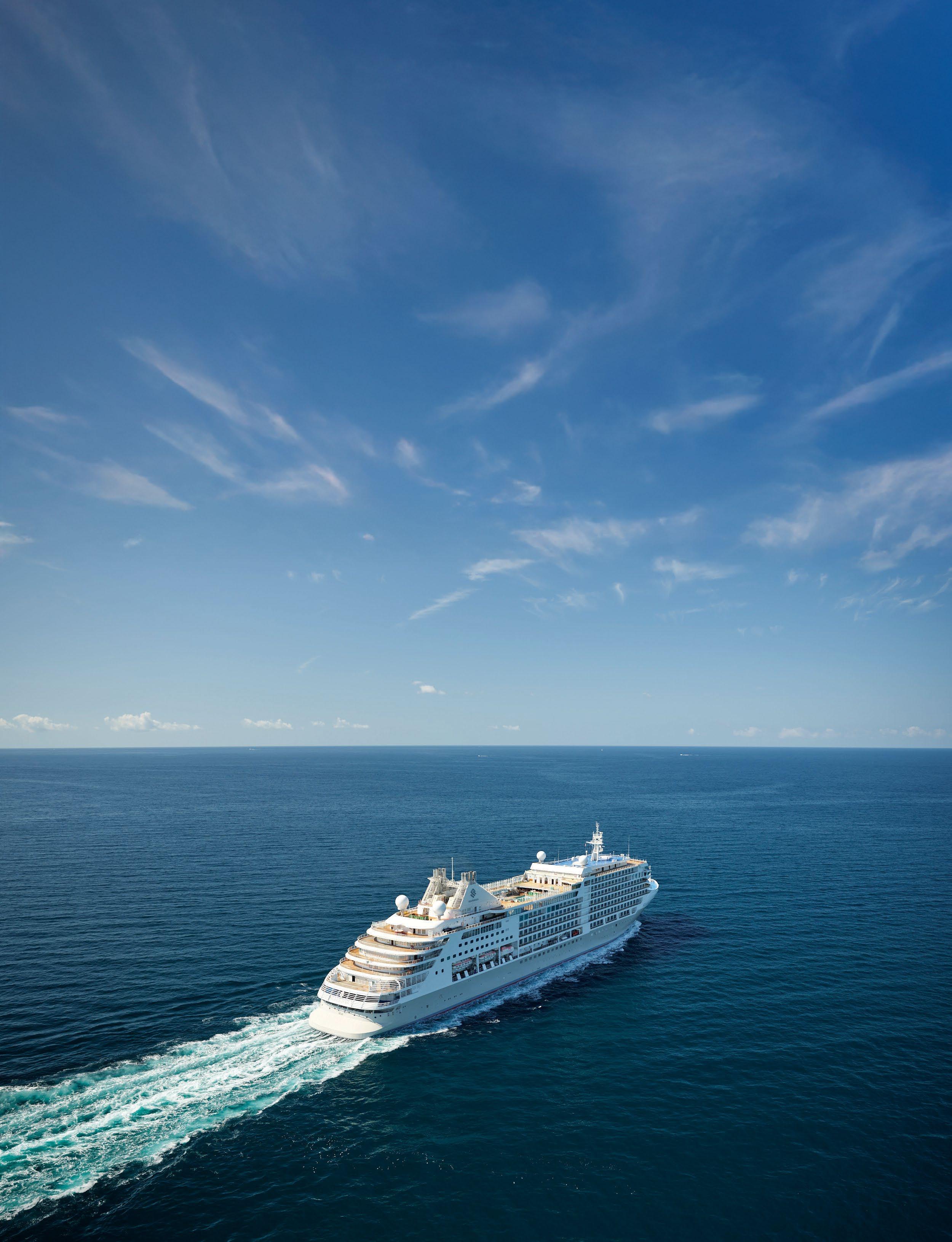
The Mumbai International Cruise Terminal (MICT) at Ballard Pier commenced operations on 21 April, 2025. It is designed to handle 1 million passengers annually, with facilities to accommodate five ships simultaneously.
Cochin Port ₹25.7 crore Operational international cruise terminal.
Chennai Port ₹17.2 crore
Mormugao Port (Goa) ₹153 crore
Puri (Odisha)
Cruise Passenger Facilitation Centre to enhance east coast capacity.
Ongoing terminal projects strengthening Goa's position in regional cruise itineraries.
Planned cruise terminal as part of a 3,500-acre maritime cluster to promote religious tourism and coastal development.

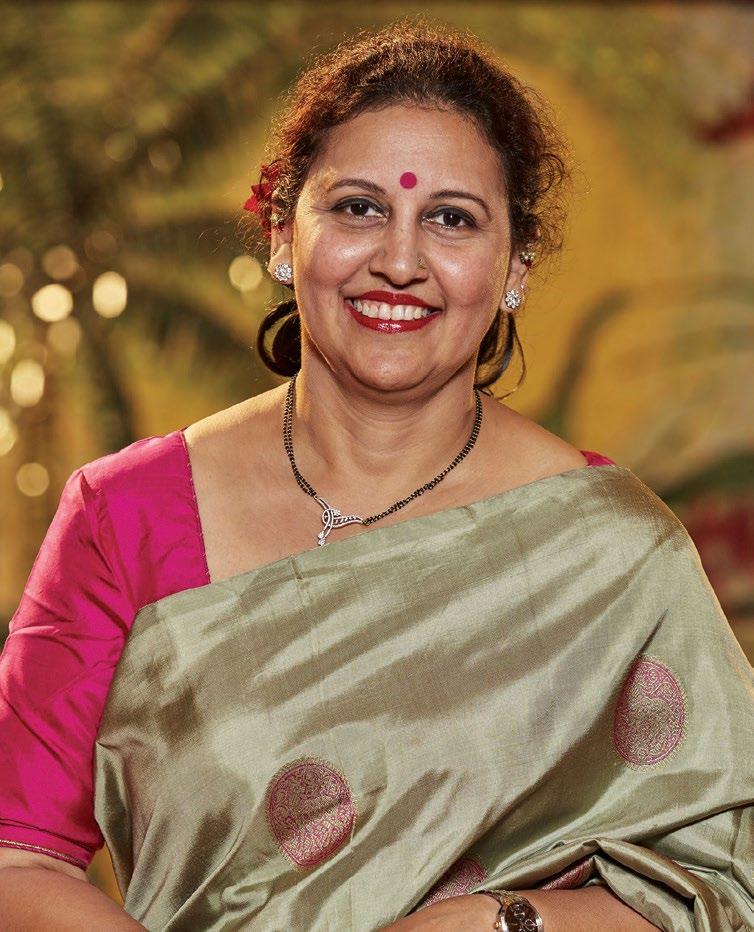
“As pioneers in the domestic cruise industry, we faced the challenge of creating an entirely new infrastructure from scratch—both in Mumbai and Goa. A significant hurdle was training our staff, as the skill sets required for a domestic cruise differ greatly from those for international ships.”
According to Bailom, before the two COVID years, only about 150,000 to 200,000 Indians cruised internationally each year, mostly to destinations like Singapore, Thailand, and occasionally the Caribbean.
“That’s what sparked the idea—India needed its own cruise company. The outbound travel numbers showed there was a strong demand, but also a clear gap in domestic offerings.”
Cordelia’s offerings go beyond conventional cruise experiences, featuring Bollywood-inspired entertainment, extravagant Holi parties, and a festive, immersive atmosphere. Entertainment was tailored to what Indians love—Bollywood music, Hindi soap opera-style shows, cricket, and full-on celebrations. “That means eating together, dancing first, drinking later, eating in between—and food has to be available 24/7. The ship should smell of masala chai, which, by the way, tastes different depending on where in India you’re from. Our goal is not only to provide world-class cruising but also to bring the magic of Bollywood and Indian celebrations like Holi to our guests, creating unforgettable memories at sea," he adds.
Cordelia Cruises now offers an international itinerary to countries such as Sri Lanka and the Maldives, while continuing to highlight India’s emerging cruise hotspots like Diu, Visakhapatnam, and Puducherry. With plans to raise approximately ₹800 crores through a potential Initial Public Offering (IPO), Cordelia is clearly expanding not just its fleet, but its presence in both Indian and global cruise markets.
India’s cruise tourism is on a promising rise. As infrastructure improves, India is increasingly becoming a home port for international liners. Ratana Chadha, CEO, Tirun Travel Marketing, which introduced international cruises to India in the 1990s, highlights the growing demand for luxury and experiential cruising. "When we began in 1993, only about 200 Indians had experienced an international cruise. Today, thousands choose cruises annually," she says.
LEFT: Silversea's Silver Dawn is a luxury cruise ship that offers voyages to various destinations, including India.
During product development, the team realised the importance of catering to Indian tastes. “Food, for example, had to reflect the diversity of our palate— vegetarian, non-vegetarian, Jain options, regional street food—and it had to appeal to everyone, including kids and younger travellers. Because families in India tend to travel together, especially during vacation time, the cruise experience had to feel like a true family holiday,” says Bailom.
Bailom notes the MICE and weddings segment is enormous for cruise liners like theirs. “We’ve hosted several weddings onboard. Imagine the mandap set, 700 guests gathered, and the sun setting perfectly behind it. It’s magical. We coordinate every detail— even informing the captain to position the ship for that breathtaking sunset. After the ceremony, guests enjoy a high-energy wedding show that gets everyone dancing. What makes cruise weddings truly special are the unique photo opportunities—from stunning ocean views to custom backdrops, offering countless Instagrammable moments couples and guests cherish forever.”
With continued investment, the rise of boutique cruises, and world-class facilities, India is poised to become a major player in global cruise tourism, ushering in a new era of waterborne luxury and adventure. The winds of change are at India’s back, ready to make its mark on the global cruise map.




ASHISH JAKHANWALA, the visionary Chairman, Managing Director and CEO who founded SAMHI Hotels in 2010, has crafted a bold playbook. His strategy? Transform India’s hospitality landscape by focusing on institutional investment and an acquisitiondriven growth model, targeting prime metropolitan cities.
CREATIVE DIRECTOR TANVI SHAH
PHOTOGRAPHED BY PRIYANKK NANDWANA
Ashish Jakhanwala, Chairman, Managing Director and CEO of SAMHI leads India’s pioneering hotel investment company—the first to break the mould as an institutional investor in the sector. Known for being sharp, witty, and driven, Jakhanwala heads a portfolio of 34 hotels. He’s worked across almost every department and role— operations, design, F&B—a hospitality veteran who’s been in the business so long, he probably dreams in RevPar stats.
He may call what he does ‘boring’—unlike the more glamorous corners of hospitality—but SAMHI’s portfolio tells another story. A self-professed data nerd, Jakhanwala’s secret sauce lies in his acquisition-led strategy—like playing Monopoly with real hotels. It’s a strategy that has earned the backing of big-league investors, including GTI, Equity International, IFC Washington, Goldman Sachs, and Sam Zell’s Equity International.
The Q4 FY ’25 results tells us how far SAMHI has come. Its Total Income for FY ’25 (Trinity consolidated w.e.f October ’24.) is ₹11,487 million, while EBITDA (pre-ESOP) is ₹4,434 million.
In this candid interview, he talks about his journey, why he’s bullish on India’s growth, and why going public is a means to an end—not a headline. For him, an IPO may be a good way to grow, but the focus must always remain on the ‘growth,’ not the buzz.
SAMHI acquired what is now Hyatt Regency Pune from Ascent Hotels for ₹350 crore, and brought in Hyatt Group to manage. Renaissance Ahmedabad offers 29,220 sq.ft. of indoor and outdoor flexible and modern REN meeting and events spaces.



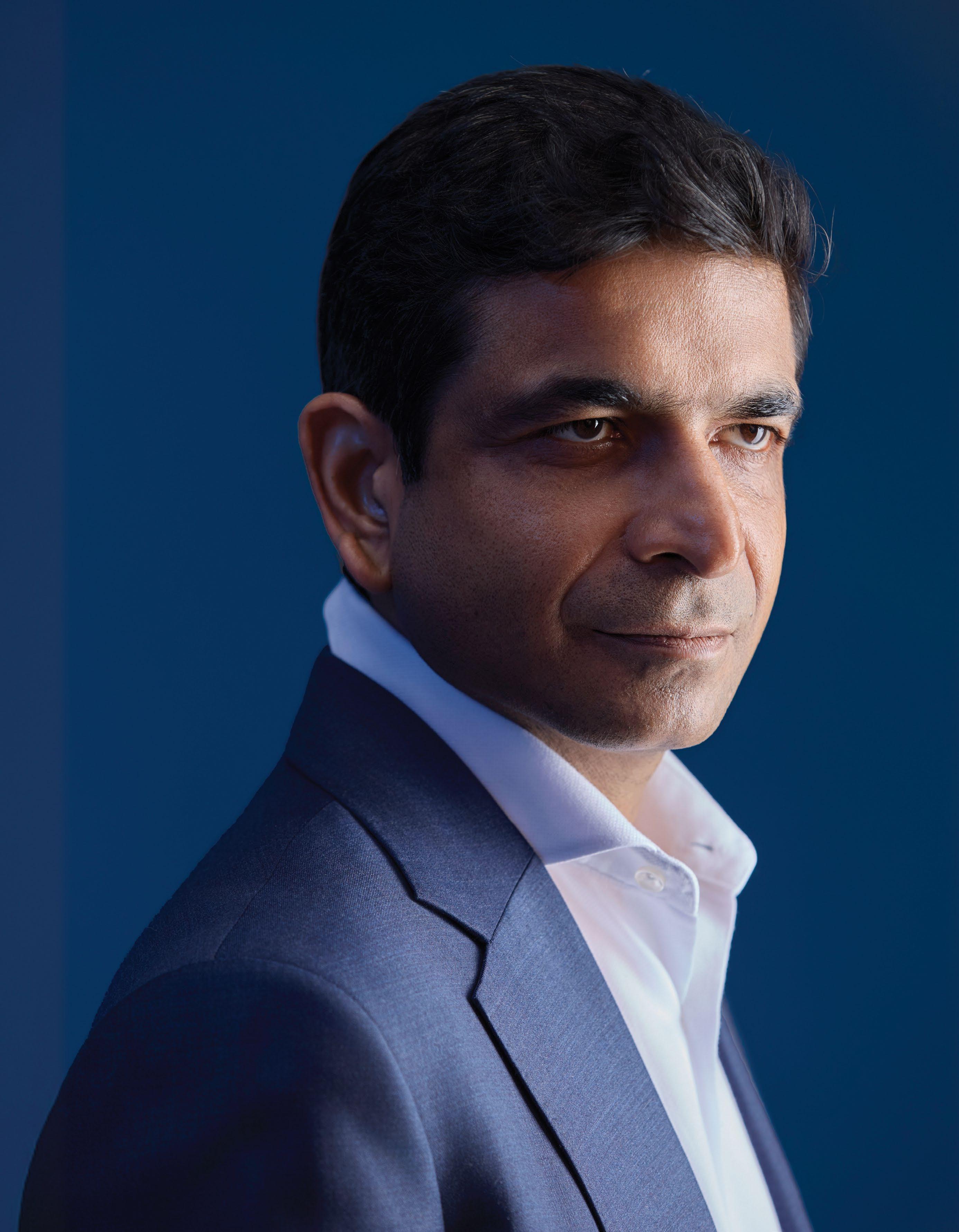

What got you into the hotel industry at a time when it wasn’t as vibrant as it is today?
I joined a hotel school in 1996. Honestly, there wasn’t much strategy or planning behind it. Before that, I did my schooling in the mountains of Uttarakhand. There were pros and cons to studying in the hills—especially in the early ’90s. You’re somewhat cut off from the rest of the world.
So when you come to a city, you're a blank slate. No biases about becoming an engineer, doctor, or anything else. The downside is you're a bit unexposed, if I may say so— but the upside is, you have no preconceived notions.
After finishing school, I moved to Lucknow. I happened to see an ad for hotel school admissions, applied, got selected, and went on to do three years of hotel management. I graduated from IHM Lucknow in 1996.
Back then, a hotel management graduate almost always started in hotel operations. Things have changed now— graduates go into retail, consulting, and other industries—but in 1996, you were headed for a hotel job.
I began as a management trainee at The Claridges in New Delhi and worked there for about two years. During that time, I realised I wasn’t cut out for operations.
I trace that back to growing up in the mountains—a place that makes you introspective. No TV, no distractions, no malls—just time to think. But hotel operations is a live-wire job. You're constantly on your feet, with little time to pause.
After two years, I knew I needed to do something else. So I moved into hotel facilities planning. From 1998 to 2002, I worked with the legendary Narendra Varma, who had headed development at Oberoi Hotels and was part of the team that built several Oberois, including those in South Bombay.
Though trained in operations, I started learning hotel design—both conceptually and technically. I learned AutoCAD and could draw entire hotels— electrical, plumbing, kitchen, and laundry layouts.
Having worked in operations helped me approach design with a practical lens. I had already left operations and effectively burnt that bridge, so I had to find a new path.
Around that time, I also began my Executive MBA at IIM Delhi. However, I questioned whether I could rise in such a technical role without being an engineer. Since I was doing an MBA, I started exploring other opportunities.
That’s when I joined PKF—Pannell Kerr Forster—a hospitality advisory firm led by the fabulous Uttam Dave, who now consults with Manav (Thadani) at Hotelivate. He’s someone many in the industry hold in high regard. I spent two years at PKF, learning the business side of hospitality: consulting, Excel modelling, forecasting, strategy, PowerPoint—you name it.

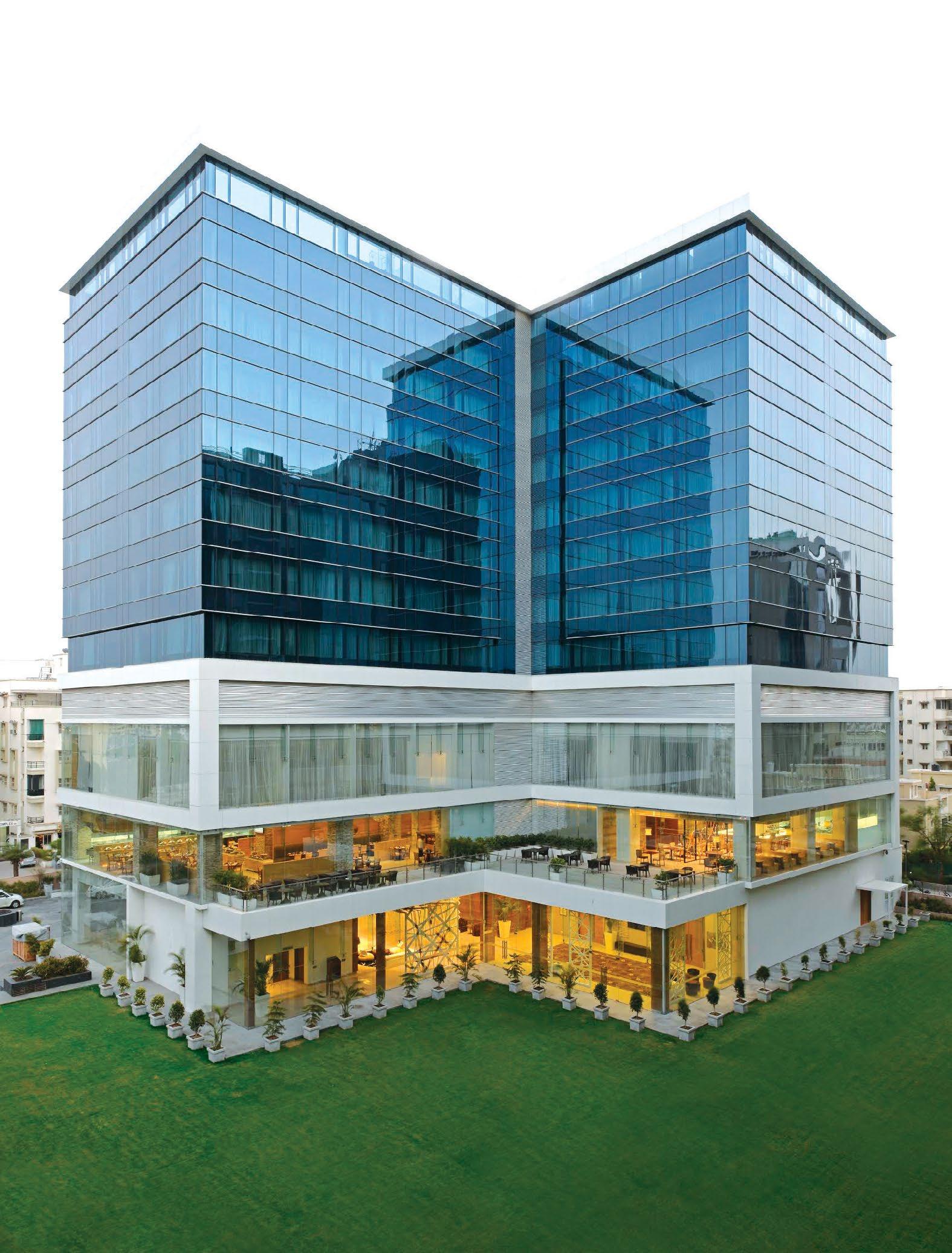
By then, I had experience in operations, design and planning, partial MBA credentials, and consulting. In 2004, Uttam was joining a new JV between Accor and InterGlobe and asked me to come help build the company.
So I joined in 2004. Until the end of 2010, I was part of the core team at Accor Hotels India. I played a key role in building what is now the ibis Hotels network for InterGlobe. I also worked on transactions like the Sofitel Mumbai and led the acquisition of the land for what is now Novotel and Pullman at Delhi Airport.
Those seven years were an incredible journey—deploying capital to build hotels. By the time I left, I had secured 17 ibis deals, a few Novotels, and the Pullman—a total of 25 transactions.
So from 1996 to 2010—14 years—I worked across operations, facilities planning, consulting, and development. The only thing left was to become an entrepreneur. In 2011, I founded SAMHI. And it’s been a good 14 years since then.
LEFT: Renaissance Ahmedabad offers
29,220 sq.ft. of indoor and outdoor flexible and modern meeting and events spaces.
BOTTOM: The Courtyard by Marriott Bengaluru Outer Ring Road is strategically located in Bellandur, Bangalore, near the bustling IT hubs of Marathahalli and Outer Ring Road (ORR), and blends luxury and functionality.

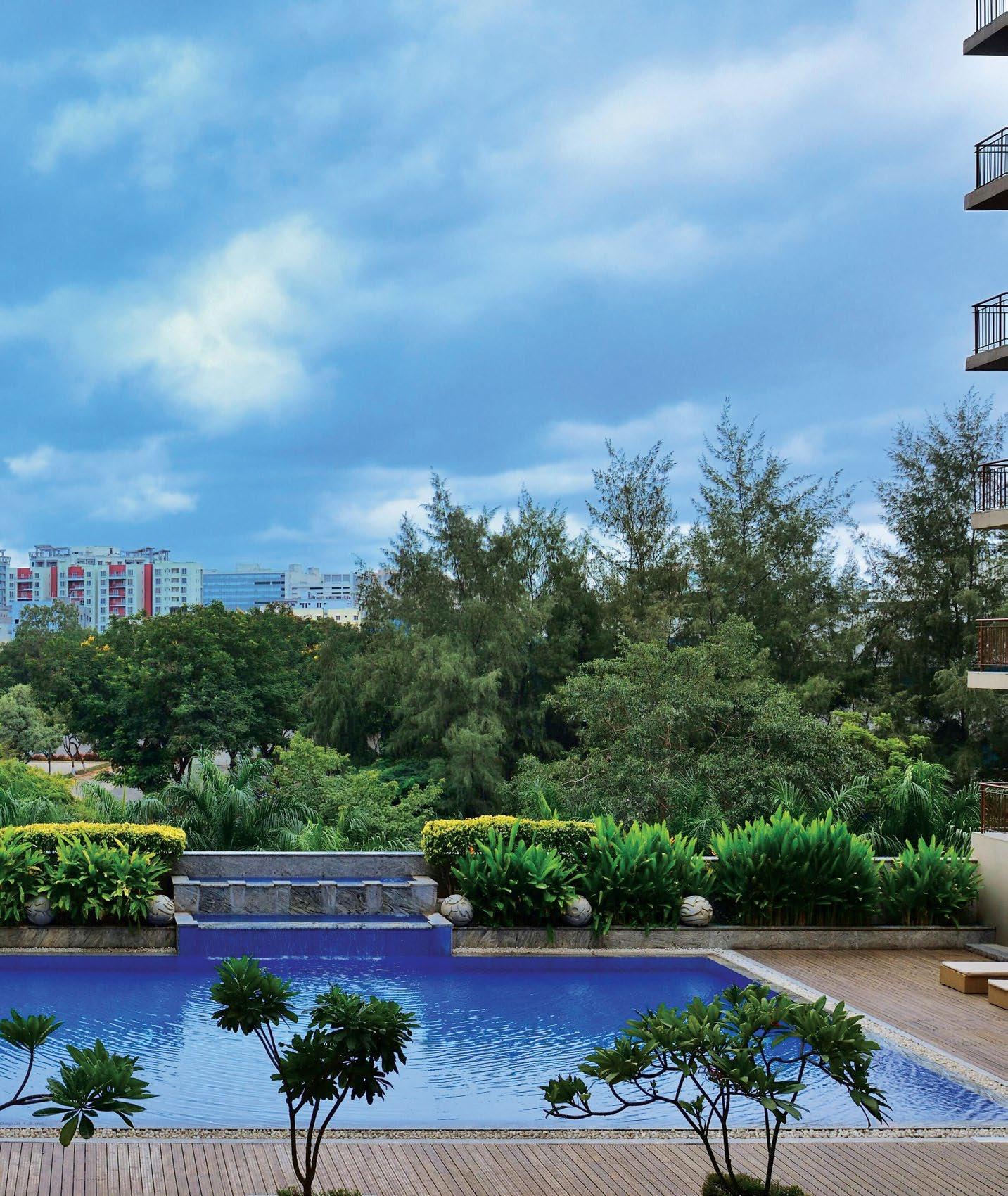
I started with GTI, founded by Gaurav Dalmia, who remained an investor until just last month. Then we brought in Sam Zell—revered in the U.S. as the Warren Buffett of real estate. When you have investors like that, it’s like attending Harvard at every board meeting. Their experience, insight, and relationships bring enormous value. My advice to any entrepreneur is this: when starting or growing a business, don’t chase valuation— focus on the quality of your investor.

What inspired the transition from your role at Accor-InterGlobe to starting SAMHI? You've touched on that—but what was the experience like during your time there? How did it shape your vision for SAMHI? That period was transformational for many reasons. While I wasn’t leading the business at Accor-InterGlobe, I was part of it—and had a ringside view of how a business is built. The joint venture was rich in talent, especially on the people side.
Take someone like Gaurav Bhushan, now co-CEO of Accor Lifestyle Hotels—he was my immediate boss at the time. He was based in Singapore; I was here. Then there was Rahul Bhatia, now best known for IndiGo. Having the chance to observe such people firsthand is incredibly inspiring. It shows you the headroom is infinite—that there’s always space to grow. It also nudges you to think about building something of your own.
And honestly, inspiration often comes from the smallest things. I don’t really believe in ‘Eureka’ moments—though I know they happen for some. For me, change has always come through gradual shifts in perspective, shaped by the small stimuli around me.
Over six or seven years, I was constantly learning. We were doing a lot of greenfield development, and as you know, not all of it went smoothly. Delays, roadblocks—that’s the nature of greenfield. Even when the decisions aren’t entirely yours, those challenges weigh on you if you’re an honest professional. You follow a set strategy, but you still learn—what works, and what doesn’t.
The people I worked with were phenomenal. It’s rare to encounter such talent in one lifetime. I also had the opportunity to make several investments. You need the courage to take bold calls.
Thankfully, I had bosses who encouraged that kind of risk-taking. They were patient, even when things didn’t go as planned. That sort of environment conditions you well—it teaches you to take calculated, meaningful risks.
If I look at my earlier experiences—at The Claridges New Delhi with Mr. Narendra Varma, or with PKF— those years were about learning the technical aspects: operations, design, feasibility. The Accor phase was about personal evolution.
I divide my career into two broad phases. The first—from 1996 to 2004—was all about skill-building. The second—from 2004 to 2011—was when I truly evolved as a person. I built confidence, developed relationships, and drew inspiration from visionary entrepreneurs like Rahul Bhatia.
Those two phases defined me. And it was that second phase—my time at Accor-InterGlobe—that gave me the confidence to start what is today SAMHI.
What did you learn about the hotel industry while setting up SAMHI? And what challenges did you face as a first-time entrepreneur?
By the time I started SAMHI, I had already learned many key lessons. And let me tell you—it’s a freakishly difficult business. Whatever can go wrong, will go wrong. Hotel development in India is extremely painful and unpredictable.
If you look at the landscape in 2010, hotels in India were largely owned by brands themselves—like Oberoi, ITC, Lemon Tree—or by real estate developers such as the Rahejas, Sarafs, or Jatias. To their credit, many of these developers have since evolved into institutional players. But back then, they were still primarily real estate-focused firms dabbling in hospitality.
Globally, the model is different—hotels are typically owned by institutional investors. I saw an opportunity to replicate that model in India: to build a platform that could attract institutional capital and become the country’s first large-scale institutional hotel ownership company.
That was the pitch I made to my first set of investors. The simplicity of the message—combined with the credibility I had built in previous roles—helped a lot. I managed to bring in what many would call jaw-dropping investors at the time.
I started with GTI, founded by Gaurav Dalmia, who remained an investor until just last month. Then we brought
in Sam Zell—revered in the U.S. as the Warren Buffett of real estate.
When you have investors like that, it’s like attending Harvard at every board meeting. Their experience, insight, and relationships bring enormous value. That’s why my advice to any entrepreneur is this: when starting or growing a business, don’t chase valuation—focus on the quality of your investor.
Valuation matters only when you're selling 100% of your business. That’s when you aim for the best number. But in the build or grow phase, a great investor— even at half the valuation—can help you create twice the value over time.
That’s how we began. We had the right investors. We kept the message simple and stuck to it. We weren’t trying to do 20 things. We didn’t want to build a brand or manage hotels. We weren’t trying to be clever or flashy. We just wanted to be a predictable, plain-Jane investor in branded business hotels run by third-party operators.
And 14 years later, we’re still not bored of that philosophy.
You continue to be investors rather than brand creators. Have you never seriously considered building a hotel brand?
Well, have I thought about it? Sure. But honestly, the thought doesn’t last more than 160 seconds. Running hotels—and more importantly, hotel brands—has reached a scale today where, for a company like ours—and let me clarify, I’m not putting us down—but for any subscale company in India, who are we kidding? Brands are best built by behemoths like the Taj, Marriott, Oberoi and ITC.
A real hotel brand today means 400 hotels, a couple of million rooms, loyalty programs with tens of millions of members, and global distribution across 100 countries. That’s what defines a brand. The name of a building? That’s just an address—not a brand. A true brand stands for scale, recognition, loyalty, and consistency—and that takes decades to build.
So, while creating a brand might sound exciting, we’re clear about who we are. We’re impatient for results, deeply focused on scalability, and fairly unforgiving when it comes to performance and returns. And when you put that together, the answer becomes obvious. India offers operating leverage. It offers growth. I’d much rather be an owner

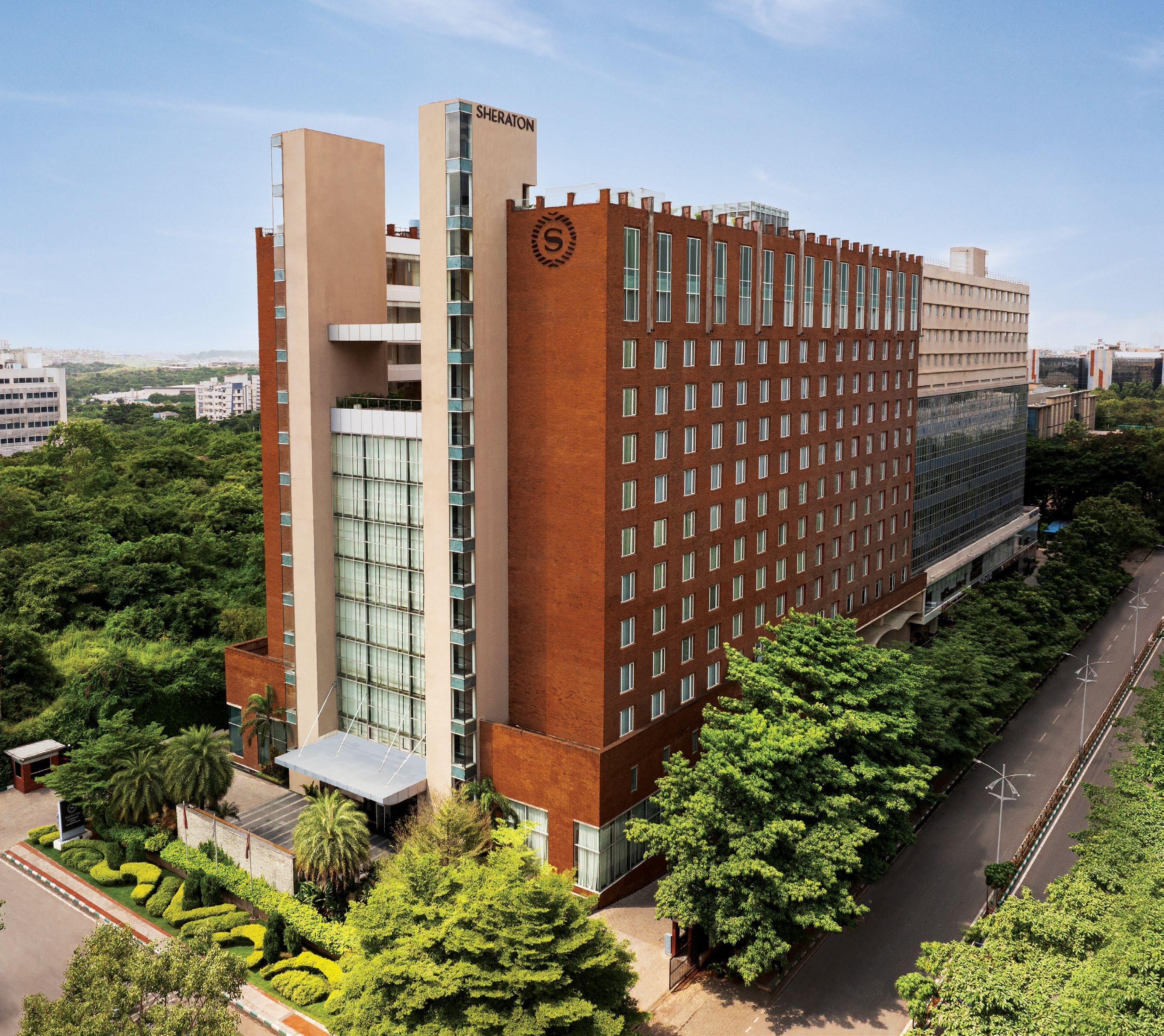
We’re not quite ready to invest heavily in Tier 2 and 3 cities today. But we know that as India grows, new kinds of opportunities will emerge. We need to stay agile and honest—never get myopic about what we’ve been doing.
keeping 85% to 90% of the revenue than a brand earning just 5%. I’ve never wanted to work for that little compensation.
Marriott was your first transaction partner. How did that deal come about, and how has your relationship with Marriott evolved since? Also, didn’t you bring Fairfield to India?
Marriott came on board very early. I started the company in January or February 2011, and by March or April of that same year, we’d announced a joint venture with them. Under that partnership, Marriott committed up to $30 million for a 33% stake in our platform, to introduce and develop the Fairfield by Marriott brand in India.
It was Marriott’s first capital commitment with any owner in India—a significant milestone. Through that JV, we developed the Courtyard and Fairfield in Bangalore. Over time, we began developing more hotels on our balance sheet, and around 2016–17, we bought back their 33% stake.
But I think both sides achieved what we set out to do. Marriott’s goal was to catalyse Fairfield’s growth in India— and we did that. Today, Fairfield is a well-recognised brand in the country. We remain its single largest owner in India, even though there are now other owners as well. Marriott’s exit and our continued expansion of the brand are, in many ways, a textbook example of how a strategic partnership can evolve successfully.
Since then, our relationship has strengthened. Today, we have a large and diverse portfolio with Marriott. If I’m not mistaken, we’re the single largest owner of Marriottoperated hotels in India, with 17 properties across brands like Fairfield, Four Points, Courtyard, Sheraton—and now adding W and Westin. It’s a strong partnership with a company we truly admire. Marriott is a global leader, and being a relevant partner for them in India is immensely valuable.
We also have strong relationships with IHG and Hyatt. While Holiday Inn Express existed in India before us, for IHG, we brought in a portfolio of 10 hotels and converted them all at once. Today, we own about 60–70% of all Holiday Inn Express hotels in India. We have one Sheraton and two Holiday Inn Express hotels in Hyderabad. So yes, we’ve built some strong, enduring partnerships across the board.
You’ve always focused more on value-formoney projects than luxury. Do you think luxury is harder to scale, or is the bigger opportunity in the mid-market segment? Not exactly. If you look at our current revenue mix, about 45% comes from the upscale segment and 55% from midscale. Three years from now, I estimate it’ll be about 60% upscale and 40% mid-scale.
We’ve always loved the mid-scale segment. Yes, we’re the dominant owner of Fairfield by Marriott and Holiday Inn Express in India. But what’s interesting is that despite being
the largest owner of those brands, they’ll only contribute about 40% of our revenue going forward. The other 60% will come from our upscale portfolio—brands like W, Westin, Courtyard, Sheraton, Renaissance, Hyatt Regency, and Hyatt Place.
So, I wouldn’t say we have a segment bias. We’ve always said we love markets more than we love segments.
For example, if we like Outer Ring Road in Bangalore, we’d want a Holiday Inn Express, a Fairfield, a Courtyard, and even a W there. Similarly, if we like Hyderabad as a market, we want to be present across multiple price points in that city.
Which markets do you think are performing well right now—or which ones show potential over the next 10 years?
In India, it’s never about the plan—it’s about execution. Cities like Hyderabad, Bangalore, Delhi, Mumbai, and Pune are fantastic markets, growing rapidly due to expanding office spaces and a booming airline sector.
The leisure segment is also doing well. Rising disposable incomes, better transportation networks, and a growing willingness to spend on high-end vacations suggest that demand for experiential leisure will grow disproportionately—possibly even multifold from where it is today.
The Fairfield by Marriott Chennai Old Mahabalipuram Road (OMR), an upper-midscale hotel located in Chennai’s IT corridor, was part of the 2017 acquisition of the Premier Inn India portfolio and subsequently rebranded to Fairfield by Marriott.
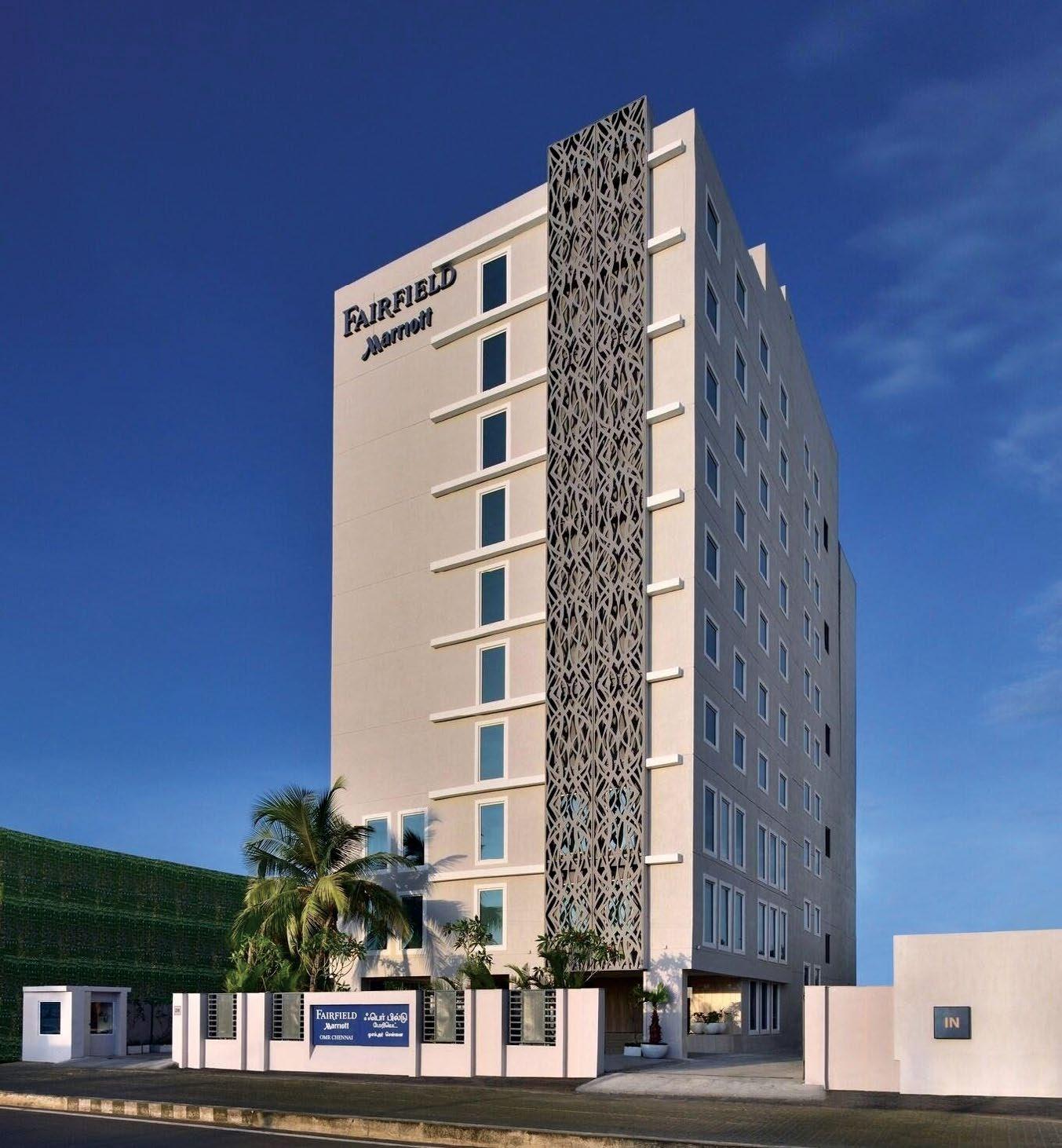
ASHISH JAKHANWALA
How do you approach success and failure?
With indifference. My team will tell you—we don’t celebrate much. When an IPO is launched, most companies throw lavish parties, fly to the Maldives, ring the bell, and so on. We rang the bell, had a quick meeting, had a small lunch at a restaurant, and went home. I manage third-party capital. So just as we didn’t celebrate excessively, we didn’t mourn excessively during COVID either. We approach both with professional indifference— focused on doing the job well, without letting outcomes rattle or excite us too much.
You’ve always had a fondness for literature. Do you still read? What was the last book you read?
I grew up in the mountains, which naturally nurtures a sensitivity to art and literature. In school, my English teacher was convinced I’d pursue an MA in English and become a professor. My wife disagrees—because I can’t spell properly!
Even though SAMHI’s approach is data- and numbers-driven, our day-today work is often creative. I still love to write. These days, instead of poems, I make PowerPoint presentations— but the emotion behind them is the same.
I always say: that without imagination, you can’t be a great businessman. That applies to entrepreneurs, CEOs—anyone leading a business. Imagination isn’t fantasy; it comes from what you see, hear, read, and experience. When you process that through imagination, it fuels growth.
But I’m a bad reader now. I absorb more from documentaries than books. My attention span is goldfishlike. I haven’t watched a movie since Cinderella in 2016. Even a Netflix series—45 minutes is too long. Now, 100% of my content is YouTube documentaries—7 to 20 minutes, all nonfiction. I don’t enjoy fiction—it’s too neat. I watch videos on architecture, finance, leadership, and business. No social media— just YouTube.
Who has inspired you over the years?
Different people at different stages. Early on, it was the U.S. startup culture—Silicon Valley icons like Peter Thiel. As I matured, I was drawn more to traditional Indian business leaders like Uday Kotak and Narayana Murthy. Their grit, discipline, and the institutions they built are truly inspiring.
I believe your sources of inspiration should evolve. If they don’t, you risk chasing outdated ideals. I used to admire the “fail fast” mindset. Now, I’m more conservative—I don’t want to risk what I’ve built. I’m okay with being boring.
Today, I admire companies like the TVS Group—quiet, elegant, no noise. What Mr. Kotak and Infosys have created—those are the benchmarks. For SAMHI to become a truly great company, we need to evolve to that level of maturity.
What’s your idea of a vacation? Do you even take vacations?
Not really. I do now—because of my daughter. I love spending time with her. But over the last 20 years, I’ve taken maybe six or seven vacations. And even those are short—leave Saturday, return Thursday or Friday.
If you need festivals or vacations to escape, maybe you need to rethink your daily life. For me, Monday mornings are exciting. I love coming to work, being around people I care about, and doing something that inspires me. Being away from that isn’t always pleasant. I grew up in the mountains and have a home there. I go back every six to eight weeks for a day or two. That’s my real downtime. It reminds me of life without Amazon, Blinkit, Zomato. I’m not into luxury vacations— another hotel, another flight? That’s not a break for me.
What’s one personal hobby or ritual you make time for to unwind?
I enjoy cooking—and driving, especially to the mountains. It’s a seven-hour drive where I can’t check emails or take calls. Just me and the road. That quiet time helps me think.
Where did you learn to cook?
I went to hotel school—but no one actually learns to cook there! I started cooking out of necessity. I lived alone and needed to feed myself. In fact, hotel school made my cooking worse—I had to unlearn everything and start over.
Now, cooking is like meditation for me—without the stillness. I can’t sit with my eyes closed and meditate. Tried it—it gave me a headache. But cooking and driving quiet my mind while keeping me active.
While we don’t currently have a presence in leisure, we clearly see the opportunity. So far, our focus has been on core office markets and business hotels, where we already have a strong footprint.
Over the longer term, we expect some Tier 2 and Tier 3 cities to reach the kind of scale we now see in metro micro-markets. For instance, Whitefield in Bangalore has comparable hotel demand to an entire Tier 2 city like Coimbatore. These emerging cities could eventually match metro submarkets in hotel supply and performance.
That said, we’re not quite ready to invest heavily in Tier 2 and 3 cities today. But we know that as India grows, new kinds of opportunities will emerge. We need to stay agile and honest—never get myopic about what we’ve been doing. As long as the board and management stay responsive to change, companies like SAMHI will keep growing for the next two or three decades.
For now, our focus remains on business hotels in core office markets—and that likely won’t change for the next 24 months. But we’re closely tracking the evolution of the leisure space and the potential for Tier 2 cities to transition to Tier 1. It’s not unlike how private equity works—some investors focus on mature markets, others bet on emerging ones poised for transformation.
India is attracting substantial global capital because investors believe we’re on track to shift from a low-income to a middle—and eventually a high-income economy. Getting into pole position early in that transition can yield multifold returns from relatively modest investments. That’s the kind of forward-looking thinking we need when evaluating cities.
Will Ahmedabad break the mould and become a major metro? Will Coimbatore evolve into a mini metro? We’ve made early bets in Vizag, Coimbatore, and Ahmedabad—but about 80–85% of our revenue still comes from expected markets: Hyderabad, Bangalore, Pune, Delhi, and Chennai.
We’ve made small, strategic bets in emerging cities, hoping some break out and become mini metros. And there is growth—we’re seeing new businesses—but the scale is still smaller compared to cities like Hyderabad or Bangalore.
Let’s not forget, that India originally had just four metros: Delhi, Bombay, Madras, and Calcutta. In the late '90s and early 2000s, Pune, Bangalore, and Hyderabad were still considered mini metros. Fast forward 20 years and Bangalore and Hyderabad have surpassed Chennai and Kolkata in several ways.
In my view, the top four metros today are Delhi, Mumbai, Bangalore, and Hyderabad. The next three mini metros would be Pune, Kolkata, and Chennai. Eventually, I believe all seven will be major metros. In fact, Chennai and Kolkata are already undergoing significant transformations. Urbanisation will only accelerate—and that ensures Tier 1 markets will keep emerging. We won’t be short of cities where we’d want to build hotels.
Your acquisition-led strategy has always stood out. Why did you choose that route over building new hotels from scratch?
Honestly, because I value my time. In family-run businesses, even if it takes five to ten years to build an asset, there’s comfort in knowing it will be passed on to the next generation. But I represent institutional investors. If I told them, “We’ll deploy capital today and see real value in six or seven years,”—well, they’d probably have better uses for their money.
That’s why we generally avoid greenfield development. There are too many variables—and any one of them can derail a project. I have a fiduciary responsibility to protect investor capital.
Also, India is still vastly under-penetrated in good-quality asset management—not just in hospitality. Look at what PVR did with cinemas. They went into city centres in Lucknow, and Kanpur, took over rundown theatres, transformed them—and suddenly, you had a glitzy PVR selling popcorn at ₹200–300.
So, if your goal is to build a scalable, capital-efficient company, acquiring and upgrading undervalued assets is a proven global strategy. We were the first to execute it at scale in India. Until four or five years ago, no one was really talking about buying hotels here. I’m glad we’ve helped shift that conversation. Today, more players are buying rather than building.
For us, the risk-reward ratio in acquisitions has always been more attractive. In nearly every case, we can buy a three-star hotel at a three-star valuation, invest in upgrades, reposition it as a four- or five-star property, and still keep our total cost well below what it would take to build the same hotel from scratch.
Essentially, we’re creating capacity at a discount to replacement cost—and that principle is central to our strategy at SAMHI.
When you began SAMHI, was there a larger vision about the direction in which India’s hotel industry would head?
We’re talking about 2010—just the beginning of the industry’s emergence. It was clear even then that this sector would grow. Yes, there are cyclical ups and downs in performance, but structurally, we believed that if the Indian economy was going to grow, so would the hotel industry.
We also felt there was a need to bring in institutional capital and a structured approach. When you combine the scale opportunity in India with that kind of capital and discipline, we are confident in the strategy. And honestly,
it has played out quite well. COVID was a temporary disruption, but beyond that, the strategy has worked.
We’ve built a company of scale. We’ve been in business for 14 years, and in terms of revenue, we rank as the sixthlargest. What’s notable is that among our peers with similar revenue, the youngest company is 28 years old—others are 33, 40, or even 50. So reaching this scale in just 14 years validates our acquisition-and-turnaround-led strategy.
Sam Zell—who was our shareholder for the longest time and a fantastic advisor—used to say, “Too much of a good thing is only wonderful.” Just because something’s been working doesn’t mean you need to change it. If it works, double down. And that’s exactly what we’ve done.
We don’t approach it on a deal-by-deal basis. We build long-term partnerships, and keep the conversations open with potential new partners. The brands we work with must have a strong industry reputation, global distribution, robust loyalty programs, and a reliable, experienced team on the ground in India. We also ensure visibility into their hierarchy—right up to the top.
We typically don’t take chances with companies where we don’t have access to top leadership. But honestly, it’s not rocket science. We genuinely value and enjoy the partnerships we have.
Would you ever consider working with a new or upcoming brand?
I hope not. And I say that because it’s easy to get carried away. But we have a strong board that keeps me in check. We’re a board-driven company, and we’re clear that our hotels should be managed by operators with proven longstanding reputations.
We absolutely support new concepts and the entrepreneurial ecosystem—but not at the cost of putting our assets at risk. I manage third-party capital. Choosing an operator is one of the most critical decisions in the lifecycle of an asset. So we prefer to play it safe there.
You recently formed a joint venture with GIC for five hotels, valued at around ₹ 2,200 crore. How does that align with SAMHI’s long-term goals?
Hotel investments are highly capital-intensive, and this deal allowed us to solve several things at once. We had relatively high debt on our books, which limited the free cash available for growth—since much of it went to interest servicing.
“
Taking a company public is like organising an Indian wedding. I often say we spend more energy on the wedding than on the marriage that follows. And going public isn’t all that different. Many promoters get excited about an IPO, but at its core, it’s just a means to raise capital.
By selling a 35% stake in three of those five hotels to GIC, we raised about ₹750 crore—of which roughly ₹600 crore went toward debt reduction. That frees up future cash flows, which we can now reinvest in growth. We now have GIC as a partner—an institution of great repute. In a 65:35 model, every ₹65 we invest could be matched by ₹35 from them.
That multiplies our capital and enables faster scaling.
Upscale hotels also demand significant investment—₹200, ₹400, sometimes ₹600 crore per property. Having a sovereign partner like GIC, with watertight governance and processes, adds both oversight and credibility. It’s a strong value addition.
We’ve known GIC for a long time—they’re a blue-chip, Grade-A partner. For many reasons, this was a milestone transaction for us.
You went public in 2023. What was that experience like? How has it helped grow your business?
Taking a company public is like organising an Indian wedding. I often say we spend more energy on the wedding than on the marriage that follows. And going public isn’t all that different. Many promoters get excited about an IPO, but at its core, it’s just a means to raise capital.
The big difference is this—when a company is 100% promoter- or family-owned, it’s often run on their terms, with minimal external oversight. But once you’re public, it’s a different ballgame. You’re constantly answerable—investors watch closely, analysts ask tough questions and governance standards rise significantly.
In our case, though, we already had institutional capital from day one. We were operating with strong governance, rigorous reporting, and external scrutiny well before the IPO. So the transition to a public company was seamless. It wasn’t a dramatic shift, just a natural next step.
While many would consider an IPO a major milestone, to us it felt like part of a longer journey. Before going public, we had already raised capital from global names like GTI, Equity International, IFC Washington, and Goldman Sachs. The IPO was simply a continuation of that trajectory.
That said, running a public company is different. With a private company, you can take the occasional nap. With a public company, you can’t—you need to be alert and on your game 365 days a year. It forces sharper thinking and faster execution.
To any entrepreneur considering an IPO, I’d say: make sure you have the stamina to run—and keep running. Once you start, there’s no pause button. Either build that endurance yourself or create a leadership relay with a strong succession plan. But slowing down isn’t an option.
Do you think public markets are the way forward for the hospitality industry? Will more hotel groups go public to expand?
If the goal is genuine expansion, going public is a great move. But I worry some do it for fashion. It’s like dressing up for school in designer clothes—you’re meant to wear a uniform. Going public should be about substance, not style.
If you’re raising capital with the intent to grow the business profitably and deliver long-term value to shareholders, public markets are a fantastic platform. But if the motivation is to ride a trend or chase overnight wealth, that’s a shallow reason to access something I consider quite pure.
Yes, it’s a trading floor—but when you're dealing with public investors, you need to think like a public servant. You’re managing third-party capital. It’s not just your money. I always caution founders: only go public if you’re committed to building and growing the business over the next 10 to 20 years. If it’s just about catching a wave, it won’t end well.
We’ve seen rapid investment and growth in India’s hospitality industry. Do you think this momentum is sustainable?
If India keeps running, we’ll keep running. As long as the economy grows—and I believe it will—the hotel industry will follow. If India stops, everything stops. We’re betting on India, and I think it would be foolish to bet against it. It’s a simple, binary bet, and I don’t want to be on the wrong side of it.
Look at global data—between 2024 and 2034, the travel and tourism sector is projected to grow at twice the rate of global GDP. That’s where my optimism comes from. If India maintains steady GDP growth over the next two decades, the hotel sector will grow at a multiple of that—whether 2x or 1.5x, time will tell.
What will really matter is execution and discipline. It won’t come down to a clever strategy or special intelligence. It will require simple, focused intelligence.
What advice would you give to young entrepreneurs entering India’s hospitality investment space?
This industry is both capital- and operations-intensive. Hotels empty out every day—and every day, you have to fill them again. That’s 365 days a year. It’s relentless.
Each hotel demands crores in investment. My advice: build experience first. This isn’t just a slippery slope—it’s a road without guardrails. One bad fall can be fatal. There’s too much capital at stake, and you need deep operational insight. No matter how smart you are or what your Harvard score was, hands-on knowledge will serve you better here.
Maybe I’m wrong—kids today are incredibly smart. But since you asked for advice, mine might be a little dated.
Looking back, is there anything you would have done differently in your journey with SAMHI? What’s the biggest lesson you’ve learned as an entrepreneur?
An entrepreneur’s life is full of mistakes. You could put me on every cover for two years and I would continue to talk about the mistakes and what we learned! And I’d wear those mistakes on my sleeve. They were honest mistakes. No regrets.
If I had to start SAMHI from scratch, I’m not sure I’d get here again. I don’t have a playbook that guarantees a better outcome the second time around.
But can I do better in the next 10 years? Absolutely. We’ve learned, and we’ve built strong teams, systems, and data. The building blocks are in place. That’s why I believe SAMHI is at a transformational point—we’re poised to double every four to five years.
Could I undo some mistakes? Sure. But I wouldn’t trade the wins: world-class investors, a team that’s stayed with us for 14 years, and operating partners like Marriott, Hyatt, and IHG who stood by us through thick and thin. I wouldn’t give any of that up just to fix a few errors.


Ashish Jakhanwala once got a 150-room Fairfield by Marriott up and running in just 21 months. That’s faster than most people can organise a destination wedding.
He calls SAMHI a “follower globally, but a disrupter locally,” shaking up India’s hospitality scene with institutional ownership and a datadriven approach.
Jakhanwala has a sixth sense for picking prime locations. He’s got hotels in 12 cities like Bengaluru, Chennai, and Pune, where demand’s so high you’d think he’s got a crystal ball.

Founded on a philosophy of spiritual luxury and mindful living, Ananta Hotels & Resorts is writing its own script—steadily carving a niche across a few unexplored corners of the country.
DEEPALI NANDWANI
Village Guwara Kundal feels like a destination suspended in time. The road from Jaipur winds through small towns, dusty plains, nondescript villages, and lush fields, until you reach another quiet hamlet—home to what can be described as a contemporary boutique eco-resort, infused with Rajasthani flourishes in its architectural language: Ananta Resort & Spa, Ajabgarh.
Ajabgarh is famous for two attributes—Amanbagh, one of Aman’s only two properties in India, and its proximity to Bhangarh Fort,
infamous for being haunted by souls lost centuries ago. One of its most enduring legends is that of Princess Ratnavati, famed for her beauty and pursued by royal suitors across the land. Among them was a sorcerer skilled in black magic, who became obsessed with her.
One day, as the princess shopped with her companions, he saw her buying ittar (perfume) and secretly infused the vial with a love potion. But Ratnavati saw through the trick and flung the vial onto a nearby boulder. The magic backfired, sending the boulder crashing down on the sorcerer. With his dying breath, he cursed the city, declaring it would fall into ruin and remain uninhabited forever. As the legend goes, the fort was later plundered by Mughal forces, who killed all its inhabitants, including the princess.


As experiential travel expands across India and hotels seek out emerging destinations, Ajabgarh has caught the industry’s attention. Research shows several groups, including IHCL, are eyeing the region. For now, the ecoluxury Ananta Resort & Spa is in a position of advantage, particularly in the area it is loacted—true to form for the brand in most resort markets. Though positioned as wellness retreats, Ananta's properties go beyond, embodying slow travel and mindful luxury.
The road to this quiet corner of Ajabgarh—near villages of weavers, 17thcentury forts, ancient temples like the Raghunath Temple, and the oncedenuded, now-thriving Sariska Sanctuary—is winding, then suddenly opens into a sunlit expanse. The hotel sprawls across 30 acres, its sand-coloured structures nestled among landscaped gardens, framed by the Aravalli hills. In the early morning, the light over the hills and resort has a diffused, almost numinous quality. Another 70 acres remain untouched, cloaked in lush greenery and forested tracts.
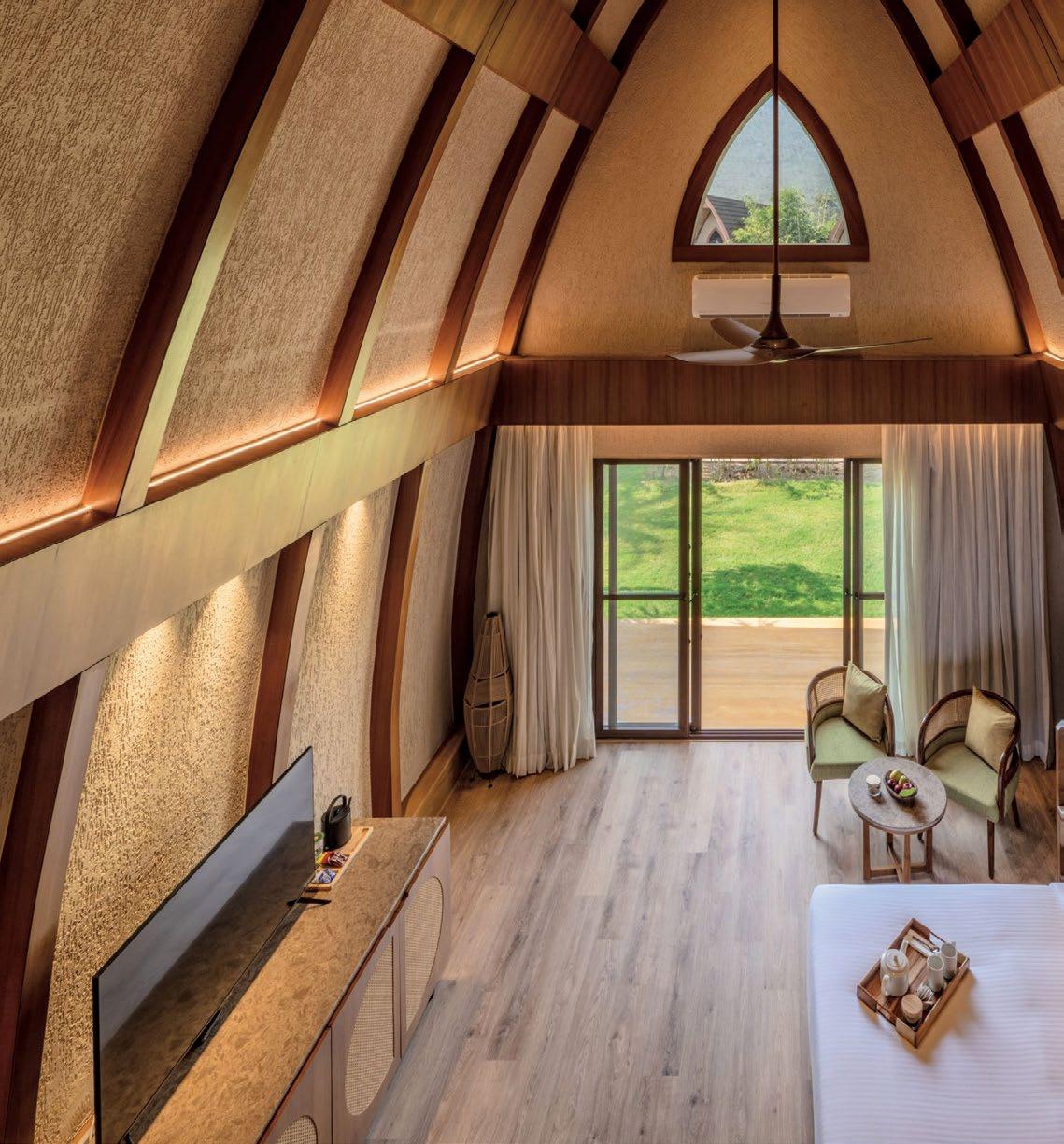

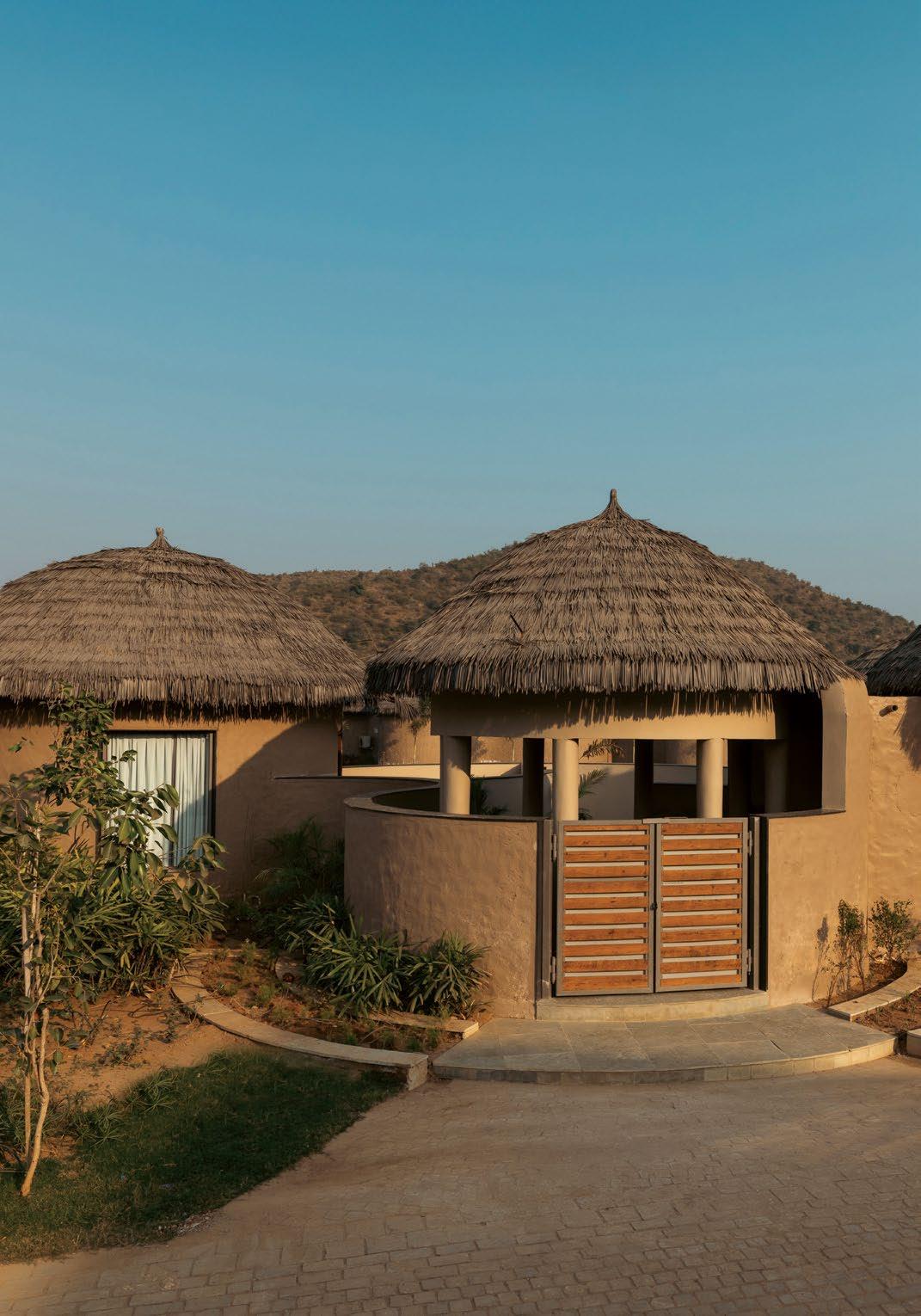
In a state dominated by havelis, palaces, and forts turned into hotels—or new builds echoing traditional design—Ananta stands apart with its modern flourishes and organic minimalism. The Bamboo Villa, for instance, is a conical, tunnel-like structure with vertiginous ceilings and a cosy loft. The Fire Villas are starkly cubist, with outdoor sit-outs. Earth Villas blend mudplastered walls with thatched roofs over concrete slabs, while the tropical Lagoon Villas float in a lotus-strewn pond. Each speaks the language of minimalism and sustainability, using eco-conscious materials like bamboo and mud, and practices that honour the natural landscape. “At Ananta, community engagement is not a CSR checkbox; it’s integral to our business model. From employing local artisans and farmers to sourcing textiles, food and decor from within the region, every property becomes a microecosystem of empowerment,” says Ananta’s Director Mukul Goyal.
There are, of course, Rajasthani flourishes—how can there not be? The Mughal-Rajasthan design language is vivid and ever-present, echoing through buildings both ancient and modern. The Earth Villas, with their mud-plastered walls, reflect the region’s rural architecture, while palmthatched roofs draw from traditional Thar desert homes. Warm, earthy tones—terracotta, beige, ochre—define the palette. Private patios nod to the open courtyards of Rajasthani havelis. The Lagoon Villas, inspired by Maldivian overwater retreats, feature delicate jaali work. Over in the auditorium, where author Tripti Pandey read from The Half Empress, a beautiful Jaipuri cotton textile drapes the ceiling. Ashutosh Goyal, Director, Ananta Hotels & Resorts, says, “At Ananta Spa & Resort, Ajabgarh, the architecture reflects the five elements. Our Fire Villas evoke energy and creativity; the Lagoon Villas represent healing and calmness. Natural materials like Eta gold limestone, bamboo and local wood blend into the landscape rather than disrupt it.”


OPPOSITE: The starkly cubist Fire Villas evoke energy and creativity.
ABOVE: The mud-plastered walls and thatched roofs of the Earth Villas at Ananta Spa and Resort Ajabgarh are informed by vernacular architecture of the region.
LEFT: The spacious interiors of a Bamboo Villa also include a loft.
The resort leans into experiences to offer deeper insight into the destination—like visits to nearby villages to meet weavers whose rugs are sourced by some of India’s top brands. Among them is Meena, who supports her family and educates her children through the craft she learned at her maternal home. Storytelling is at the heart of the Ananta Ajabgarh experience—tales of kings who built the region’s forts and temples, legends of the haunted Bhangarh Fort, and age-old stories of valour and beauty.
Within the resort, the experience flows from the spa to the community space—where book readings, workshops, and events are hosted—to the restaurant, where food plays a central role. Evening tea is a generous affair, laden with local snacks like Pyaaz ki Kachoris and stuffed Mirchi Bhajias. The Rajasthani dinner is equally indulgent and traditional: Lal Maas, Ker Sangri, Besan Gatta, Dal and Bati Churma, Bajre ki Roti, and Mirchi ke Tipore. This contemporary oasis, with its eco-conscious villas and Rajasthani touches, curates an experience that blends the stories of weavers, warriors, and haunted ruins with the quiet serenity of the Aravalli hills.
The Ajabgarh resort reflects Ananta Hotels & Resorts’ core strategy: sustainable properties in serene, often unexplored locations, with a deep connection to nature and cultural heritage—Udaipur being the rare exception. The focus is on high-end stays set in lush, tranquil landscapes.
Ananta’s portfolio now spans 12 hotels and resorts, in destinations like Jaipur, Udaipur, Pushkar, Ranthambore, Ajabgarh, Jaisalmer, Kasauli, and Shimla, with upcoming launches in Kumbhalgarh, Tirupati, Indore, Karjat, and Shirdi. As the group continues to pioneer lesser-known destinations—from Ajabgarh to Kumbhalgarh and beyond—it reimagines hospitality, blending nature and tradition to draw travellers into India’s unexplored corners.
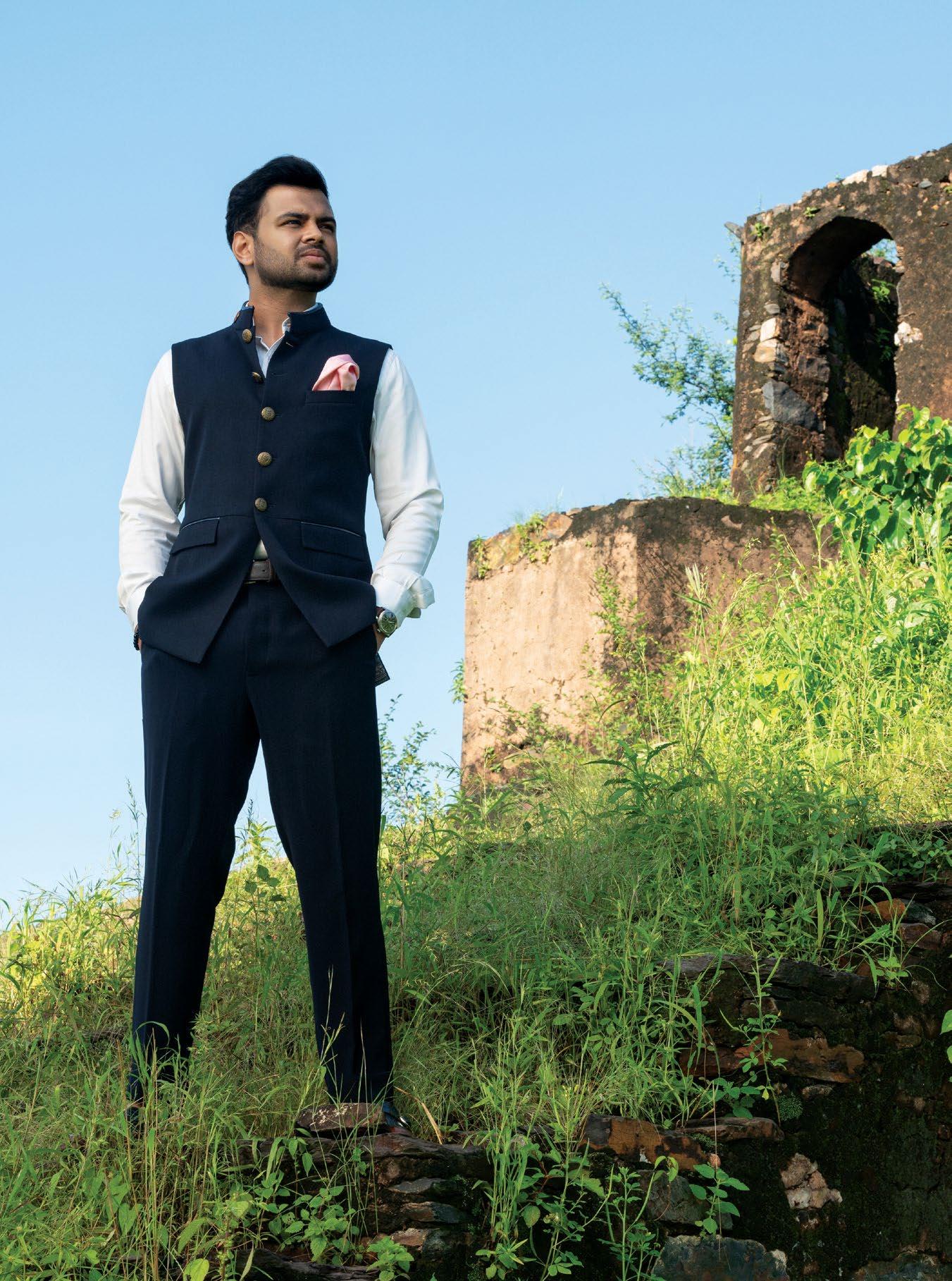
Can you tell me about the genesis of Ananta—when and where was the first hotel established? How has Ananta’s journey evolved since then?
Ananta’s story began not as a commercial venture, but as a deeply personal calling. It was my grandfather, Mukund Goyal, who laid the foundation of this legacy, guided by his belief that hospitality could transform both people and place. The first property, Ananta Spa & Resort Pushkar, opened in 2010—amid scepticism and an economic downturn. But he saw what others didn’t: the power of spiritual destinations, the potential of resort culture in India, and the value of connecting travel with introspection. Since then, Ananta has grown from a dream into a portfolio of luxury resorts, wildlife lodges, and experiential retreats. Each property carries forward that original vision—redefining hospitality through stillness, design, and soul.
How large is Ananta’s hotel network today, and what’s driving the plan to add 40 hotels and triple revenue in five years? What investments are being made, and how are funds being prioritised?
Today, Ananta Hotels & Resorts is a growing network of
He speaks to SOH about the group’s sustainable architecture and close-to-nature philosophy, as well as its expansion plans.
operational and upcoming properties across Rajasthan, Maharashtra, Gujarat, and beyond. With 12 assets currently in operation, we’re well on track to achieve our five-year vision: 40 properties and a threefold revenue expansion. But our growth is guided, not aggressive. We invest where stories can be told— places like Ajabgarh, Karjat, and Jaisalmer—where landscapes meet legacy. Capital is being channelled into three verticals: greenfield development in highpotential, offbeat locales; renovation of existing assets with strong character; and tech-integrated guest experiences.
How do you define the Ananta brand today, and what core philosophy drives it?
At its core, Ananta is about timelessness—a space where wellness, design, and experience come together to rejuvenate the body and stir the spirit. Our brand isn’t defined by wellness or luxury alone; it’s about embracing a mindful lifestyle. Ananta doesn’t offer escapism—it offers reconnection: with nature, culture, and self. Our positioning is rooted in spiritual luxury— subtle, immersive, and deeply personal. Whether meditating in a private garden in Udaipur, spotting tigers in Ranthambore, or sipping a rose-infused
cocktail in Pushkar, you're part of an experience that’s both curated and intimate.
Could you tell me about the design and architectural ethos of Ananta Hotels?
Design at Ananta is never purely aesthetic—it’s a dialogue between terrain, tradition, and tranquillity. At Ananta Spa & Resort, Ajabgarh, the architecture reflects the five elements: Fire Villas evoke energy and creativity; Lagoon Villas embody healing and calm. Natural materials like Eta gold limestone, bamboo, and local wood blend seamlessly into the landscape. At The Ananta Udaipur, our vision was a private sanctuary spread across 98 acres—Balinese-inspired villas with stonework and a gravity-fed water system designed to disappear into the hills, not dominate them. In Pushkar, design reimagines rustic luxury with courtyard-style cottages opening into rose gardens, symbolic of the town’s spiritual bloom.
You’re targeting Tier-II cities and offbeat destinations such as Ajabgarh. What
“
Tier-II and offbeat locations offer qualities that luxury travellers seek more than marble lobbies.
”
BELOW LEFT:
Like all Ananta properties, the Ajabgarh one is set in a destination rich in cultural and built heritage.
BELOW RIGHT:
The luxury resort indulges its guests with delectable traditional fare.
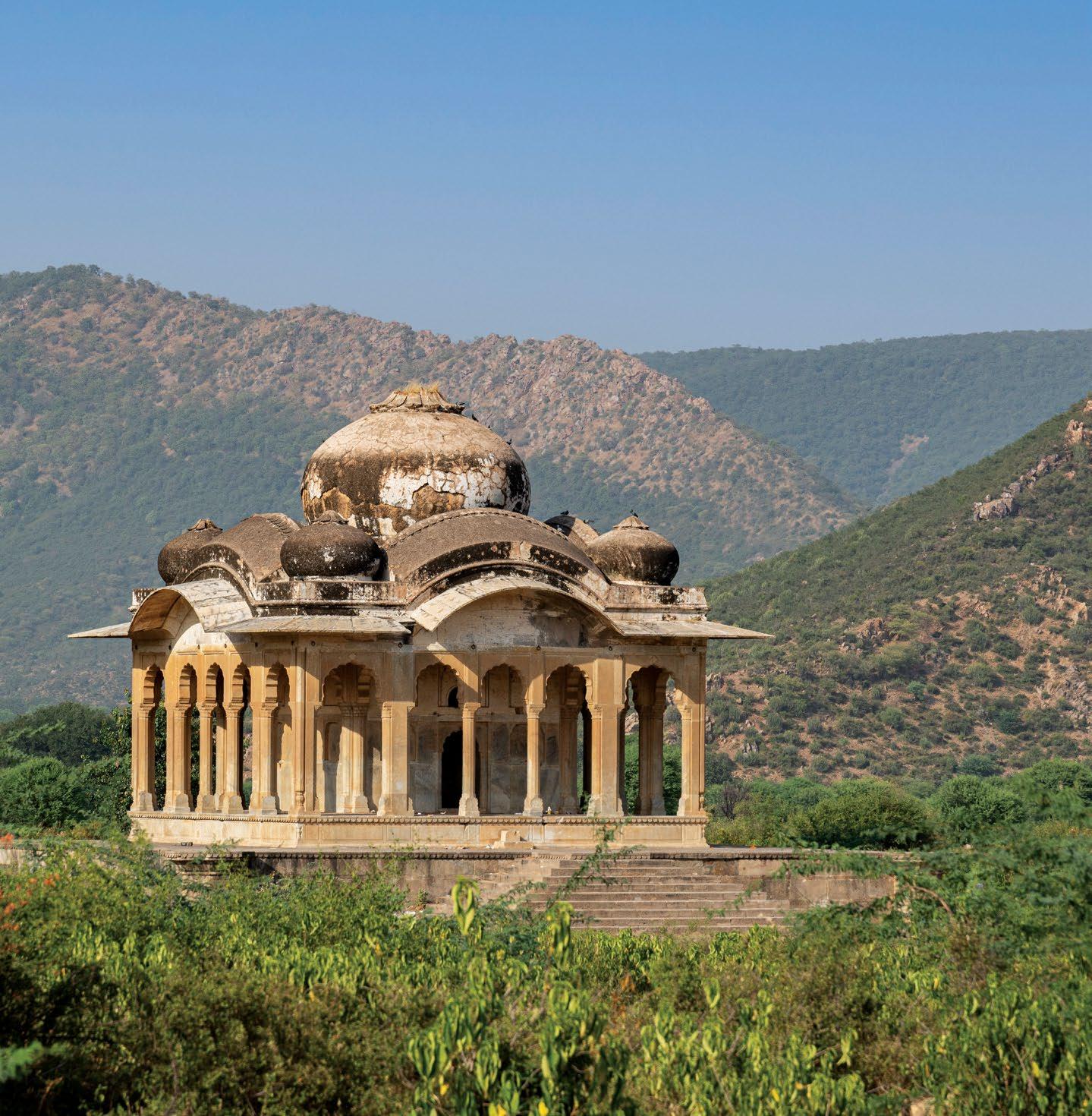
opportunities do you see in these markets and how do you differentiate Ananta from competitors in such locations?
India’s true travel renaissance lies in its untold stories. Tier-II and offbeat locations like Ajabgarh, Karjat, or even Gir offer authenticity, cultural richness and unspoiled beauty; qualities that luxury travellers now seek more than marble lobbies. These destinations allow us to create immersive stays that connect with the land. What differentiates Ananta is not just where we go but how we design through local materials, regional cuisine and contextual storytelling.
Do offbeat destinations present challenges, such as logistics, labour, or marketing? How are you addressing these?
Yes, offbeat locales come with challenges—especially in infrastructure, talent acquisition, and marketing. But every challenge holds the seed of innovation. In Ajabgarh, for instance, we faced power and transport constraints, which we addressed through solar integration, gravity-fed water systems, and partnerships with local vendors to build a communityrooted supply chain. We're also developing a skilled talent pool from within these regions, ensuring our properties don’t just serve the land—they belong to it.
Eco-consciousness seems to be a big part of your approach. Can you elaborate on the sustainable practices—during both construction and operation—implemented across properties?
Sustainability isn’t a feature at Ananta—it’s part of our DNA. In Ajabgarh, landscaping with native plant species preserves micro-ecology and reduces water use. In Udaipur, over 10,000 trees form a natural green lung. We’ve integrated solar power, greywater recycling, and zero-waste kitchens across multiple locations. Our goal is carbon neutrality across all assets within the next decade. And through our Great Indian Bustard Conservation Initiative at our wildlife lodges, we affirm our belief that hospitality must give back—not just in smiles, but in ecosystems restored.

He speaks to SOH on ownership models, environment sustainability, and balancing innovation with tradition.
Do you primarily own your hotels, or follow a mixed ownership and management model? What’s in the pipeline?
Ananta follows a blended ownership model—a strategic choice that allows us to preserve our brand DNA while scaling with agility. Our flagship resorts in Pushkar and Udaipur are self-owned and serve as benchmarks for the Ananta experience. Meanwhile, our management portfolio is expanding rapidly. Under our Global Hospitality initiative, we’re partnering with distressed assets and independently-owned properties, helping them rise to the Ananta standard through design, service, and operational upliftment.
Our pipeline reflects a philosophy of immersive expansion, not growth for its own sake. Projects in Jaisalmer, Karjat, and Somnath are in advanced planning. We’re also exploring international opportunities in spiritual and wildlife-rich destinations that align with our ethos of ‘luxury with soul’.
Beyond environmental sustainability, how does Ananta contribute to supporting and empowering local communities around your properties?
True hospitality must uplift not only the guest but

the ground it stands on. At Ananta, community engagement isn’t a CSR checkbox—it’s central to our business model. From employing local artisans and farmers to sourcing textiles, food, and décor regionally, each property becomes a micro-ecosystem of empowerment. In Pushkar, we support rose cultivators and employ local musicians to infuse guest experiences with cultural authenticity. In wildlife destinations like Gir and Ranthambore, we’ve partnered with forest departments to promote conservation education and hire naturalists from nearby villages. These aren’t just practices—they’re the stories our guests take home.
As a family-run business, how are you balancing tradition with innovation?
How is the next generation honouring the founder’s legacy while shaping the brand’s future?
Navigating a family-run business across three generations demands more than succession—it demands synergy. We see tradition not as a tether, but as a root from which new branches grow. Our grandfather, Mukund Goyal (Chairman, Ananta Hotels & Resorts), instilled purpose and values; our father,

“What sets Ananta apart is our blend of spiritual depth, design intelligence and ecological foresight.”

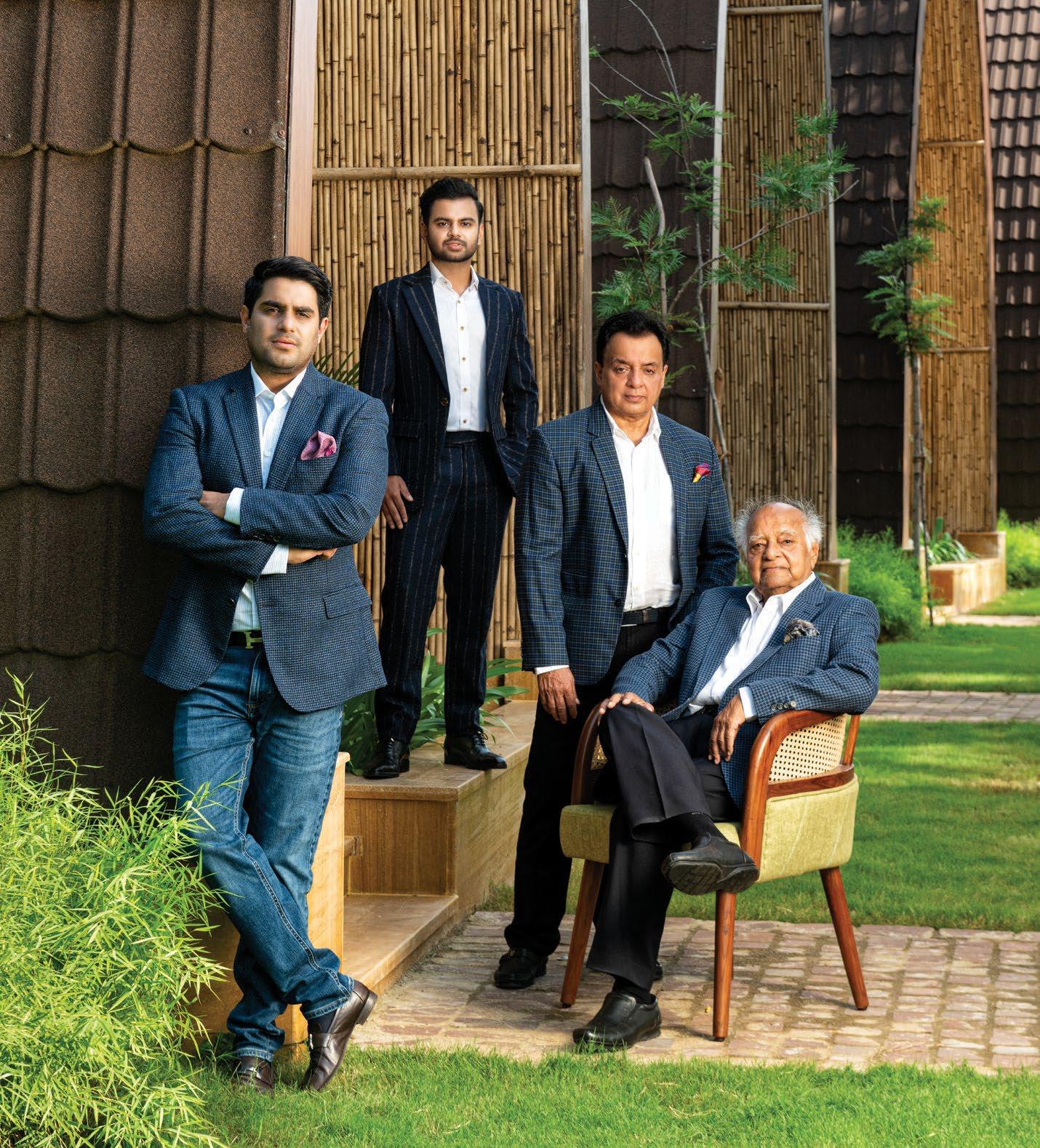
Sanjay Goyal (Managing Director), brought structure. Our role has been to infuse innovation, scale, and global sensibilities.
From investing in digital transformation and expanding into new markets to integrating sustainability metrics into our operational dashboards, the next generation is actively shaping Ananta as a future-facing, heritage-honouring brand. Yet, every step forward carries the soul of our origins.
What has been the most challenging moment in leading Ananta so far and how has it shaped your leadership style and the company’s direction?
Perhaps the most testing moment was the pandemic— an era that froze travel but unfroze a thousand anxieties. For a brand rooted in experiential luxury and human interaction, it meant realigning everything from safety protocols to staffing and financial resilience.
But the crisis, as I’ve learned, is a crucible. It taught us the art of adaptation. We introduced contactless hospitality, reimagined spaces for staycations and digital nomads, and launched wellness-forward packages to meet a changed guest psyche. That period cemented my belief in empathetic leadership—one that blends decisiveness with compassion. We not only protected jobs but upskilled our teams and kept Ananta’s emotional engine alive.
India’s tourism sector is booming but still faces infrastructure challenges. How is Ananta navigating these while delivering a world-class experience?
India is entering its golden decade of tourism, but infrastructural inconsistencies remain a bottleneck. At Ananta, we mitigate these through self-sufficiency; our properties are often designed to be self-contained ecosystems. Solar grids, gravity-fed water systems and private experiences ensure that our standards are not held hostage to external inefficiencies.
What sets Ananta apart is our blend of spiritual depth, design intelligence and ecological foresight. We are not a chain of hotels; we are a constellation of stories. Each property is anchored in its landscape, its community and its own rhythm. What makes me proudest? Guests return year after year, not just for our views or our food but because they say Ananta feels different. That emotional resonance is our true metric of success.
In the decade ahead, we envision Ananta as India’s most respected eco-luxury hospitality brand, one that contributes not just to GDP, but to the global understanding of India as a place of beauty, depth and warmth.

Global hospitality brands are embracing cultural preservation beyond architecture. Reviving local arts and crafts can become a new frontier in authentic luxury experiences.
CHANDREYI BANDYOPADHYAY



GENERAL MANAGER, TAJVIEW AGRA
“For us, opulence serves a higher purpose, each decorative element a deliberate homage to the artistic legacy of Agra's master craftsmen.”

CREATIVE HEAD, RELAIS & CHÂTEAUX HOUSE OF ROHET
“To exist without cultural context is to build spaces that are hollow—decorative but disconnected.”

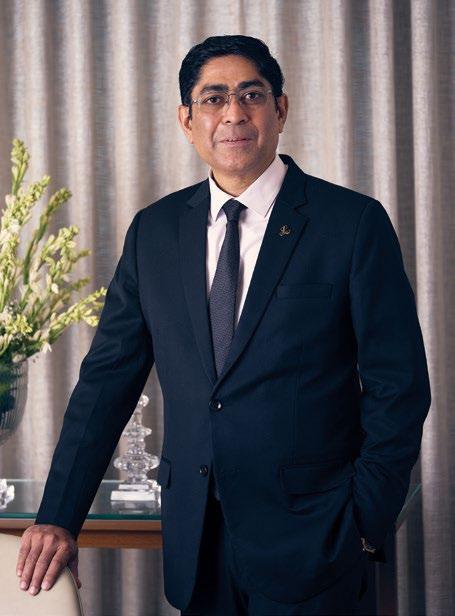
GENERAL MANAGER, THE LEELA HYDERABAD
“In culturally rich regions like Southeast Asia, luxury hotels have both the privilege and responsibility to actively contribute to the preservation and revival of these endangered crafts.”
PRIYA PAUL CHAIRPERSON, APEEJAY SURRENDRA
PARK HOTELS LTD.
“By carefully turning historic spaces into living stories, that are Anything but Ordinary™ experiences for those who seek a unique blend of history, art, and culture."
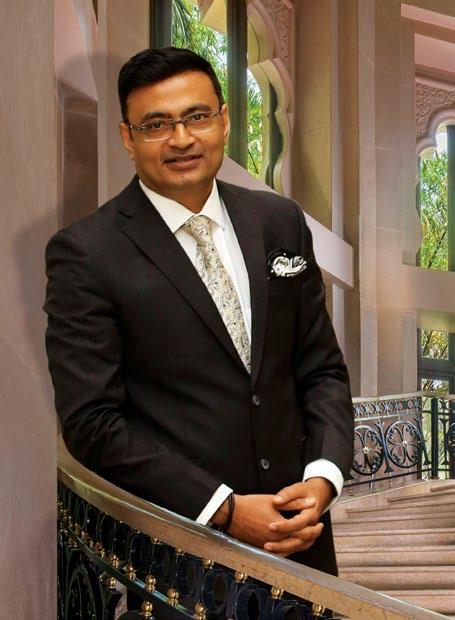
ANURAAG
BHATNAGAR
CHIEF EXECUTIVE OFFICER,
THE LEELA PALACES, HOTELS AND RESORTS
“Hospitality owners possess a distinct opportunity to reshape the trajectory of cottage industries, not just by showcasing local crafts, but by embedding them into the very fabric of luxury experiences.”
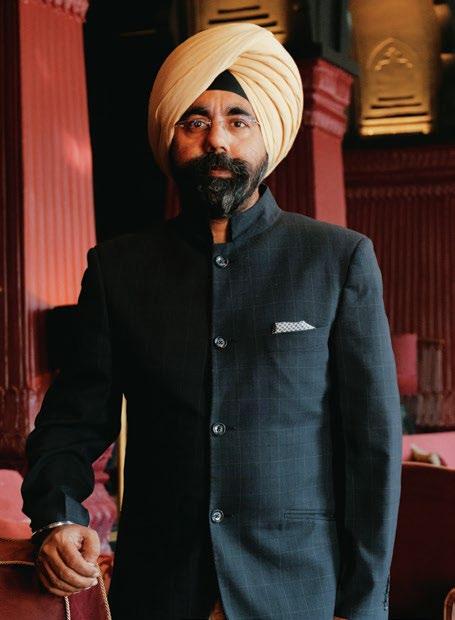
DEEP MOHAN ARNEJA
GENERAL MANAGER, RELAIS & CHÂTEAUX RAN BAAS, THE PALACE
“While areas such as supply chain, product standardisation, and digital accessibility need more structure, these are where innovation and collaboration can thrive.”

ASHISH GAWARI
GENERAL MANAGER, dusitD2 FAGU
“We are focussed on introducing properties that resonate with the aspirations of modern travellers seeking authenticity, tranquility, and transformative experiences.”
Beyond marble lobbies, ornate chandeliers and plush bedding, India's luxury hotels are embracing a profound new purpose—of becoming living museums where ancient crafts breathe and traditional artistry flourishes against contemporary backdrops. As globalisation threatens to homogenise cultural experiences, hotels today emerge as unexpected sanctuaries of heritage, where forgotten crafts find voice as skilled hands continue centuries-old traditions.
Once the exclusive domain of boutique properties, cultural stewardship flourished naturally within the intimate confines of Rajasthan's heritage havelis and Madhya Pradesh's wilderness retreats. Homegrown brands like CGH Earth, Brij Hotels, and Pugdundee Safaris established their identities through profound community connections, weaving local traditions into immersive guest experiences.
A remarkable transformation now ripples through the hospitality landscape. Luxury giants and international flagships—once defined by standardised opulence that could exist anywhere—are embracing regional authenticity with passion. This shift reflects more than shrewd business calculus capturing the experiential travel market, signalling a deeper awakening to their role as custodians of cultural bequest. Brands are increasingly recognising that true luxury lies not in isolation from their surroundings but in meaningful celebration of the cultural soil from which they rise—a responsibility to heritage that enriches both guest experience and community legacy.
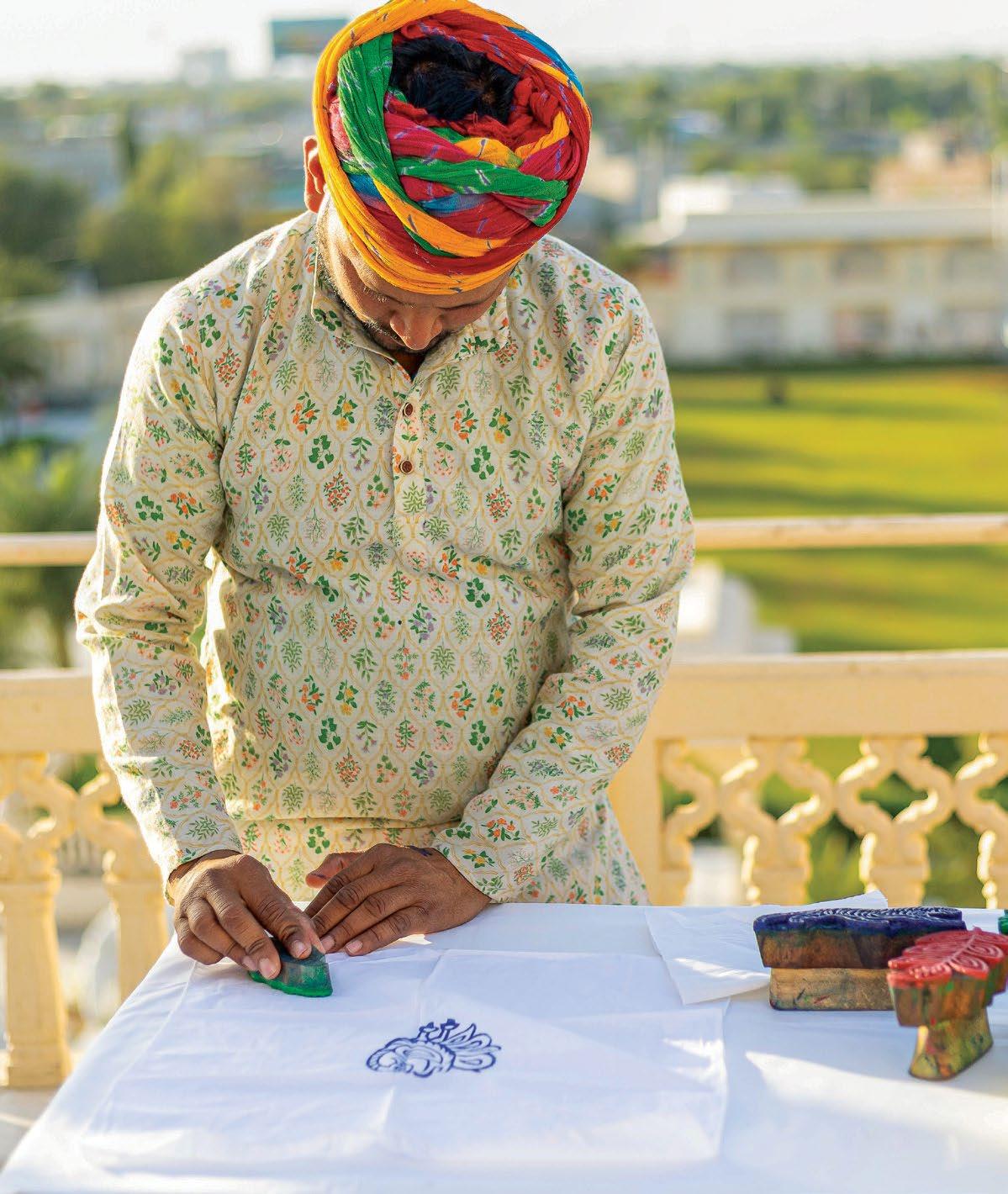
Ran Baas, The Palace in Patiala, plays host to cultural gatherings like music festivals and art residencies beyond aesthetics. “We see immense opportunity in connecting our rich craft legacy with the modern hospitality experience,” opines
Deep Mohan Arneja, General Manager, Relais & Châteaux Ran Baas, The Palace. “While there are areas such as supply chain support, product standardisation, and digital accessibility that need more structure, these are also precisely where innovation and collaboration can thrive.”
Step through the doors of TajView Agra and witness this transformation firsthand. From your window, the ethereal silhouette of the Taj Mahal commands the horizon, while inside, equally compelling stories unfold in silent splendour—delicate marble inlay work in décor, intricate jaali screens casting geometric shadows across burnished floors. “Here, opulence serves a higher purpose, each decorative element a deliberate homage to the artistic legacy of Agra's master craftsmen,” explains Manpreet Chabba, General Manager of the IHCL SeleQtions property.
It extends to immersive cultural stewardship. “In line with our Paathya initiative, we support and promote local artists with a platform to showcase their masterpieces within our hotel, at no additional cost,” Chabba informs. Casual moments become cultural encounters as artisans from Ferozepur transform the hotel lobby into a marketplace of shimmering glass bangles daily, while high-tea service elevates local delicacies like kachoris and pethas on Khurja ceramics— turning sustenance into storytelling.
While 11 meticulously curated experiences transport guests into the living workshops of tradition, from the golden thread artistry of zardozi embroiderers to the mathematical precision of parchin kari (marble inlay craft) at TajView Agra, Fairmont Jaipur integrates Rajasthani craftsmanship throughout its design. The hotel has hosted several heritage-focused events— showcasing handcrafted textiles threatened by modern manufacturing, pichhwai painting workshops featuring devotional art. Recently, an exhibition of analog photographs documented Rajasthan's festivals, traditional transport, craftsmanship, and architecture. Organisations such as Princess Diya Kumari Foundation are helping to highlight female artisans specialising in traditional block printing. The Leela Palaces, Hotels and Resorts has a straight strategy to uplift India’s cultural heritage. “Through signature initiatives such as Nakshatra, Aujasya, and Icons of India by The Leela, we pay homage to India’s artistic lineage— from holistic wellness traditions to collaborations with modern-day custodians of culture, each rooted in


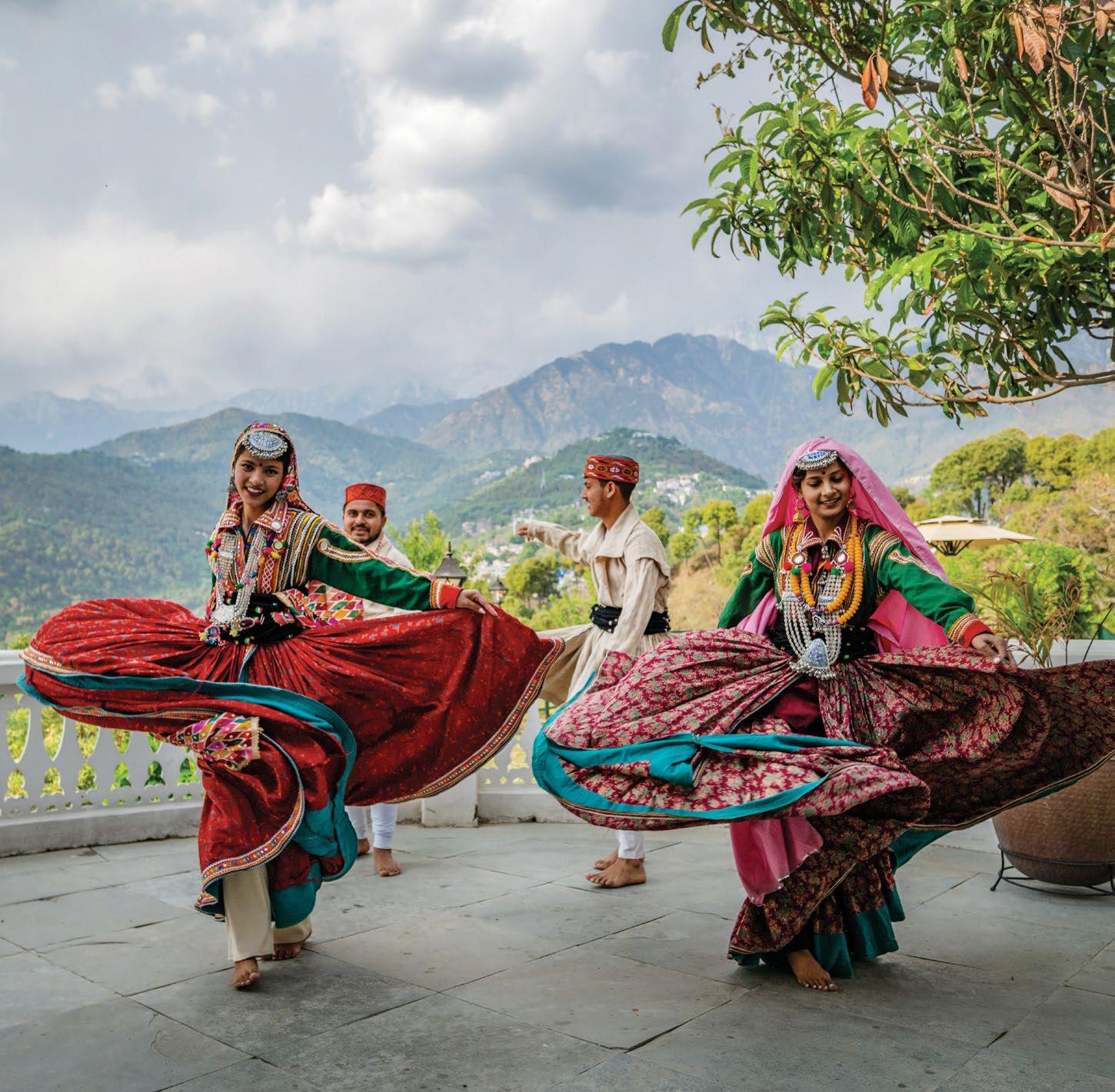
authenticity and grace,” says Anuraag Bhatnagar, Chief Executive Officer.
Beyond décor, these initiatives foster sustainable livelihoods while deepening cultural connections. A much needed stance, given homegrown brands like CGH Earth has stood as a thoughtful custodian of heritage, embracing local environments and communities long before conscious luxury became fashionable. Their properties showcase and encourage guests to explore remarkable traditional arts—from Swamimalai's lost wax casting to Thirubhuvanam's silk weaving, where creating a single heirloom saree on century-old handlooms takes months.
In the heart of Hyderabad, The Leela is now transforming hospitality into cultural safekeeping. A vintage Rolls-Royce once owned by the Nizams at the entrance announces this mission with regal authority. Gold leaf motifs adorn the dome at the arrival lobby, flanked by a portrait gallery of people integral to Hyderabad's multifaceted soul and an ode to Dakhni cultural heritage. “Our interiors are adorned with murals reminiscent of Machilipatnam chintz and Kalamkari traditions and feature iconic works by artists like M.F. Husain and Laxman Aelay. Every corner is curated to tell a story,” informs Rajesh Gopalakrishnan, General Manager at The Leela Hyderabad.
From the distinctive patterns of handwoven Pochampally textiles to the ancient Bidri metalwork
involving silver inlay on blackened alloy, tradition echoes throughout the hotel. In shadowed corners, delicate leather puppets of Tholu Bommalata cast ethereal silhouettes, breathing life into an ancient storytelling tradition. At The Wild Teapot café, walls bloom with handpainted Kalamkari artistry where botanical tendrils playfully conceal macarons and teacups, creating a curious visual feast. This thoughtful integration continues throughout the 156 rooms and suites, echoing Qutub Shahi architectural principles.
Before Ran Baas, Apeejay Surrendra Park Hotels Limited (ASPHL) attempted to balance preservation with innovation through a 'Maximalist approach' for The Lotus Palace in Kanadukathan in Tamil Nadu. Maintaining the original Chettiar home character while incorporating modern design elements, the restoration preserved signature architectural features like floor tiles referencing athangudi patterns, with curated antiques and eclectic furniture honouring the region's trading heritage. This sensitive renovation transforms the 15-room heritage property into what Chairperson Priya Paul describes as “a hotel that emboldens our commitment to honouring and preserving India's diverse legacy, by carefully turning historic spaces into living stories, that are Anything but Ordinary™ experiences for those who seek a unique blend of history, art, and culture."
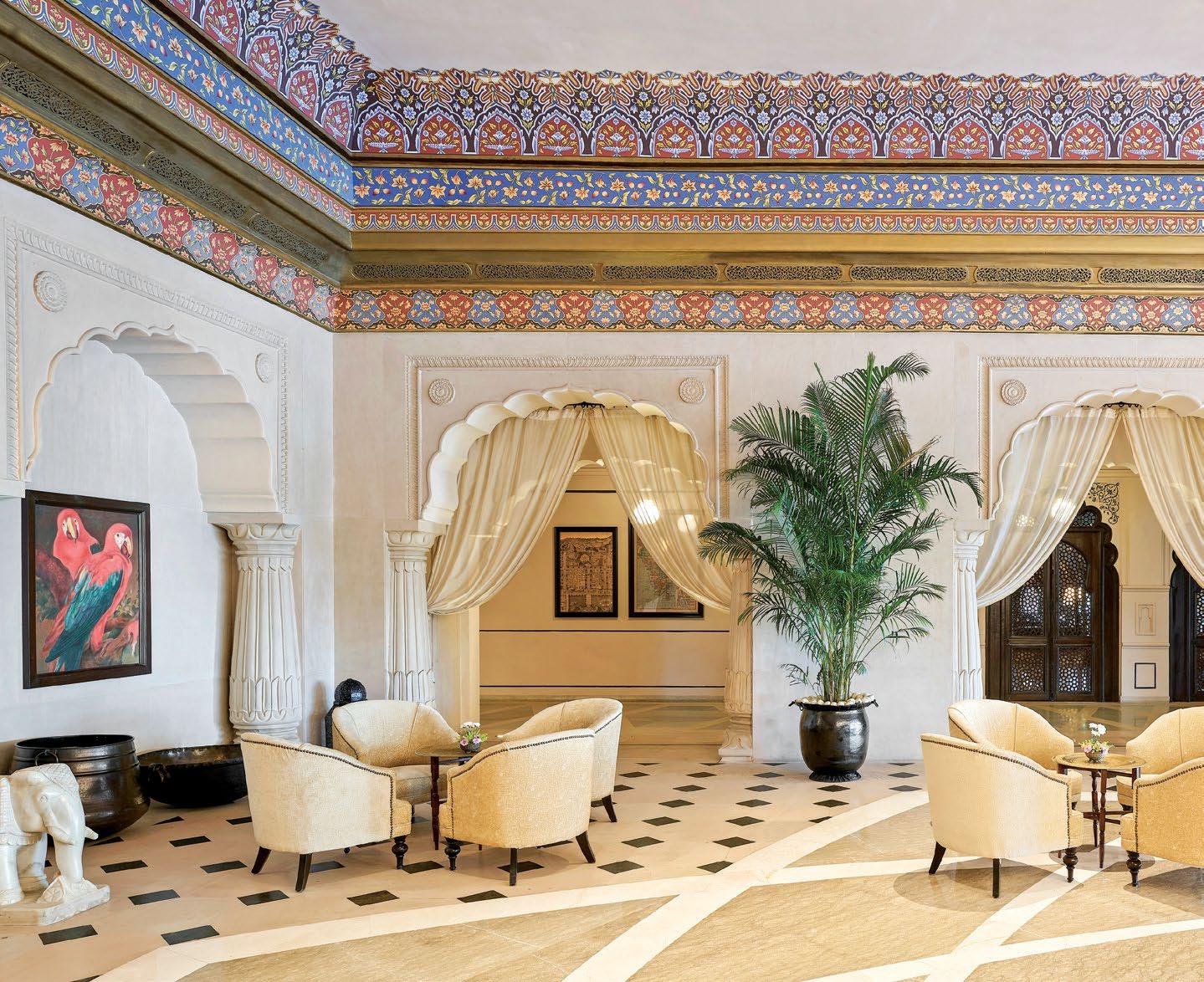
Similarly at Six Senses Fort Barwara, the 14thcentury fort was restored and renovated over a decade to ensure it reflects the authentic beauty of Rajasthan. Responsible restoration of the original architecture and artworks with minimal renovation helped retain intricate artistic details.
The need to be culturally sensitive reflects across Accor properties in Vishakhapatnam. “We celebrate local artistry by collaborating with talented creators and artisans, transforming our spaces into vibrant cultural hubs,” says Lakshmi Sridhar, General Manager, Novotel Visakhapatnam Varun Beach and Varun Beach Bheemili Resort. Partnerships bring events like art brunches, immersive photography experiences and more—showcasing the work of painters, illustrators, and even poets.
Beyond physical heritage, experiences also add a charming touch to this trend. Interactive workshops at St.Regis Goa resort include mandala art, quilling, bracelet crafting, coconut leaf origami, canvas painting, and sandcastle building—providing a platform for local artisans to share their skills with an international audience. “These initiatives reflect the brand’s timeless elegance and Marriott’s Serve360 ethos, championing meaningful impact through local collaboration and sustainability,” explains Jaya Acharya, Director, Marketing & Communications.
From feni-making masterclasses, where guests can immerse themselves in the art of distilling Goa’s iconic spirit, to collaborations with local beverage makers to host pop-ups and tasting sessions, the hotel provides a platform to Goa’s flourishing craft beverage scene.
Hospitality, at its heart, is an act of storytelling. And no story can be complete without culture, people, and the hands and voices that shape the identity of a place. “For indigenous and international hospitality brands alike, there exists a unique responsibility—to serve not just as hosts, but as cultural stewards,” voices Jahnvi Singh, Creative Head at House of Rohet, a Relais & Châteaux offering. This philosophy resonates today with brands seeking to showcase regional culture through immersive experiences. Bhatnagar echoes this sentiment: “Hospitality owners possess a distinct opportunity to reshape the trajectory of cottage industries, not just by showcasing local crafts, but by embedding them into the very fabric of luxury experiences.”
Take Atmosphere Hotels & Resorts, known for their chic Maldivian offerings, now moving to heritage properties with the opening of Sadar Manzil in Bhopal. While the premises already blend marvelous IndoSaracenic and Mughal architecture, experiential offerings like a champagne tour of the stories within the building appeals to a more discerning guest.


Singh says, “Including local heritage in hospitality ensures the continuity of traditions that risk being forgotten, dignifying generations of knowledge and technique.” It is a fact that is neither dismissable, nor ignorable in modern hospitality that continuously strives to be a bridge between the history of a destination with the visitors.
Minor Hotels' debuted in India with Anantara Jewel Bagh in Jaipur, offering guests exclusive cultural experiences, from royal art and heritage walks on the property to private puppeteer performances. This approach reinforces the brand's commitment to honouring its new destination.
While international brands often present templatised formats to showcase local history, boutique hotels offer a leaf out of their books. "At Brij, artisanal heritage isn't merely decorative,” says Udit and Anant Kumar, the founders of Brij Hotels. “From handwoven Rabari textiles and reclaimed wood furniture at Brij Pola to the slate flooring and Kumaoni woollens at Brij Atmanya, we integrate local craftsmanship into every aspect of the design and experience.” Grammy winner Pandit Vishwa Mohan Bhatt has played at Brij Rama Palace in Varanasi.
Gopalakrishnan reflects on breaking the temptation of templatisation. Pochampally Ikat fabrics sourced directly from weaver clusters adopted by his hotel are used for suits and staff attire at the hotel. “Our




commitment goes far beyond aesthetics as we are deeply invested in sustaining the communities that uphold these time-honoured traditions.”
Brij promotes living galleries where guests can engage with regional artistry—dining on hand-thrown pottery, sleeping beneath indigenous textiles, and connecting directly with the creators. “This transforms craft appreciation from passive admiration into a deeply immersive cultural experience that sustains traditions while creating meaningful connections,” the Kumars elucidate.
Singh points out the differentiating factor further. “Our family’s connection to this land spans over four centuries. We are not outsiders curating an experience but a part of the living history of Rohet, and that legacy informs every aspect of our brand ethos—to create deeply human luxury, rooted in place, and alive with tradition.” A fact that is slowly being accepted and adapted to, by others.

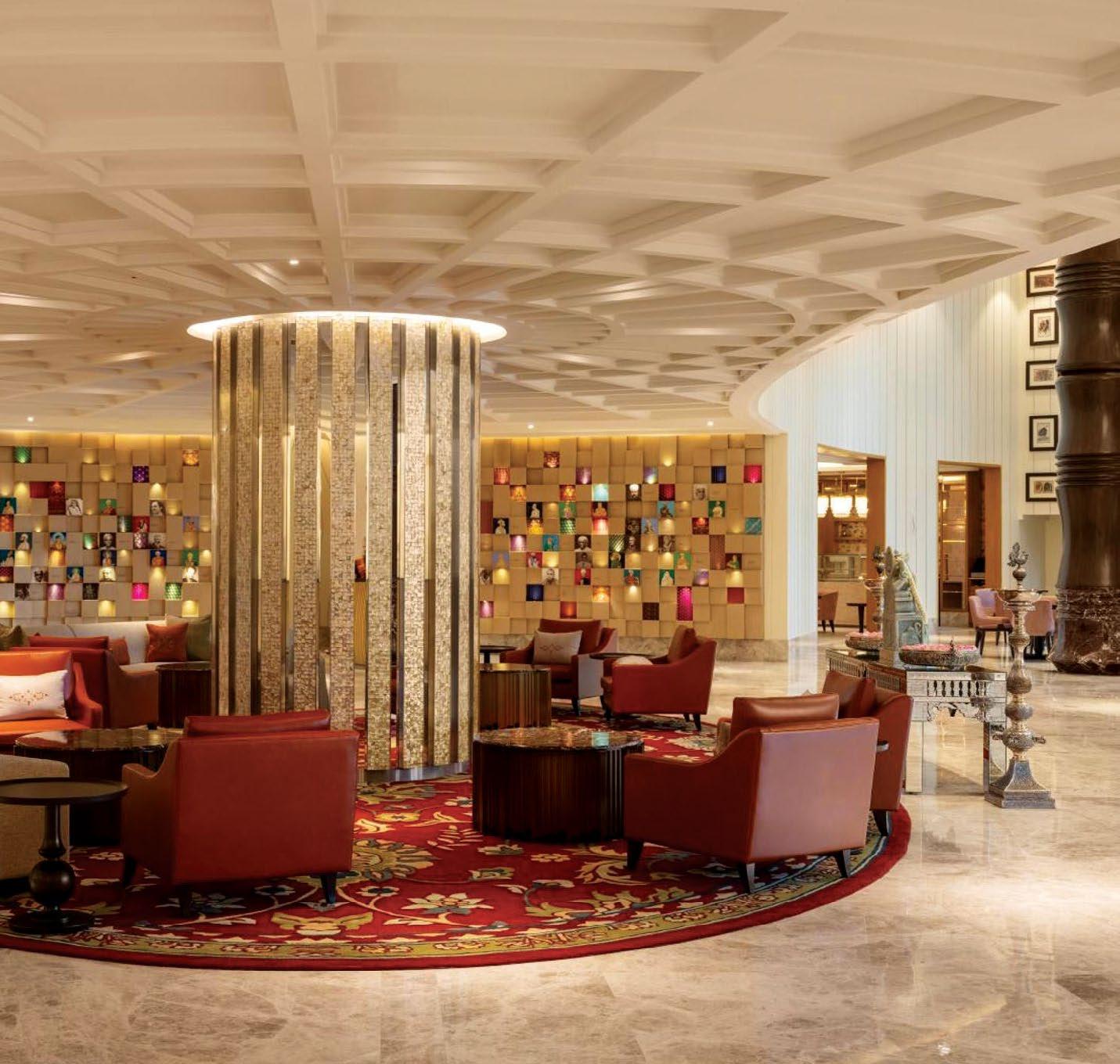
Commercial hospitality at scale, especially in urban cities, lacks the potential to focus on a central artistic theme. But Tier II cities present opportunities with deeper cultural backgrounds. “Our design philosophy is a thoughtful conversation between heritage and modernity creating a living narrative of Chandigarh’s vibrant spirit and global outlook,” says Sohaib Kidwai, General Manager, Hyatt Centric Sector 17 Chandigarh. While the hotel does not have many craft focussed experiences, “every space, from the atrium lobby inspired by Punjab’s mustard fields to the all-day dining paying homage to Le Corbusier, tells a story of contrasts and connections,” he elaborates. “We’ve reimagined traditional art, architecture, and local culture through a contemporary lens to create an experience that feels both deeply rooted and refreshingly bold.”
At the newly opened dusitD2 in Fagu, a souvenir shop features locally embroidered goods sold at prices set by the artisans. The front office staff, over 60% of whom are Himachali, also serve as sales reps, proudly promoting the craftsmanship of village women—an approach that reflects the cultural pride synonymous with the Thai hospitality brand. General Manager Ashish Gawari says it is part of their Himalayan strategy. “We are focussed on introducing thoughtfully curated properties that resonate with the aspirations of modern travelers seeking authenticity, tranquility, and transformative experiences in the majestic Himalayas,” he states.
As global hospitality evolves in India, true luxury will reflect where ancient crafts find contemporary purpose, telling stories that travel from ancestral hands directly to the discerning heart of the modern traveller.

In a city built on spectacle, Udaipur Marriott chooses nuance over nostalgia—delivering a hospitality experience that feels regional, relevant, and refreshingly real.



In Udaipur—where many hotels feel as though they’re dressed for a wedding even on a Tuesday —the Marriott has taken a subtler approach. Poised between Fateh Sagar Lake and the Sajjangarh Biological Park, the Udaipur Marriott Hotel doesn’t overwhelm with grandeur. Instead, it leans into its setting and cultural cues, expressing a design sensibility that feels rooted, not replicated.
This is by no means a palace hotel. Nor does it wish to be. What it is, however, is a deft reinterpretation of Mewar’s regal aesthetic, told through filtered light, arched forms, and strategic planning. With 226 keys, expansive banqueting, and a hospitality programme built for weddings, leisure, and MICE, the property combines regional richness with international precision.
The approach aligns with property owner Dangayach Group’s broader philosophy—to celebrate Rajasthan’s cultural depth while elevating its tourism potential through thoughtful hospitality projects. Having established a presence in Jaipur and Jaisalmer, Udaipur was both a natural progression and a meaningful addition to the group’s portfolio. This wasn’t just about entering a new market; it was about deepening their commitment to the region’s tourism narrative through a project that feels both timely and timeless.
“We saw a distinct gap in the premium segment,” says Managing Director Atul Dangayach. “We wanted to offer an experience that combines Marriott’s operational excellence with the soul and warmth of Udaipur. It had to be contemporary, but not anonymous.” From the very beginning, the vision was about creating a property that would resonate with its surroundings. Dangayach knew that to truly belong in Udaipur, the hotel needed to resonate with that visual and cultural language. There were extensive discussions and design reviews with Marriott’s design and development teams, and to their credit, they were very supportive





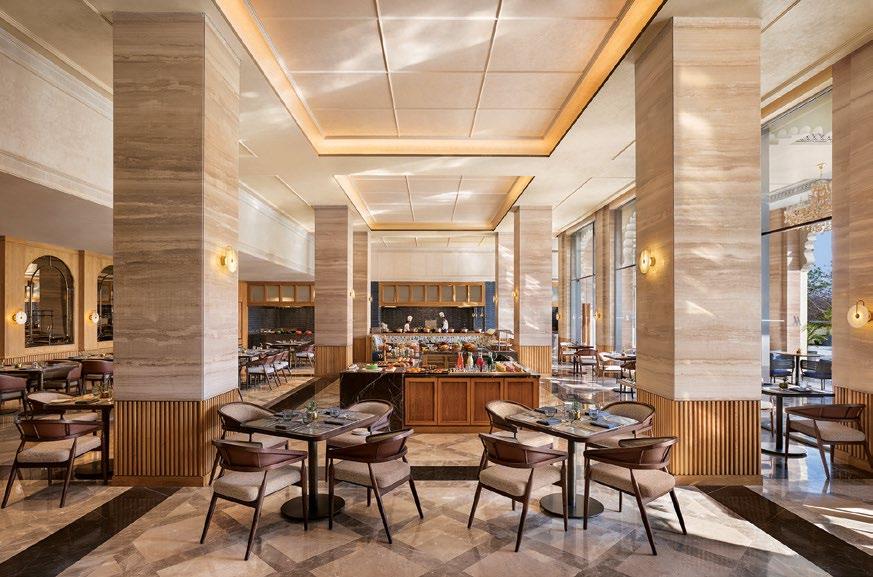
LEFT: The reception area with its fluid backdrop graced by floral designs.
TOP: The lobby area, anchored by an inverted lotus-bloom chandelier.
ABOVE: Okra, the all-day dining.


Despite its relatively compact footprint, the hotel makes a compelling case for destination weddings and large-format celebrations through spatial ingenuity. In a city where expansive lawns are often the norm, Udaipur Marriott offers a well-orchestrated alternative—elegant, efficient, and flexible enough to accommodate the many moods of a modern Indian celebration.
At the heart of its banqueting proposition
is the Grand Crystal Ballroom—a 10,000 sq. ft. pillarless hall surrounded by pre-function areas on all four sides. This thoughtful layout enables seamless hosting of parallel events, offering privacy for each gathering while ensuring efficient flow. The ballroom can also be divided into two smaller halls for more intimate affairs.
Supporting the indoor spaces are a range of open-air venues. The
Jasper Courtyard (15,000 sq. ft.) and Crystal Courtyard (12,000 sq. ft.) offer lush outdoor options, while the Mewar Royal Rooftop provides an elevated setting with views of the Aravalli hills.
Adding to the list of thoughtful details is the Emerald Room—a dedicated bridal suite tucked close to the ballroom, designed to give brides a calm, private space to prepare for their big day.
“What sets us apart is our ability to combine Marriott’s renowned event planning capabilities with local cultural flair— be it traditional décor, custom catering, or regional entertainment,” says Atul Dangayach, Managing Director, Dangayach Group. "We also work closely with wedding planners to provide seamless end-toend service, ensuring every celebration is uniquely memorable.”
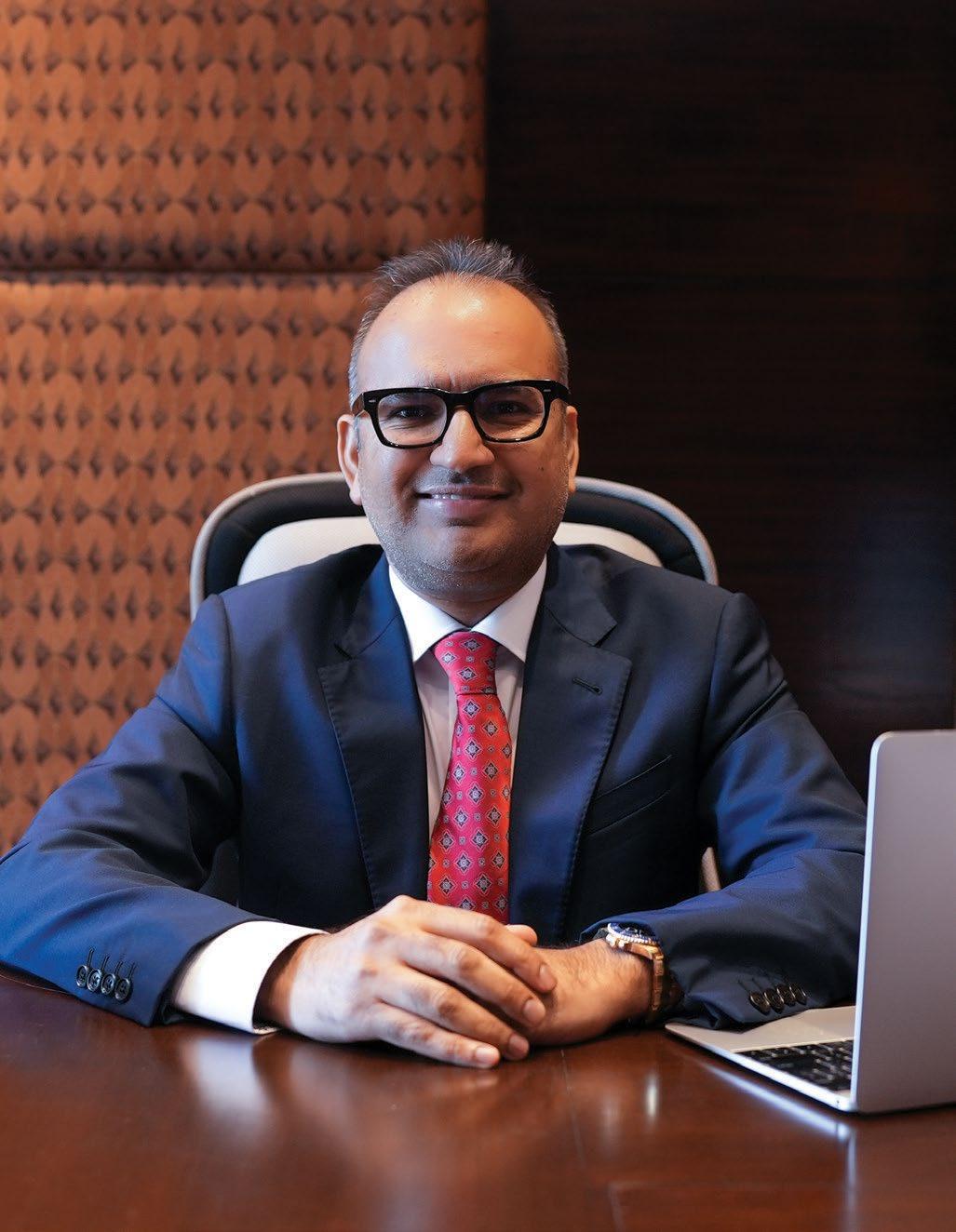
MANAGING DIRECTOR, DANGAYACH GROUP
“ We saw a distinct gap in the premium segment. We wanted to offer an experience that combines Marriott’s operational excellence with the soul and warmth of Udaipur."
in embracing a localised design direction—so long as it maintained the brand’s core guest experience principles.
The vision was realised with the help of PG Patki Architects and a leading Thailand-based interior design firm. While the former brought a nuanced architectural language that allowed traditional Rajasthani forms to breathe within modern structures, the latter recommended that spaces be layered with details that are unmistakably global with a local flair.
The design delved deep into Udaipur’s heritage—from the havelis of the old city to the palaces along Lake Pichola. The colour palette was inspired by the city’s lakes, sandstone hues, and vibrant textiles. Even for the landscaping, the team drew from Mughal traditions to create courtyards and water features that echo the rhythm of traditional Udaipur homes. “These weren’t just aesthetic choices,” says Dangayach. “They were our way of honouring a centuries-old legacy."
Jasper Courtyard, with chhatris that provide a stage for local performances.
The architecture, led by Shekhar Patki of PG Patki Architects, pivots away from imported tropes and anchors itself in place. “The site offered elevation, undulation, and views of the Aravallis. We saw that as an opportunity to create visual drama without excessive ornamentation,” Patki explains.
From the City Palace to lakefront havelis, the design language draws from Udaipur’s heritage but pares it back into utility. Domes, chhatris, and jharokas are not ornamental appendages. They're reinterpreted as passive cooling devices, shaded seating zones, and frames for capturing light and landscape.

Location: Badi Road, near Fateh Sagar Lake, Udaipur
DESIGN ETHOS ROOMS & SUITES: 226
Contemporary luxury meets Mewar heritage, with chhatris, jharokas, domes, and intricately carved arches reflecting the city’s royal legacy.
Deluxe Rooms (King/Twin)
Premium Rooms (some with balconies or mountain views)
Suites across three categories: Deluxe, Premium, and Luxury
Select suites offer balconies with Aravalli-facing views
Okra
All-day dining with interactive kitchens and alfresco seating
Ayana
Poolside Indian dining with 360° Aravalli views
Udaipur Baking Co.
Café with pastries and artisanal brews
Opal Lounge
Spirits, cocktails, and small plates
Over 85,000sq. ft. of indoor and outdoor event spaces, including one of Udaipur’s largest pillarless ballrooms, scenic courtyards, and a rooftop venue.



At Udaipur Marriott, sustainability is embedded in the bones of the building. The architecture deploys double-wall construction with air cavities and terrace-level deck slabs to enhance thermal insulation. Pavilions and shaded colonnades foster passive cooling, reducing reliance on mechanical systems.
Water reuse is maximised via an on-site STP, with recycled water channelled into flushing, irrigation, and HVAC. Infrared-sensor taps and dual-flush WCs further minimise consumption. On the energy front, high-COP chillers, heat pumps, and demand-controlled ventilation systems ensure optimal efficiency and air quality.
Material choices, too, were deliberate. AAC blocks reduced embodied energy during construction, while low-VOC paints help maintain indoor air purity.
The result is a structure that treads lightly, without ever compromising guest comfort—a quiet blueprint for resource-conscious luxury.

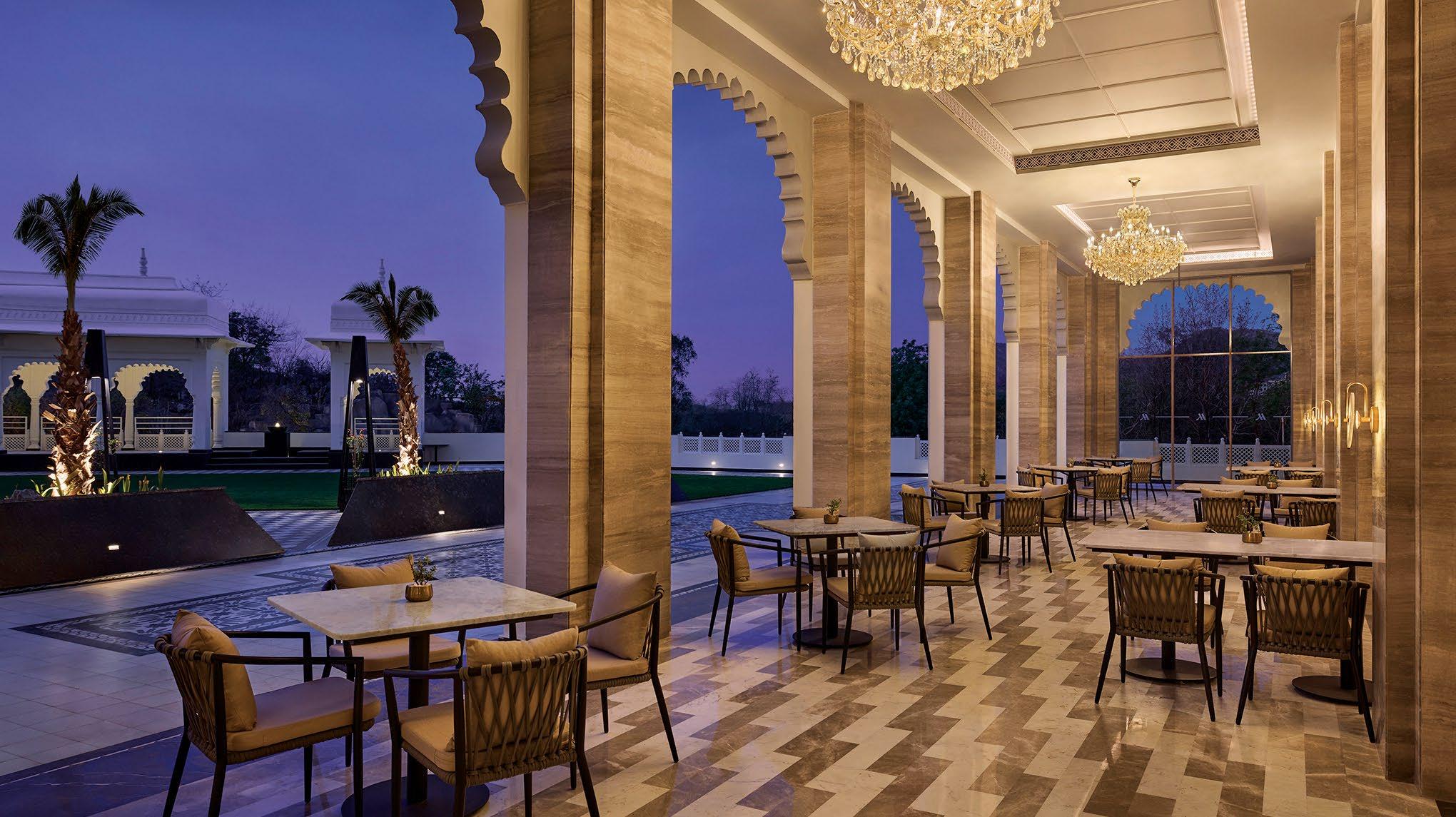
“
The site offered elevation, undulation, and views of the Aravallis. We saw that as an opportunity to create visual drama without excessive ornamentation.”
To evoke the elegance of Mewari architecture without compromising precision or timeline, the design team adopted a modular construction approach. Key elements—arches, chhatris, domes—were prefabricated, allowing for consistency in detailing and efficient installation on site.
“Double-wall construction, screened facades, bracketed balconies—all of these were designed with climatic sensitivity in mind,” adds Patki. The layout is sensitive to both terrain and function. Public areas and rooms are zoned for privacy, but always stay connected to the outdoors— through courtyards, balconies, and elevated terraces that look out onto the surrounding hills.
AAC (Autoclaved Aerated Concrete) blocks were used extensively for their lightweight structure, insulation properties, and lower environmental impact. RCC frameworks ensured structural longevity, especially for domed features. The façade, meanwhile, was coated in a reflective textured paint that mimics natural stone, blending visual authenticity with solar performance. Local sandstone and regional masonry techniques further reinforce the sense of place.
At Udaipur Marriott, the culinary direction under Executive Chef Mohit Mishra mirrors the hotel’s larger design philosophy— local inspiration, global articulation. It takes traditional Mewari roots and reframes them through a contemporary, cosmopolitan lens. The result is a menu that surprises as much as it satisfies.
From the Mewar Mezze Platter, with Ker Sangri-Mawa Falafel and Lehsun Chutney Hummus, to dramatic reinterpretations like Deconstructed Mirchi Wada and Laal Maas on Bajra Coins, each dish tells a regional story— just not in the way you'd expect.
Desserts are equally audacious: Dark Chocolate Ghevar, Boondi-Biscoff Pastry, and a Gulab Jamun Cheesecake straddle cultures and textures, with inventive pairings that feel rooted but refined.
Ms. Ruby is a refined, floral-tart mocktail with clarified apple, hibiscusrose infusion, and a whisper of rosewater, while Raat Ki Rani is a moonlit blend of blueberry-litchi, butterfly pea tea, and orange blossom—cool, serene, and softly mysterious.
The compact, yet complete spatial programme
Set on a compact three-acre plot, Udaipur Marriott makes every square foot count. The hotel opens into a vaulted lobby, its intersecting arches establishing both grandeur and flow. From here, public zones like Okra (the all-day diner), the Udaipur Baking Co., and the Opal Lounge bar extend outward, overlooking Jasper, the central courtyard that anchors the property.
Tucked discreetly off this level is the spa reception—a quiet retreat that leads to womb-like therapy rooms one floor below, designed to cocoon guests in calm.
Event spaces also lie a level below, accessed via a curved staircase that spirals down like a ceremonial route. “We designed the banqueting to allow simultaneous events, each with its own arrival and breakout,” says Dangayach. A pillarless Grand Crystal Ballroom, lofty and equipped with state-of-the-art lighting, is bracketed by multiple pre-function areas and accompanied by a discreet bridal suite.
Ayana, the Indian restaurant, sits elegantly on the rooftop, offering not just elevated cuisine but panoramic views of the Aravallis. Above the guest rooms—which occupy the upper floors and many of which feature balconies—rooftop venues like the Mewar Royal Rooftop further extend the vertical narrative.
The spacious pre-function areas.
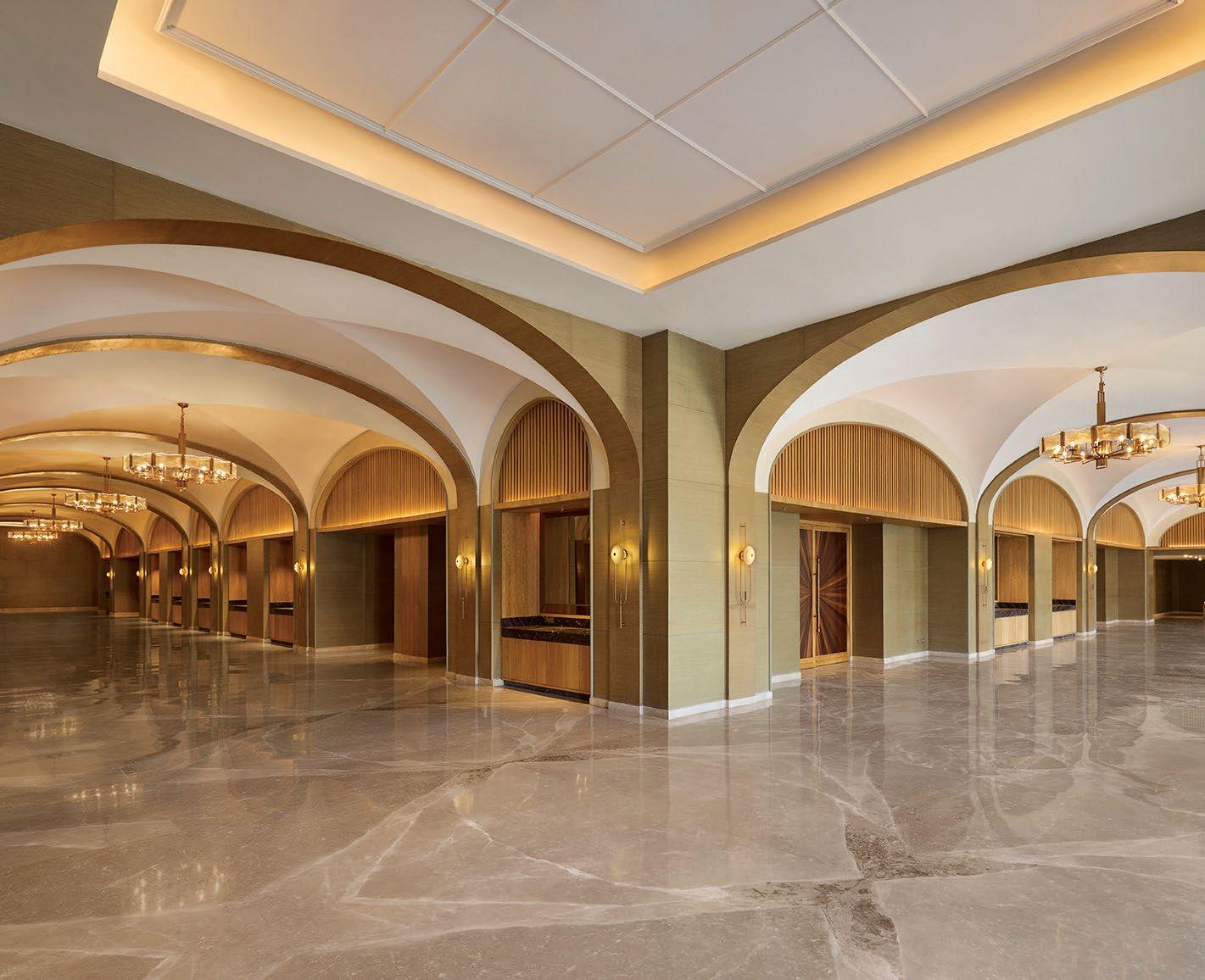
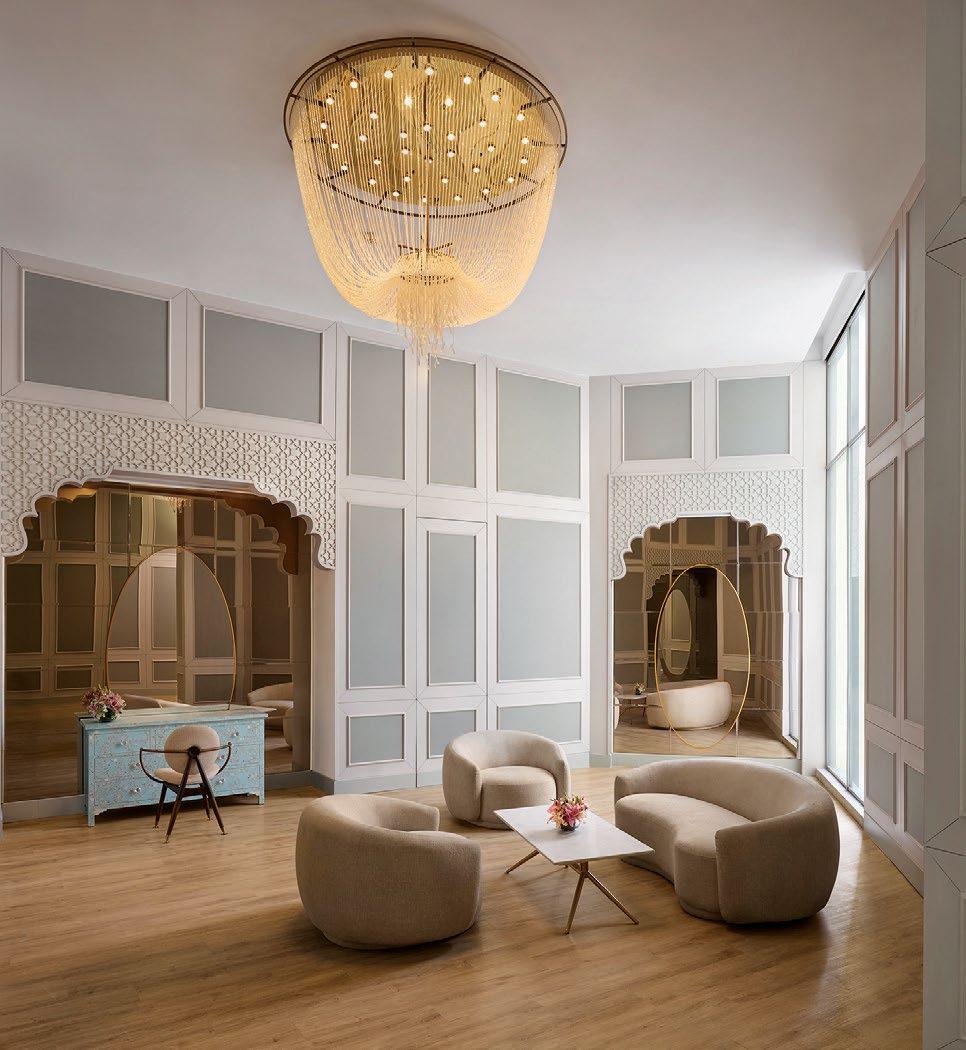
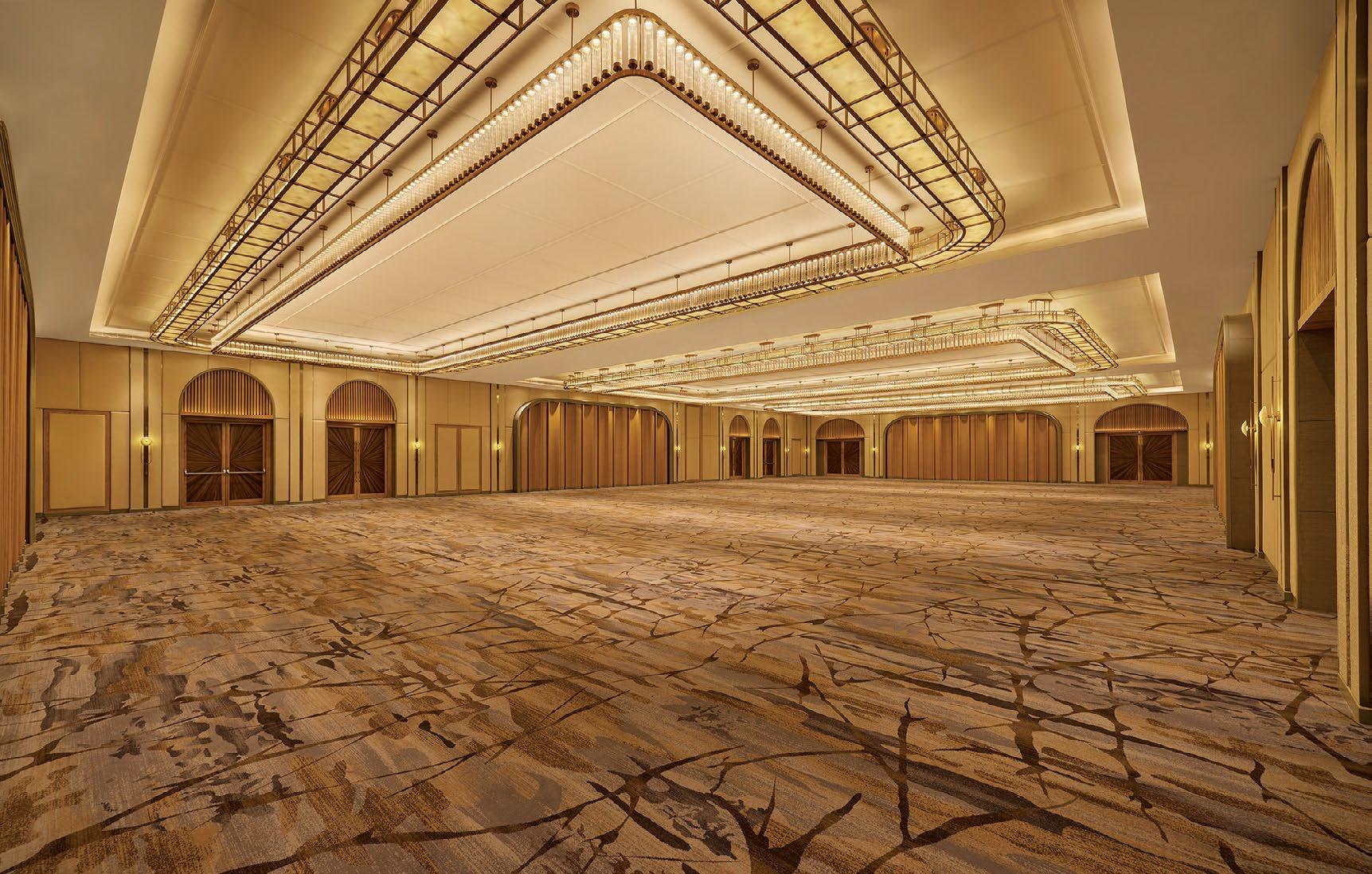


Building on the elevated, undulating terrain meant working with the land. Grading was carefully calibrated to nestle the structure into its site, preserving views while easing access.
The real challenge, though, lay in striking authenticity without artifice. Traditional elements—chhatris, jharokas, arches—had to do more than decorate; they needed to ventilate, shade, and shape guest experience. This demanded intensive research and countless design iterations.
Prefabrication helped streamline execution, but integrating intricate detailing into a modular workflow required exacting coordination between architects, consultants, and artisans. Add to that the region’s climatic extremes, and the result was a delicate balancing act: form, function, and performance, in harmonious tension.
Murals inspired by miniature paintings and vernacular art forms such as the Shekhawati-style floralscapes, arches interpreted in low-relief plasterwork, mixed-media artwork, and an overall palette drawn from sandstone, saffron, and lakewater combine to create a setting that’s atmospheric, not theatrical.
The backdrop of the reception desk is an undulating expanse, graced by floral designs, while a paisley form printed on fabric lines the elevator doors. In the lobby, a custom inverted lotus chandelier, suspended like a spiritual bloom, draws the eye. Inspired by the carved dome of the Jain temple at Ranakpur, it anchors the lobby with quiet elegance. Arched niches, screen details, and the occasional pop of tactile textiles keep the interiors on a fine edge between memory and modernity.
Guest rooms follow the same design ethos: restrained but rooted. There are 226 rooms and suites, with several categories offering balconies that face the Aravallis, perfect for sunrise rituals or evening chai.
The rooms balance warmth with function—local textures offset by clean-lined furniture. Headboards with custom prints of carving details, mirrors with arched frames, emerald-painted walls of the interactive bathrooms and regional textile accents render a crafted, comfort-first layout. Smart tech, high-speed connectivity, and ergonomic work zones ensure that business travellers are well served. Meanwhile, the suites offer extended lounging areas, ideal for wedding guests or families on a longer itinerary.
In a city synonymous with royal spectacle, Udaipur Marriott makes a persuasive case for measured luxury: one that is responsive to place, aware of its context, and elegant without excess. From spatial choreography to culinary storytelling, from sustainable construction to layered interiors, every gesture here is intentional, rooted, refined, and ready for the world.
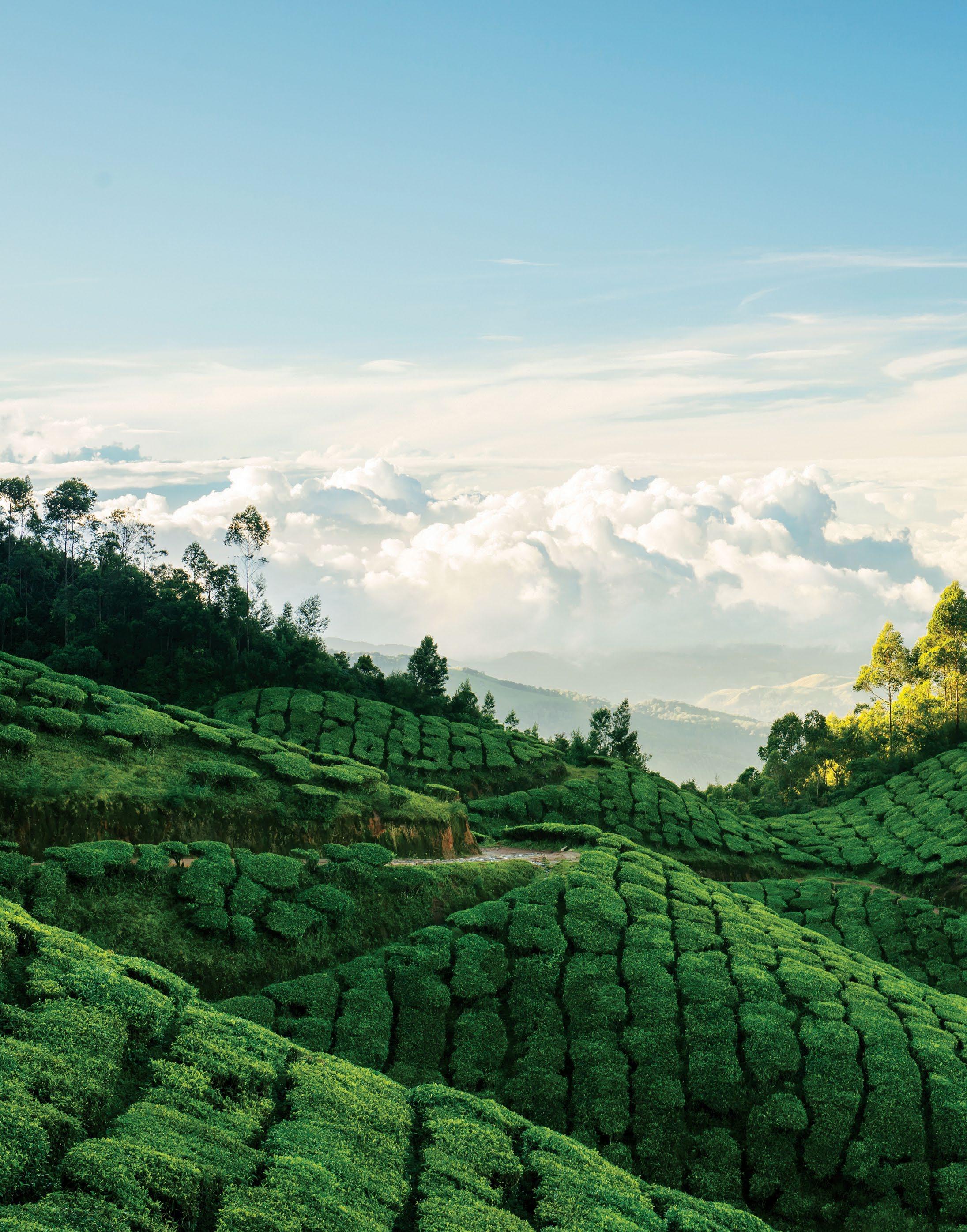
They say travel expands your horizons—but for queer souls like Sushant Divgikar, a.k.a. Rani KoHENur, it does something deeper. It lets him/ her/them exhale. To walk into spaces where their existence isn’t questioned—but celebrated! To wear their truths as boldly as their eyeliner.
AS TOLD TO NOLAN LEWIS



My first taste of travel was when I went to Darjeeling, Kalimpong, Sikkim and Nagaland. A wild, unforgettable childhood family adventure with my brother Karan and our parents that still lives rentfree in my head. Every detail is crystal clear—like the universe stamped it onto my soul. That trip lit the fire in me!
Since then, I’ve made it my mission to explore every inch of this fabulous planet. Whether I’m sashaying down a runway in Los Angeles or soaking in a sunset in Santorini. And to my parents—thank you for giving me the gift of wanderlust.
A meal to remember—and propose over—is at OKO by The Lalit. Let me say it louder: THE best Pan-Asian in the country. My OG fave is OKO in New Delhi, followed closely by Ming Yang at Taj Lands End. First dates? Countless. One man even proposed mid-sushi because the food and vibe were that intoxicating. I declined,
FROM LEFT: Whether it’s Mumbai or Madrid (seen here), Digvikar stays true to his art and activism; Ritz Paris has hosted a wild bestie trip; The Pierre is an international favourite.
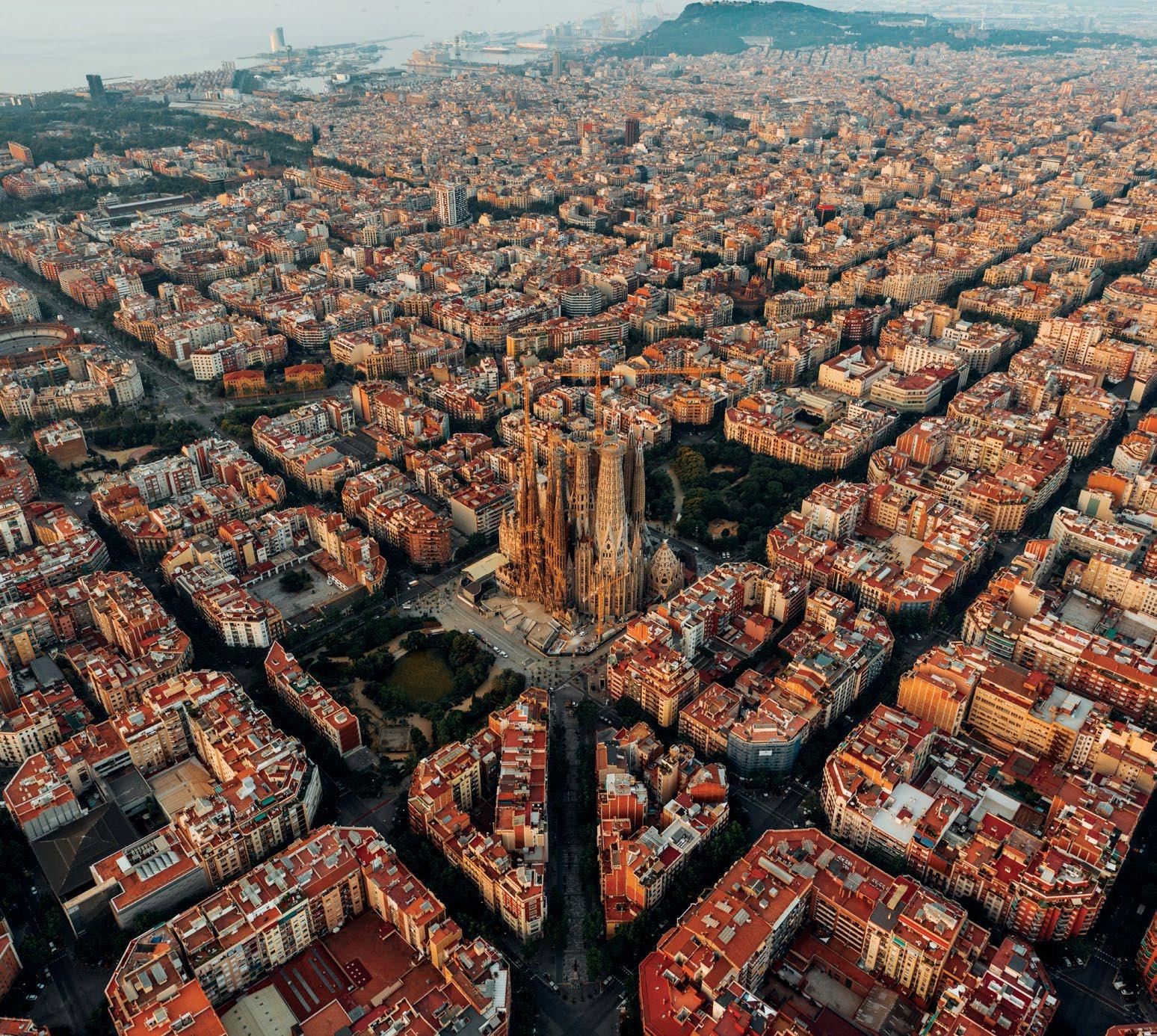




The world is my runway. I belong wherever love is louder than hate.” “
obviously—but darling, good food will forever be my true love.
The Lalit Group of Hotels, Palaces & Resorts is a ‘home away from home’. It is not just a hotel chain, it’s a statement, a sanctuary, a revolution in inclusivity. Where else do you find drag performers on stage and in hospitality leadership roles? Their DEI game is unmatched. It’s luxurious! It’s empowering. It’s everything a queen like me needs.
Internationally, I would check in at The Pierre, A Taj Hotel, Ritz Paris, and The Beverly Hilton. Taj is Indian hospitality’s crown jewel. Ritz for hosting my wildest bestie trip ever! And the Beverly Hilton? I lost my Hollywood red carpet virginity there… and had—shall we say—a night to remember—and then some?
My dream date destination is Japan, darling! Specifically, the jaw-droppingly stunning Aman Tokyo. Zen, design, discipline, and that insane skyline

view. Manifesting a man who’ll whisk me away there. Applications open!
My art, activism, and androgyny have travelled with me from Mumbai to Madrid. As a queer icon and performer, every trip adds layers. I’ve performed across continents, absorbed cultures, and evolved not just as a drag artist—but as a deeply empathetic, observant human being. My passport is proof of a life lived loudly.
My queer utopia is Maspalomas in Spain. It’s like queer Disneyland—without the heteronormativity. I’ve never felt so gloriously free, loved, and celebrated just for being me. Not tolerated—celebrated!
Cities that get it right for queer folx are Los Angeles, New York, Barcelona, Paris and Mumbai. They don’t just tolerate queerness—they create ecosystems for us to thrive. The rest of India is shifting too—don’t let the trolls fool you. We’re rising, changing, and making space for every shade in the rainbow.
I have faced travel prejudice. Some countries are racist and queerphobic. And when you’re a six-foot-tall
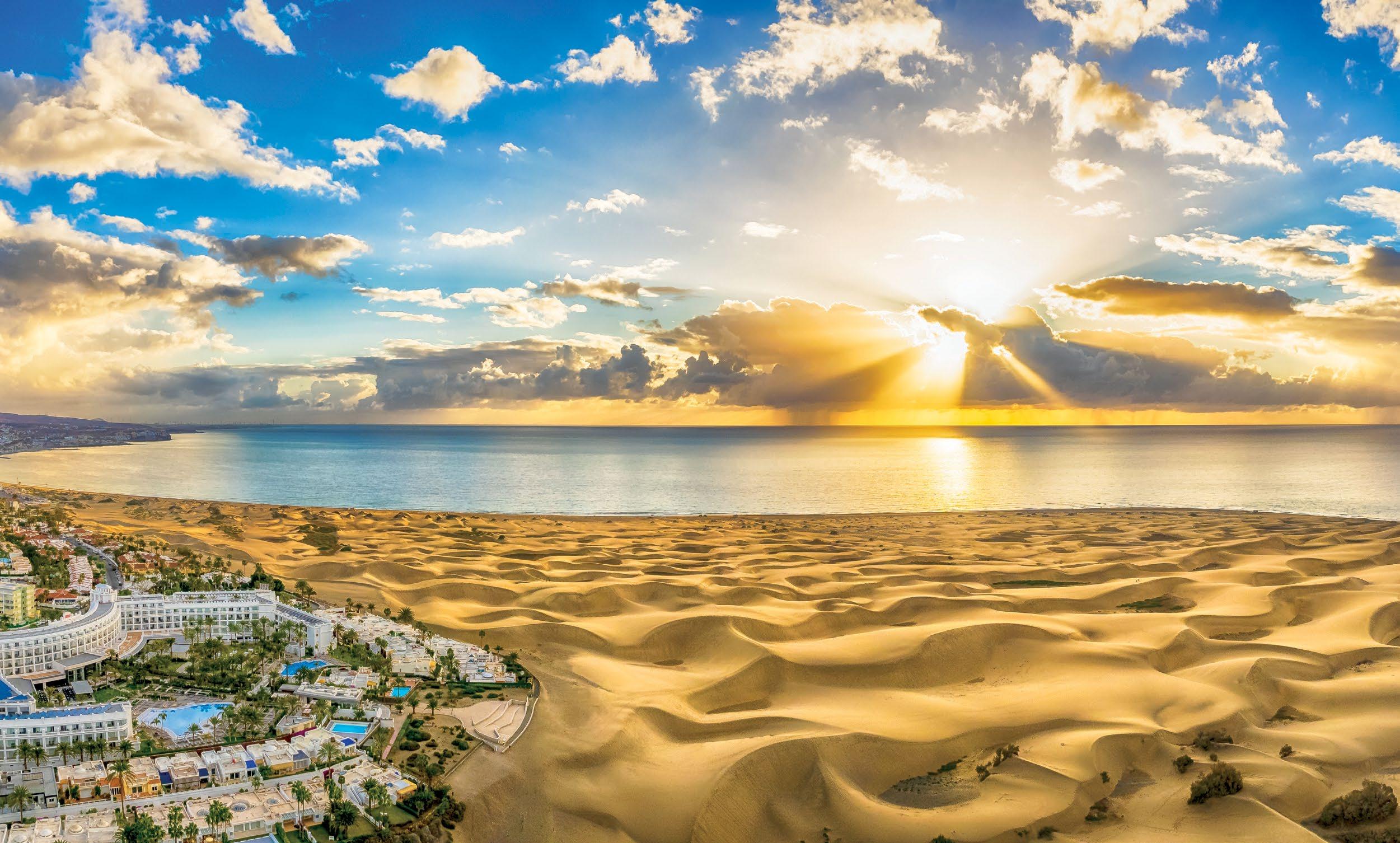
Maspalomas is renowned globally as a premier gay tourism destination.
glamazon in high heels and hair, you get looked at. But guess what? I refuse to dim my sparkle. If I’m boosting your GDP with my presence, I demand respect! Period.
India’s trailblazing airline is IndiGo. Their DEI team walks the talk. I’ve worked with them, and they’re making sky-high inclusivity a reality. Honestly, they’re doing more than so-called “woke” global airlines. Colour me impressed—and proud!
I’ve performed at Pride celebrations worldwide. Stockholm Pride was a fever dream. Sharing the stage with The Weather Girls and The Village People? Legendary. The moment they called me India’s answer to Beyoncé — I blacked out with joy. Still recovering!
When in my home city Mumbai I haunt Zainab Patel’s Trans Café in Mumbai. Run by a proud trans team, it’s a space of warmth, hope, and killer coffee. Every time I visit, I sing. Sometimes I cry. Always, I leave inspired.
My queer-approved Indian itinerary would consist of Rajasthan, Goa, Leh, the northeast, and the Kamakhya Devi Temple in Guwahati. India is a cultural fever dream—and we’re queering the map, one glitter bomb at a time.
The gay clubs I adore are DISCO DISCO and House of Heals in Thailand. Kitty Su and Kitty Ko in India. And
of course, the iconic Stonewall Inn in NYC—where our revolution began. These aren’t clubs—they’re temples of freedom.
My kind of getaway has good food, a great head massage, soulful conversations and chill vibes. Basically, a 5-star thali with a side of aromatherapy. Peace has taste—and baby, it’s spiced to perfection.
I have a pink ritual of wellness, whether I’m at a retreat or in a hotel room; my body is my temple. I meditate. I stretch. I jog. I light incense. I glam up. It’s not routine— it’s a ritual!
I don’t travel to ‘get inspired.’ I live fully, observe deeply, and absorb the world like a sponge wearing sequins. And if the place has hot men? Bonus points.
From NYC to Bangkok, I’ve soaked in global drag influences but my soul remains rooted in India. I pack my saree with sass, the naach with the narrative. Even RuPaul said my fusion is iconic. I’ll take that to my grave!
American drag is eclectic, yes! But South Asian drag is ancestral. We channel our classical dance, Sufi mystique, Bollywood drama—and serve it with grace. It’s heritage-on-heels.

“
I’ve
performed across continents, absorbed cultures and evolved not just as a drag artist—but as a deeply empathetic, observant human being.”
The world is my runway. I belong wherever love is louder than hate. And yes, I’m the dream travel companion. Just ask my exes—or better yet, don’t!
Chosen family isn’t just a phrase—it’s my reality. From Berlin to Bengaluru, I have couches to crash on and hearts that hold space for me. It’s solidarity on speed dial.
My dream queer holiday in India is at The Lalit Golf and Spa Resort in South Goa’s Canacona village. Secluded, stunning, and superbly queer-friendly. Picture this: beachside brunches, spa indulgence, drag brunches, and starry nights under palm trees. Iconic.
Still on my list. Japan. New Zealand. Australia. This holy trinity I must experience. The glam goals are travel bucket calling—and I will answer.
I love the stage, but I also cherish anonymity. Sometimes, being invisible in a foreign land is the ultimate luxury. I let my soul exhale. And that, darling, is freedom!
My advice to queerlings. Save up! Fly out! Live out loud! My mentor once told me, “You’re not a tree—MOVE!” The best advice I ever got. Now I’m passing it on to you.
I am truly myself anywhere that’s chill, welcoming, and doesn’t judge how high my heels are. And honestly? Wherever I go, I bring the vibe. I am the holiday.
My travel mantra? Eat. Sleep. Rave. Repeat. And book that massage. You deserve it, you divine creature.





With spectacular progress in recent years, ‘India’s bestkept secret’ may be a tagline of the past as the state begins a slow ascent to tourism's top spot.

SUMAN TARAFDAR

Just a few years ago —even at the start of this decade—Odisha, the largest state by area in eastern India, barely registered on the country’s tourism map. Despite its stunning landscapes, rich cultural heritage, and ancient spiritual sites, Orissa—as it was long known—remained curiously overlooked. Its offerings were significant: the sculptural marvel of Konark, the vast Chilika Lake, the forests of Similipal, and the sacred towns of Bhubaneswar, Cuttack, and Puri, which long attracted pilgrims but have failed to develop the necessary infrastructure to draw aspirational tourists.
Things however have begun to shift. Sustained and strategic efforts by the current and past Odisha government over the better part of two decades are beginning to show results. Stakeholders agree the first real fillip for promoting tourism came from the previous chief minister, Naveen Patnaik, whose notable initiatives included better infrastructure for tourism, promoting ecological and sports tourism, and branding the state as a prime destination for the discerning traveller.
“Odisha has a quiet, understated magic,” says Mrinalika Bhanj Deo, Owner and MD, The Belgadia Palace. Her words echo a growing sentiment among stakeholders. She describes a state whose appeal lies in the authenticity of its experiences—temples, coastlines, tribal heartlands, and forests—each offering a spiritual, soulful, and unhurried journey. “What sets Odisha apart is that much of it remains undiscovered,” she says, “offering travellers the opportunity to engage with culture and nature in an unfiltered, authentic way. For the hospitality sector, this presents an extraordinary opportunity to build a model rooted in sustainability, community, and legacy.”
It’s a view shared by Samit Garg, MD of E-Factor Experiences, which curates the state’s flagship Eco Retreat Odisha event. “Its tourism potential is immense— rooted in a rare blend of ancient heritage, unspoiled natural beauty, tribal culture, and spiritual legacy. Odisha offers layered experiences that can appeal to spiritual seekers, adventure enthusiasts, cultural travellers, and luxury tourists alike.”
The private sector is starting to take notice and stakeholders are interested in the state’s potential. “The hospitality sector is full of promise, especially in a country and state that are developing rapidly,” says Sonal Sahoo, Director and Co-founder, Lyfe Hotels and Resorts. “With growing infrastructure and tourism, there’s a rising need for quality hotels and services—and that’s an exciting opportunity to be part of something that will make an impact.”
The momentum is now matched by political will. “Odisha will be the number three state in the country in terms of tourism by 2029,” declared Deputy Chief Minister Pravati Parida earlier this year. The ambition is audacious: to leapfrog from the current rank of 17 to 7 by 2025, and eventually into the top three.
That’s a tall order, but the indicators are promising. Olive Ridley turtle conservation efforts have drawn global attention. Infrastructure development is finally keeping pace with ambition. Large-scale events like the Hockey World Cup have helped shift perceptions.
K Mohanchandran, Senior VP, IHCL (Taj Hotels), who heads operations in the east for the group, reflects on the longstanding underestimation of the state. “From a tourism perspective,
it has not been on people's minds, except for religious tourism to Puri. It’s only now becoming attractive thanks to the conservation effort to bring more Olive Ridley turtles to the state’s shore, which has been a success story,” he admits.
Odisha has been showing tremendous appetite for growth in the tourism sector over the years, according to Bjorn DeNiese, Managing Director, Mayfair Elixir. “Of course, Mayfair Hotels & Resorts, which has invested in Odisha since 1982, continues to invest strategically to develop its portfolio in the state. With more investments coming into the state, a slew of new hospitality brands are marking their presence, which points to its growing business potential. Proactive and wellsynchronised efforts from the government have offered a boost.”
Odisha is slowly stepping out of the shadows and onto the cultural map of India. Bhanj Deo says, “The government’s initiatives to promote eco-retreats, heritage circuits, and tribal tourism have begun to change how people perceive the state—from a place known primarily for religious pilgrimage to one that offers immersive, transformative journeys. There’s still work to be done, but this intentional push is planting the seeds for longterm growth. The development of better road infrastructure, heritage conservation efforts, and international events such as the Hockey World Cup have added momentum. But there is still so much untapped potential— especially in the luxury and experiential segments.”
From heritage retreats to eco-resorts, unique premium properties are coming up across the state, often in partnership with local stakeholders. “The government is pushing its tourism department to explore every


“Odisha will be the number three state in the country in terms of tourism by 2029. Odisha stands as the premier destination for adventure sports, offering an array of breathtaking locations including beaches, dense forests, hills and more. We are laying the foundation for the state’s tourism growth over the next 50 years, ensuring it remains a top destination for adventure and exploration.”
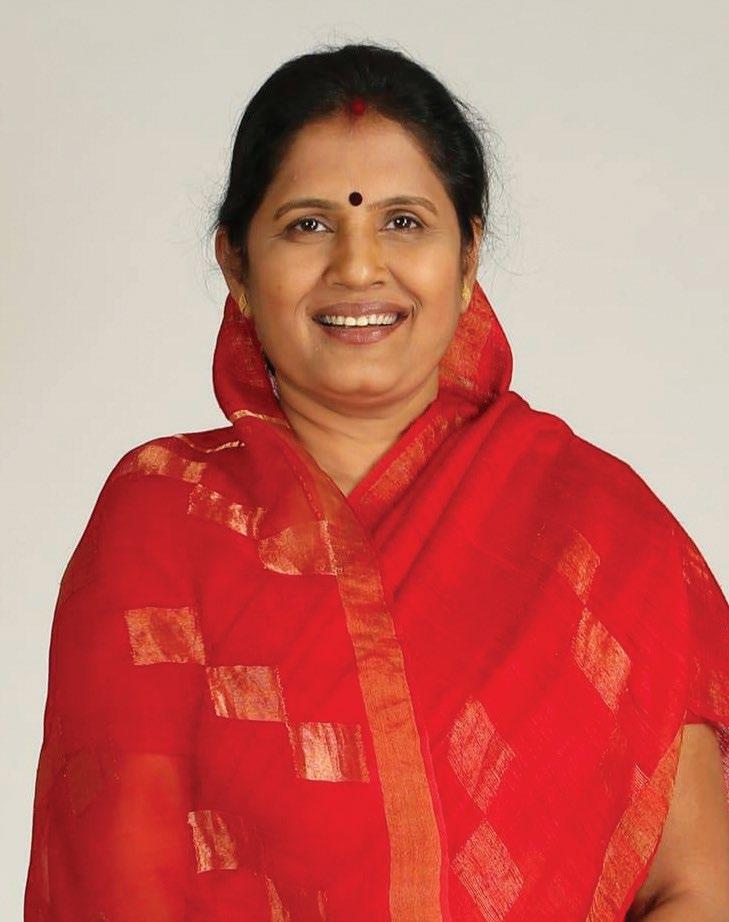
avenue to boost hospitality,” says Debjit Singh Deo of Kila Dalijoda, a heritage homestay near Cuttack. Many new eco-resorts have come up all over the state with local partners.”
Garg points to Eco Retreat Odisha as a turning point in how the state is branding itself. “The state’s proactive stance on tourism development, especially under leadership that understands the
economic and cultural impact of experiential tourism, is encouraging. It’s a sign of how Odisha is opening up to innovation,” he says. “Initiatives like Eco Retreat Odisha, which we have had the privilege to curate and operate, showcase the government’s openness to innovation in hospitality formats.”
New infrastructure, better air connectivity, and a more globally oriented outreach strategy are all contributing to an upward trajectory.
The current travel trends reveal that the state’s key hospitality hubs remain Bhubaneswar and Cuttack, while Puri and Konark anchor the coastal belt. “We’re also watching developments in Rourkela, and there’s growing interest in interior districts such as Mayurbhanj, Keonjhar, and Koraput from the industry,” says Mohanchandran. “The state has been encouraging investments in these areas. Eventually, these could all become centres for good quality mid-scale to upscale hotels.”
Lyfe Hotels sees potential beyond the established circuits. “We’re focused on our differentiation—local ties, personalised service, and innovative experiences,” says Sahoo. She recognises the challenges of competing with legacy brands but believes the space is ripe for fresh ideas. “It’s about building a strong foundation, even in a crowded market.”
As hospitality standards continue to evolve globally, there is an increasing expectation for consistency in service and offerings across destinations. Odisha, too, is feeling the ripple effects of this shift. The demand for luxury hotels is growing, with several five-star properties under development across the state. Among the frontrunners is Mayfair, which has emerged as a leader in the resort space, particularly for hosting high-profile events such as weddings.
The situation is steadily evolving, bringing Odisha closer to states that lead in luxury hospitality standards. “I think for the longest time, there were limited hotel brands offering hospitality in the luxury segment,” says DeNiese. “Today, we have seen many brands come up, and also several local newer brands that add to the vibrant offering of the state. When all the brands collectively and strategically work together to attract a bigger share of leisure travellers to the state, it will be for the long run. I have always believed that for states intending to bring in lots of leisure tourism, a good bank of events—such as large-scale conferences, weddings, and such others—give first-timers a chance to experience the massive transformation this once-backward state has undergone.”
Mayfair
Swosti Premium
Lemon Tree Premier
Oberoi Trident
ITC Fortune, Welcomhotel Lyfe
IHCL Taj, SeleQtions, Vivanta, Ginger
Radisson Individuals

BJORN DENIESE
MANAGING DIRECTOR, MAYFAIR ELIXIR
“When all the brands collectively and strategically work together to attract a bigger share of leisure travellers to the state, it will be for the long run.



Mayfair, for its part, continues to invest heavily in Odisha. “We have the upcoming Mayfair Sanctuary—a large-format, 300-room hotel that will have extensive banqueting and conferencing facilities. This will certainly help in cementing the brand’s authority in the state for a while,” DeNiese shares. “In Odisha, we are also doing another project near Puri, which will begin operations by the year-end, comprising over 100 rooms.”
The main challenge for the growing market, says Singh Deo, lies in the availability of quality hotels and homestays. “We also need more professional or trained manpower,” he points out. “Besides, the local tourism department has been slow in promoting the state internationally.
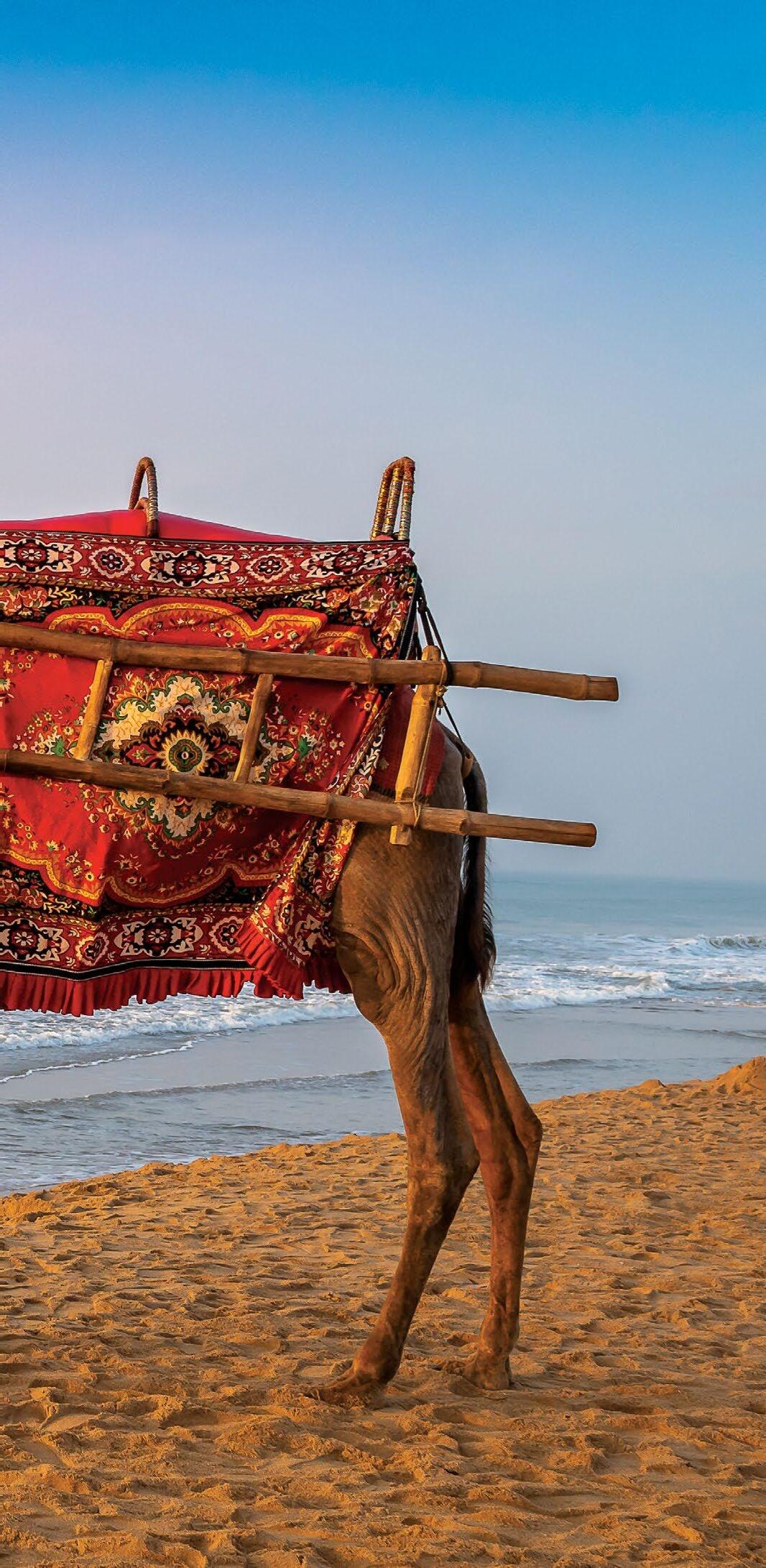
Of late, Odisha has seen a slew of luxury-end boutique properties— some restored—such as The Belgadia Palace, Rambha Palace, Kila Dalijoda and others newly built. “Boutique hospitality in Odisha is still a growing space, but it is being shaped by pioneers who are reimagining heritage and hospitality with fresh eyes,” points out Mrinalika Bhanj Deo, Owner and MD, The Belgadia Palace. “The Belgadia Palace, a restored ancestral home of the Bhanja dynasty, is one of the first luxury heritage stays in the state to combine luxury with legacy. We have tried to redefine what boutique hospitality can mean here—not just in terms of design and comfort, but in offering curated, immersive experiences rooted in local culture.”
In many ways, The Belgadia Palace has become a case study of how boutique hotels can evolve beyond accommodation. “They can be cultural institutions, economic drivers, and change-makers for the local community,” she stresses. “We are proud to employ and upskill locals, promote indigenous crafts through our brand Hasa Atelier, and create platforms for conversations around sustainability and heritage conservation. There is a market for this, especially among younger and more conscious travellers.”
Similarly, Singh Deo points to the heritage of Kila Dalijoda, which was a hunting resort of the rulers of the Panchakote Raj Dynasty. Lovingly restored, the mansion’s structure combines European architecture with arched windows and doors fitted with coloured glasses and locally inspired vintage furniture.
The 200-year-old Rambha Palace by the Chilika Lake is another restored mansion that is today attracting high-end tourists who are willing to experience the traditions of a bygone era.

ABOVE: Kila Dalijoda near Cuttack is a nearly century old mansion that has been meticulously restored.
RIGHT: The Crown, Bhubaneswar, part of IHCL SeleQtions, provides a one-of-a-kind odyssey through Odisha.
Odisha needs more promotion. The government should promote more tourism-friendly policies to its people and encourage private entrepreneurs to come forward.” Traditionally known for its iconic destinations such as Puri, Konark, and Chilika—the golden triangle— Odisha has seen most branded hotels concentrated in these areas. “However,” he adds, “smaller boutique hotels have come up to fill in the gap.”
The challenges of perception persist. Odisha, like Gujarat and Madhya Pradesh, suffers from low recall outside its region. Most of its volume still comes from religious tourism. “The biggest feeder market is West Bengal,” says DeNiese. “There is also a significant number of arrivals from the NCR region.”
Trained manpower remain a significant bottleneck for the state. Singh Deo admits there’s a shortage of skilled professionals, particularly in rural areas. “We need more tourism-friendly policies, better international marketing, and incentives for private entrepreneurs,” he says.
Despite considerable steps by the state government in recent years, Odisha is still not a top-of-mind holiday destination for the average Indian tourist outside the eastern region. Odisha's share of national tourists hovers around the one per cent mark, according to data from the department of tourism, Govt. of Odisha.
“There’s untapped potential,” agrees Bhanj Deo. “But we need more than just hotels. We need ecosystems—training, infrastructure, and policy support.” Sahoo recalls the challenges of opening Lyfe’s first hotel two
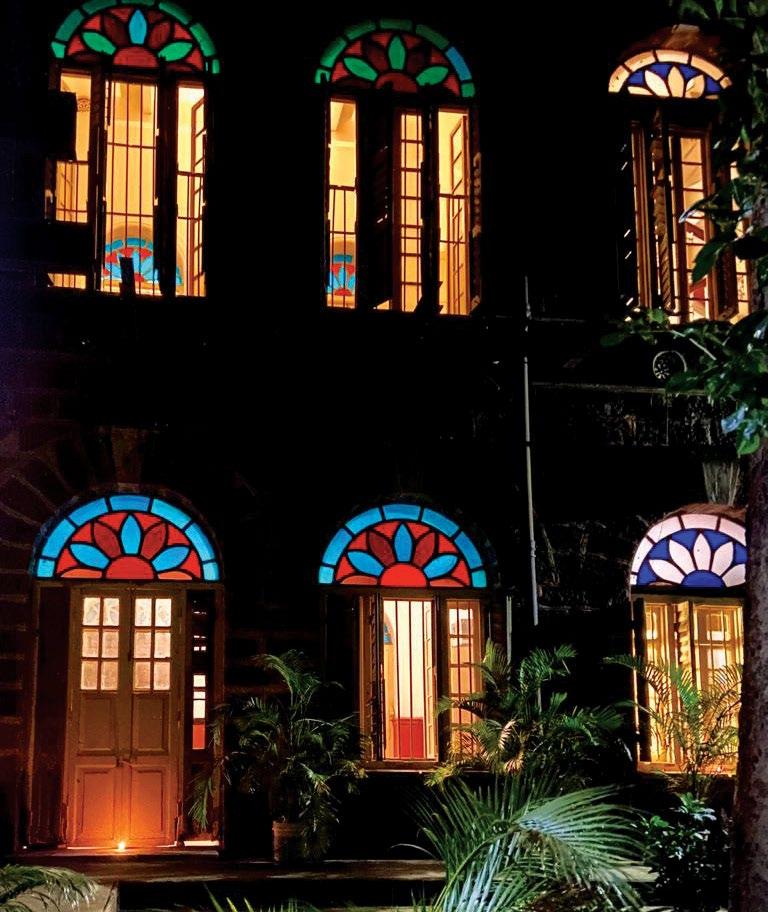

VP, IHCL (TAJ HOTELS)
“From a tourism perspective, Odisha has not been on people's minds, except for religious tourism to Puri. It’s only now becoming attractive thanks to the conservation effort to bring more Olive Ridley turtles to the state’s shore, which has been a success story.”
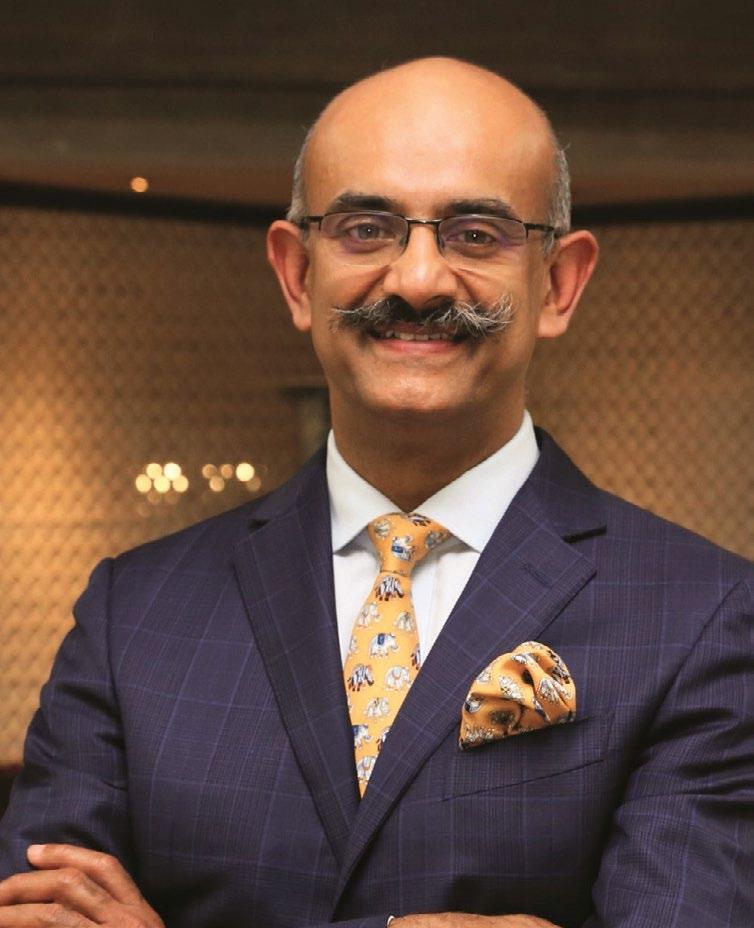


MD, E-FACTOR EXPERIENCES
“Odisha’s tourism potential is immense—rooted in a rare blend of ancient heritage, unspoiled natural beauty, tribal culture, and spiritual legacy. The state offers layered experiences that can appeal to spiritual seekers, adventure enthusiasts, cultural travellers, and luxury tourists alike.”
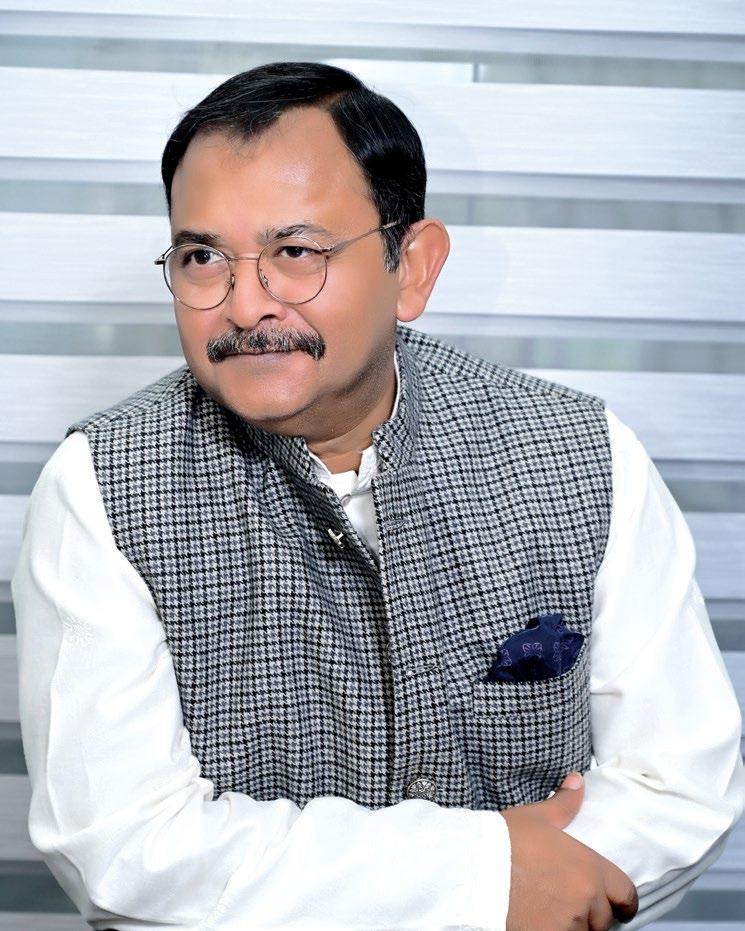
Despite considerable damage, the 13th century Konark Temple remains one of the most majestic temples ever built, globally.
BARIPADA
A historic town known as the ‘second Puri’, it abuts the famous Simlipal National Park.
BHITARKANIKA
Home to the state’s best-known national park, it has some of the most spectacular flora and fauna.
BHUBANESWAR
The temple city of India, is known for its architecture and grand temples. Also home to the Udayagiri and Khandgiri caves.
CHANDIPUR
An idyllic beach destination, it is very popular in the region.
CHILIKA
The largest saltwater lake in Asia, it is known for its teeming wildlife and unique way of life.
GOPALPUR
One of the state’s most charming seaside resort destinations, deserving of high-end hospitality.
HIRAKUD DAM
The 56 kilometre-long dam is one of the most impressive dams ever built and a marvel of modern Indian architecture.
KONARK
An outstanding 13th century temple built by the Eastern Ganga dynasty, is, even in its ruined form, one of the most impressive temples ever made.
PURI
The Jagannath Temple is easily the biggest draw of the town, though increasingly its beach is also finding favour with the tourists.
SAMBALPUR
The gateway to western Odisha, it is known for its distinctive culture and its hilly terrain, surrounded by rivers, hills, valleys and forests.
EXTREME


One of the unique ways in which Odisha chose to distinguish itself as a tourism destination was through the promotion of sports. The state’s journey in sports started in 2013, when it had sponsored the Hockey India League. During the tenure of the former Chief Minister Naveen Patnaik, the state hosted numerous sporting events and within
a decade, was the hub for sport tourism. “The sports segment got a big boost, particularly under the previous government,” says K Mohanchandran, Senior VP at IHCL (Taj Hotels). “Now FIFA is also looking at some tournaments in the state.”
In a cricket-dominated land, Cuttack’s Barabati Stadium has been

DIRECTOR AND CO-FOUNDER, LYFE HOTELS AND RESORTS
“The hospitality sector is full of promise, especially in Odisha that is developing rapidly. With growing infrastructure and tourism, there’s a rising need for quality hotels and services—and that’s an exciting opportunity to be part of something that will make an impact.”
a regular venue for international cricket. Puri’s doppelganger aspect is its identity as a surfing destination. Nearby Ramchandi Beach is the venue for an international surfing festival.
Most unexpectedly though, Odisha’s capital, Bhubaneswar, has become a hub for hockey and has successfully
hosted major international sports events like the FIH Champions Trophy 2014, 22nd Asian Athletics Championships 2017, Hockey World League Final 2017 and Hero Super Cup 2018 and International Men’s World Cup Hockey 2018. In 2023, Odisha government roped in former Olympians Dilip Tirkey and Lazarus Barla to mentor upcoming talent in the state.
After India won a medal at the 2021 Tokyo Olympics,
years ago. “Every aspect—from design to operations—demanded painstaking attention. The hardest part was standing out. Competing with global brands means constantly innovating while building a team that shares your vision.”
Still, Lyfe has ambitious plans. “We’re developing properties in Odisha, Kerala, and West Bengal. Our investments aim to contribute to both local economies and infrastructure,” says Sahoo, who is confident about growing the Lfye brand in the state. “Competition is part of any growing sector, and Odisha is no exception. Competing with big names like Taj and Radisson means we have to work harder to make ourselves visible. Our approach is to focus on what makes us unique—be it personalised service, local connections, or innovative guest experiences. Recruiting and training the right talent is also a priority for us. It’s about building a foundation that can stand strong even in a crowded market.”
Mayfair, too, is doubling down with Mayfair Sanctuary and the
Patnaik said, “For nearly four decades, the hockey fans have been yearning to see India grab a medal at the Olympics…The way the entire country was glued to the screens to watch the teams’ matches, it is quite evident there is something more to hockey than just sports.” More importantly, he announced continued state support for both men’s and women’s hockey teams for 10 years beyond 2023.
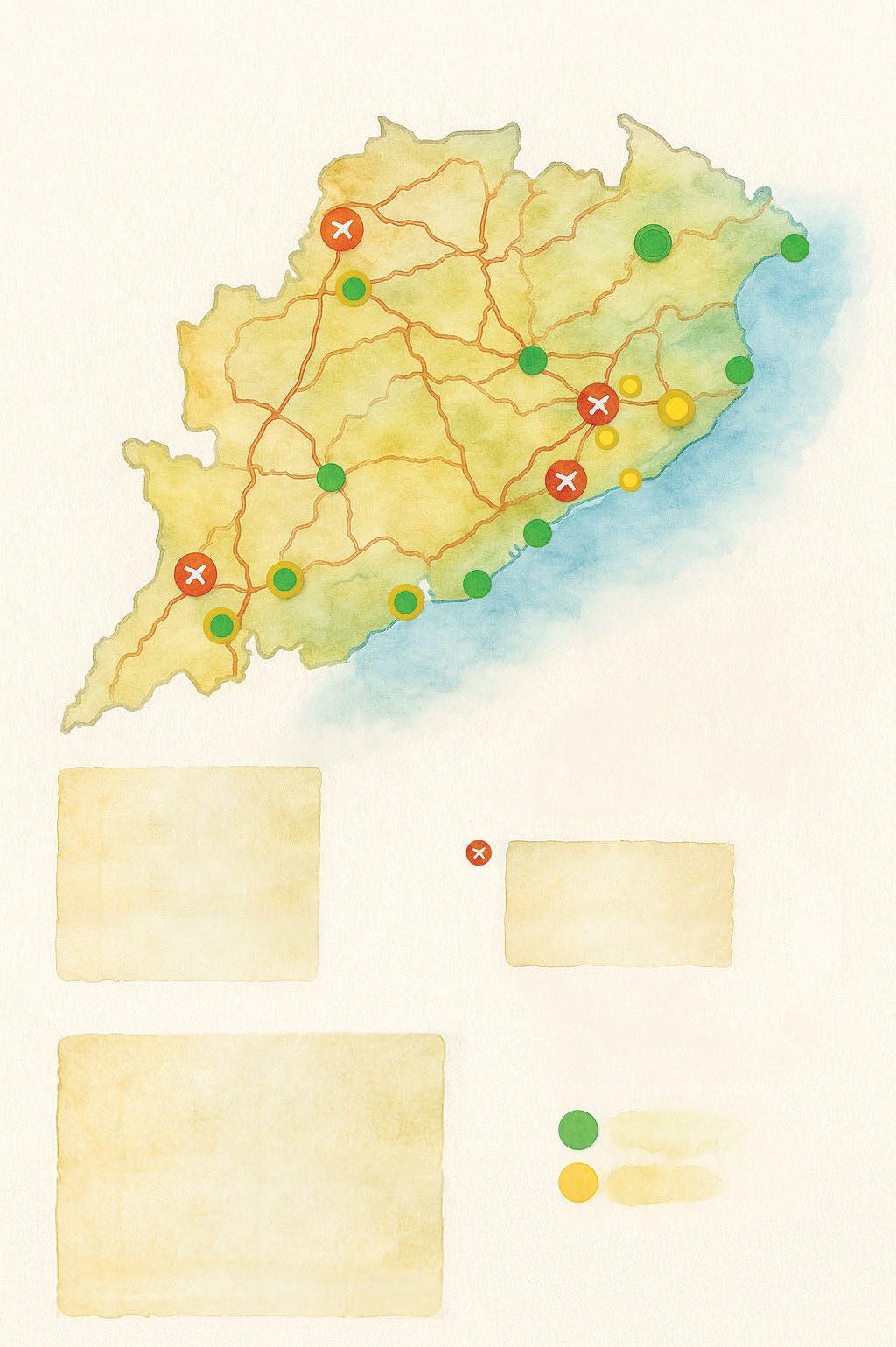
“The government’s initiatives to promote ecoretreats, heritage circuits, and tribal tourism have begun to change how people perceive the state— from a place known for religious pilgrimage to one that offers immersive, transformative journeys.”
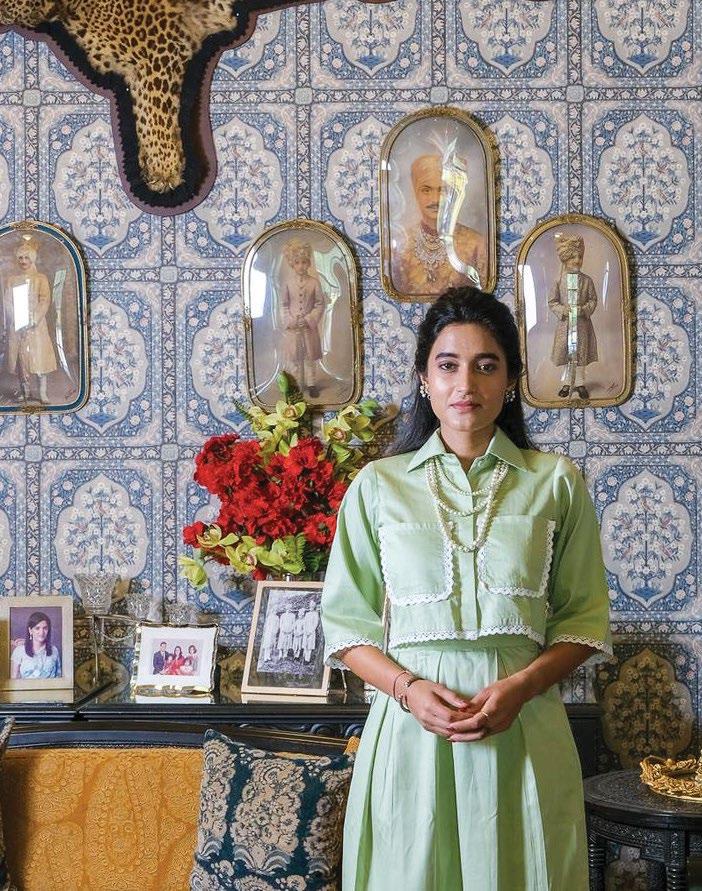
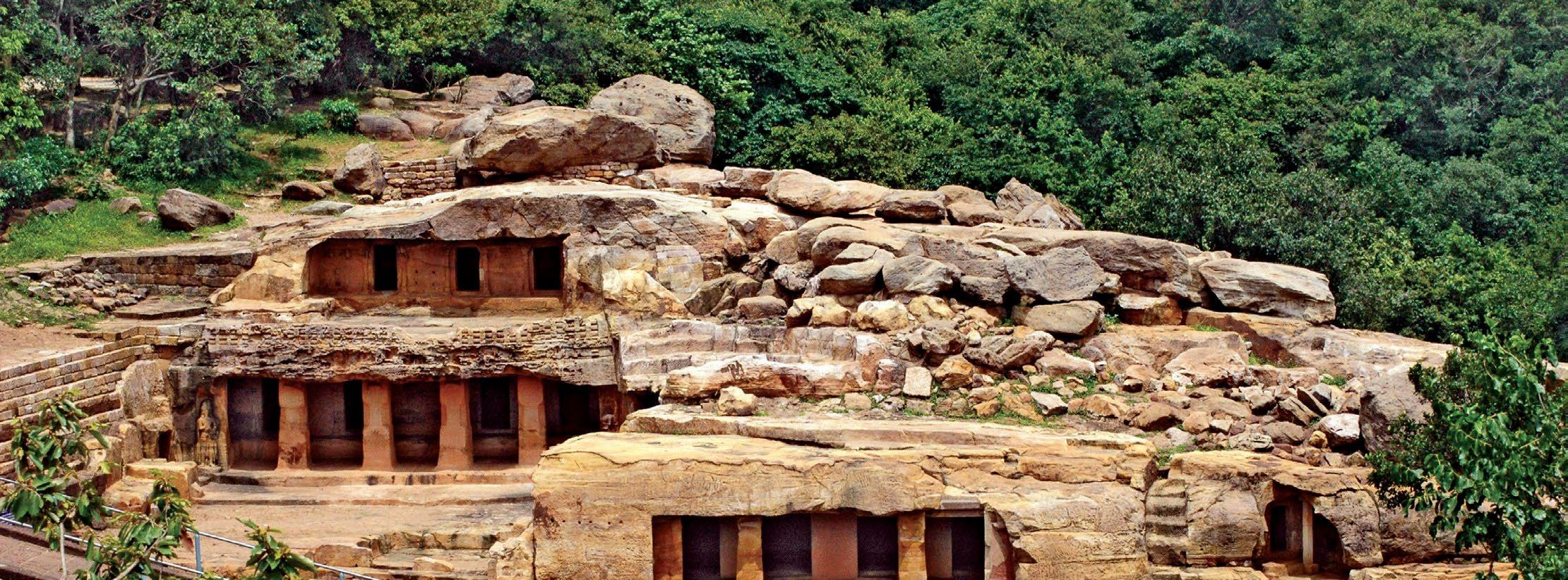
Khandagiri
Puri property. DeNiese notes the demand for world-class experiences is now everywhere. “Luxury is no longer a metropolitan expectation alone. With the rise of high-end weddings, conferences, and leisure travel, Odisha must keep pace— not just with infrastructure but with service standards and talent pipelines.”
Technology, too, will play a key role. “We must embrace automation and digital tools to stay competitive,” DeNiese continues. “The bar has been raised.”
Odisha at a tipping point
Various segments have received focused attention. Adventure tourism, with its vast potential, is
clearly on the government’s agenda. “Odisha stands as the premier destination for adventure sports, offering an array of breathtaking locations including beaches, dense forests, hills and more,” Parida had said earlier. “We are laying the foundation for the state’s tourism growth over the next 50 years, ensuring it remains a top destination for adventure and exploration.” The Odisha government is also set to roll out a policy aimed at positioning the state as a leading wedding destination in India.
Mohanchandran acknowledges the potential is real but early. “Our new Taj hotel in Puri performed strongly last winter. Investment is flowing, and the government understands this sector’s role in job creation.”
With strategic branding, stakeholder alignment, and thoughtful infrastructure, Odisha could become one of India’s most compelling tourism success stories. “This is the moment,” says Garg. “If we get it right, Odisha can capture global attention—not just as a spiritual retreat or an eco-haven, but as a world-class destination in its own right.”
It’s a vision shared by hoteliers, policymakers, and local communities alike—each working, in their way, to bring Odisha out of the shadows and into the spotlight.
New reports indicate the rate of investment in the sector is continuing to be strong.
SUMAN TARAFDAR
2024 was an exceptional, record-setting year for Indian hospitality, with every indicator pointing north. The question, by the end of the year, was whether these headwinds would continue in 2025. The global headwinds were turbulent. Besides, the easing of consumer demand domestically is not a good omen for sustained momentum in growth at the same pace in 2025.
Initial reports for the year however continue to be positive. India’s hospitality sector posted impressive gains in Q1 2025, with Revenue per Available Room (RevPAR) surging 16.3% yearon-year and 8% sequentially, according to JLL.
“Following 2024's recordbreaking year in hotel investments, openings, and signings, 2025 has commenced strongly and is further expected to maintain this momentum,” according to Jaideep Dang, Managing Director, Hotels and
CoStar (a global provider of real estate data, analytics and news)
Hospitality Group, India, JLL. “The first quarter of 2025 has ignited a dynamic hotel transactions market, with JLL already facilitating two deals in Chennai and Goa. Investor enthusiasm for both operational assets and land parcels underscores the sector's attractiveness, buoyed by favourable economic conditions, expanding commercial markets, and the government's recent budget push for tourism." This positive outlook is reinforced by substantial hotel development across various tiers, with over 42,071 keys signed in 2024. Bengaluru led the charge with a stellar 38.3% RevPAR growth. Delhi and Mumbai followed with 26.2% and 21.3% RevPAR increases, supported by
PHUKET TOKYO NEW DELHI MUMBAI OSAKA
$800
$700
$600
$500
$400
$300
$200
MALDIVES FRENCH POLYNESIASINGAPORE HONGKONG TAIWAN AUSTRALIA SOUTHKOREA JAPAN NEWZEALAND THAILAND VIETNAM
Source: CoStar
high occupancy rates. Chennai achieved 18.7% growth, bolstered by corporate travel and key events, while Hyderabad posted a 15.1% rise, despite a slight dip in occupancy.
According to Colliers, in Asia Pacific ADRs rose 3.3% year-onyear to US$92 in Q1 2025, a sharp rise from just 0.1% in 2024. While ADRs drove RevPAR gains, rate of
momentum is slowing. The next phase of growth will likely hinge on boosting occupancy, improving efficiency and attracting higheryield guests. Encouragingly, easing staffing shortages is enabling hotels to scale and enhance service without straining resources.
Of the top five destinations leading Asia Pacific ADR growth
in Q1 2025—Phuket (19.8%), Tokyo (14.8%), Delhi (14.8%), Mumbai (13.8%) and Osaka (11.4%), two are from India. Colliers says this is due to domestic demand, booming international travel and strategic positioning. These markets exemplify rate-led performance and set the pace for value-driven growth in the region’s hospitality sector.
Even more significantly, JLL predicts that $1 billion in investments is expected by 2028, implying massive expansion for the market. In Q1 2025 alone, 31 new branded hotels with 3,253 keys opened across the country. Sustained investor optimism also fuelled the signing of 79 hotels, adding 9,478 keys to the market pipeline, according to JLL. Q1 saw 31 branded hotel openings (3,253 keys), alongside major acquisitions like Chalet Hotels’ purchase of The Westin Resort & Spa, Rishikesh, for ₹530 crores. Strategic partnerships also gained traction, including Hilton’s deal with NILE Hospitality to roll out 75 Hampton hotels across India, with the first properties scheduled to open in Gujarat, Rajasthan, Punjab, and Bihar by 2026.
Capital continues to target hospitality assets in high liquidity markets in the Asia Pacific region as the sector moves from recovery to stabilisation in 2025, according to Colliers’ report, Asia Pacific Hospitality Insights May 2025. The report has found the steady momentum of 2024 has carried through to 2025, signalling a shift toward more deliberate, performance-led growth in the Asia Pacific hospitality sector.
The most traded hotel markets during this period were Japan, South Korea and Australia, with Singapore standing out as a key destination for generational wealth investment. India and Southeast Asia are also emerging as key demand engines.
“India is driving a structural shift in Asia Pacific’s hospitality landscape, fuelling resilient domestic growth while emerging as a powerful outbound force,
Source: Courtesy STR
according to Nikhil Shah, Managing Director, Hospitality & Alternatives, Colliers. “With strong demand across the luxury, lifestyle and MICE segments, and rising
investor confidence in experienceled assets, India is now central to regional tourism flows, sustaining premium pricing and reshaping travel dynamics.”
Restaurant and food consultants are increasingly crucial for a sector that experiences almost similar success and failure rates.
SUMAN TARAFDAR
Spending leisure time, catching up with friends, even getting meetings and work done at restaurants, established and new, seems arguably the absolute top hobby of Gen Z, in my rather anecdotal research.
Add to it India’s growing economic clout, which ensures increasingly higher disposable incomes in the hands of a substantial part of its residents, and it is no surprise that the restaurant sector has ballooned in the last decade or so.
It is gathering pace even now. However, it also has the highest turnover, with restaurants shutting down almost as fast as they open.
Valued at $80 billion in 2024, India’s food services sector is expected to zoom to $144-152 billion by 2030, according to a report by Redseer Strategy Consultants. Across segments, India is estimated to have over 500,000 restaurants. In 2024, industry insiders estimated about 2,000 new restaurant openings each month in India, though this is tempered by a significant closure rate—the National Restaurant Association of India citing a 30-35% closure rate. According to Mordor Intelligence’s projections, the café and bar market is estimated to be worth a notable $17.54 billion in India in 2024¸ and is expected to clock a CAGR of 8.33% through 2024 to 2029.

What emerges very quickly in conversations with people from the food and beverage industry is the number of clients looking for help as they contemplate opening a restaurant. “This industry requires consultants for two major factors,” says Anthony Philip S, Founder, Table and Fork. “One, of course, is the business point of view, and the other is the food and beverage. It is not just newcomers; maybe the existing players are trying to enhance their menus, so they require consultants and expert advice.”
Consultants in the restaurant and food space have emerged in the last 15 odd years, a time frame that coincidentally syncs with the fastest rate of economic growth for the country. One of the earliest was Secret Ingredient, now one of India’s leading food and beverage consultants. It was conceptualised around 2010, as a space to provide proper professional, ethical and scientific ways to help the sector, points out Sid Mathur, Founder and Director.
“At that time, there was no sort of deep thinking as a category and somebody who could sort of even handhold a client, and there was nothing like it,” recollects Mathur. “There were a lot of chef consultants. Although they are fantastic, they are focused more on the menu, just one part of the business. Whereas when we started, we felt that there was so much more to a commercial success of a brand, from the research, the concept, the look and feel, the experience, the way
people are interacting with your brand, what you are doing right, what you are doing wrong, and service. So, keeping all of that in mind and from our perspective, we had the experience of the sector. We had opened good restaurants. We had also seen the bad. With all that information, with all that data and with all that experience, it just became easier for us to work on projects. As we worked on more and more projects across industries, across clients, across different formats, that knowledge base became so solid that today we have done 70 cloud kitchens, 50 hotel projects and 100 restaurants.”
‘Have Money, Want Restaurant’. Consultants say they encounter this attitude more often than not.
“I think a lot of people in India are quite clueless about what they want,” points out Goa-based chef Gracian De Souza. “They typically want to do cookie-cutter models. So they see something working somewhere, and they will come and tell you, 'Let's just copy the guy.' The reality is that very few people are willing to put in some time and effort into market research and in finding the right people. I always tell my clients that the easiest part is to open a restaurant. Right. The hardest part is running it.”
Much like restaurants, bars, too, are onboarding consultants to create an experience that makes them stand apart.
For bar consultant Pankaj Balachandran, Founder and CEO, Countertop India and Co-founder - The LAB, Boilermaker and Mr. Jerry's Cocktails, the scenario has Olive has effectively been the signature restaurant for AD Singh's restaurant empire.






Have a clear vision of the character of the restaurant/bar you are planning to open.
Have a clearly delineated plan before opening.
Do thorough research—most importantly about the location, costing, legalese, interiors, cuisine, staffing, operations, rentals, and potential clients.
Plan for at least one year—very rarely does success come immediately.
Have adequate budgets, as break-even may take a while.
Invest in the right tools, right ingredients, right people.
Get a good support system— family, friends, whoever you can rely on.
Do not get impatient at the lack of immediate success.
Tweak the format only if necessary. However, be flexible if the format is suitable.
Utilise free publicity, but remember, even the smallest mistake or shortcoming can get amplified on social media.
TOP TO BOTTOM: Petisco positions itself as a gastrobar with creatively curious food, cheeky cocktails & a vibrant ambience; Tesouro was an ode to the Goan village tavern of yore; Delhi NCR's newest Modern Asian restaurant, NIKO is one of Secret Ingredient's latest projects.

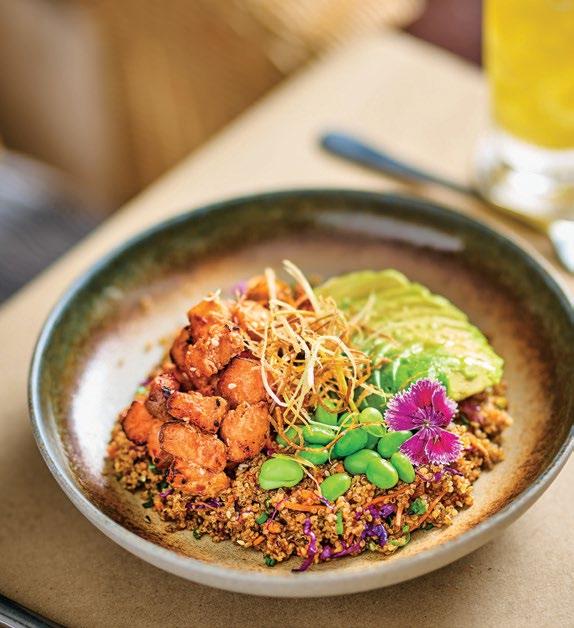
evolved in the last 10 years. “I have seen that it has changed the landscape completely. When we got into the business of consulting for bars, we wanted to build bars which were places that we could go and drink at. There were not many bars doing the quality style of drinks service, or hospitality that guests desired. So we got into the business of building bars.”
Balachandran says that a major game changer was COVID, as “it was very, very important for the industry to propel through. A lot many people were looking at drinking at home as well as going out, experimenting and trying out new things. Consumers have evolved. Now, instead of travelling to venues for sightseeing, more and more consumers are trying out bars and restaurants. A Michelin dining experience or a 50 Best Bar experience has become a part and parcel of everyone's itinerary nowadays.” And thus the need to up the game, seeking professional help to stand out in an increasingly crowded market.
“We usually share an interview docket for them (clients) to fill
and share with us before we even decide to take up the project,” explains Balachandran. “We ask a lot about the design and the layout, because drinks are the least common denominator for us when it comes to setting up the bar. If a drink is not working out, we can always change it. But we have to ensure that the hardware is solid. E.g. the workstation, the layout, the workflow, all of these definitions, these questions have to be answered in depth and clarity. There is no ideal size or layout. If it is a cocktail bar, you know who you are catering to. If it has 120 covers, then it has to have two stations, five refrigeration units, and one freezer unit, definitely inside the bar. If it’s a high-volume bar, it changes.”
Managing expectations is another aspect. “One of the things that people ask today is, ‘I want to open a bar that makes it to the ‘50 Best Bars’, which is a completely wrong way of approaching the business,” points out Balachandran. “The biggest challenge is to tell them that first, open a bar, run it successfully, and
FOUNDER AND CEO, COUNTERTOP INDIA CO-FOUNDER - THE LAB, BOILERMAKER, AND
MR.
JERRY'S COCKTAILS
“When we got into the business of consulting for bars, we wanted to build bars which were places that we could go and drink at. Not many bars were doing the quality style of drinks service, or hospitality that guests desired.”
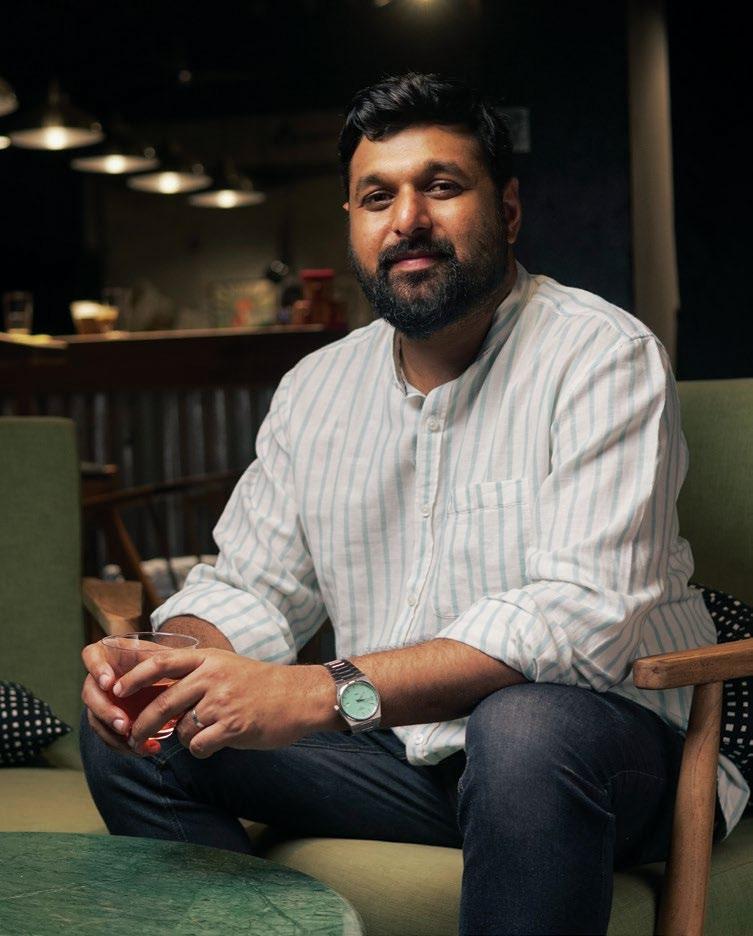
KULA NAIDU DIRECTOR, SECRET INGREDIENT
“We encounter clients who want to enter the restaurant business for all sorts of reasons... For some people it's no longer about RoI— Return on Investment—but RoE: Return on Emotion, or worse, Return on Ego.”

awards will come to you. You can't pay for it. Right. You have to make it happen.”
De Souza suggests four key parameters for any prospective client looking to open a restaurant—a good concept note, a strong F&B philosophy backed by a team that can execute that philosophy and—in today's day and age—a marketing team that can market the philosophy. “The first thing I tell my clients is that
you have got to create your own identity. You have to understand why people are coming to you. That answer comes from market research. You cannot copy paste models and think that, oh, because they are doing well, I will also do well; that doesn't exist anymore.”
According to him, the greatest help first-time clients require is with staffing and consistency.
“I think India is very diverse. There's a big difference in the consumer market when it comes to restaurants between the north, south, west and east. What necessarily works in Delhi does not work in Mumbai and vice versa. What works in Mumbai does not work in Bengaluru. If you are
playing safe with a bar format or a coffee format, then that’s fine; India is an evolving young market, so everyone wants to go out and drink coffee. Everyone must go to a bar and have a drink. But a serious food programme in a restaurant, I see very few successes. You cannot make a menu and say, I'm going to circulate this menu pan India, and believe it's going to work everywhere. There will be a lot of tweaks that will have to be made based on the location that you are in. Generally, as Indians, we are a bit closed. I think Mumbai is the one place where you can go out, be original. I see that same acceptability in some pockets of Bengaluru as well.”
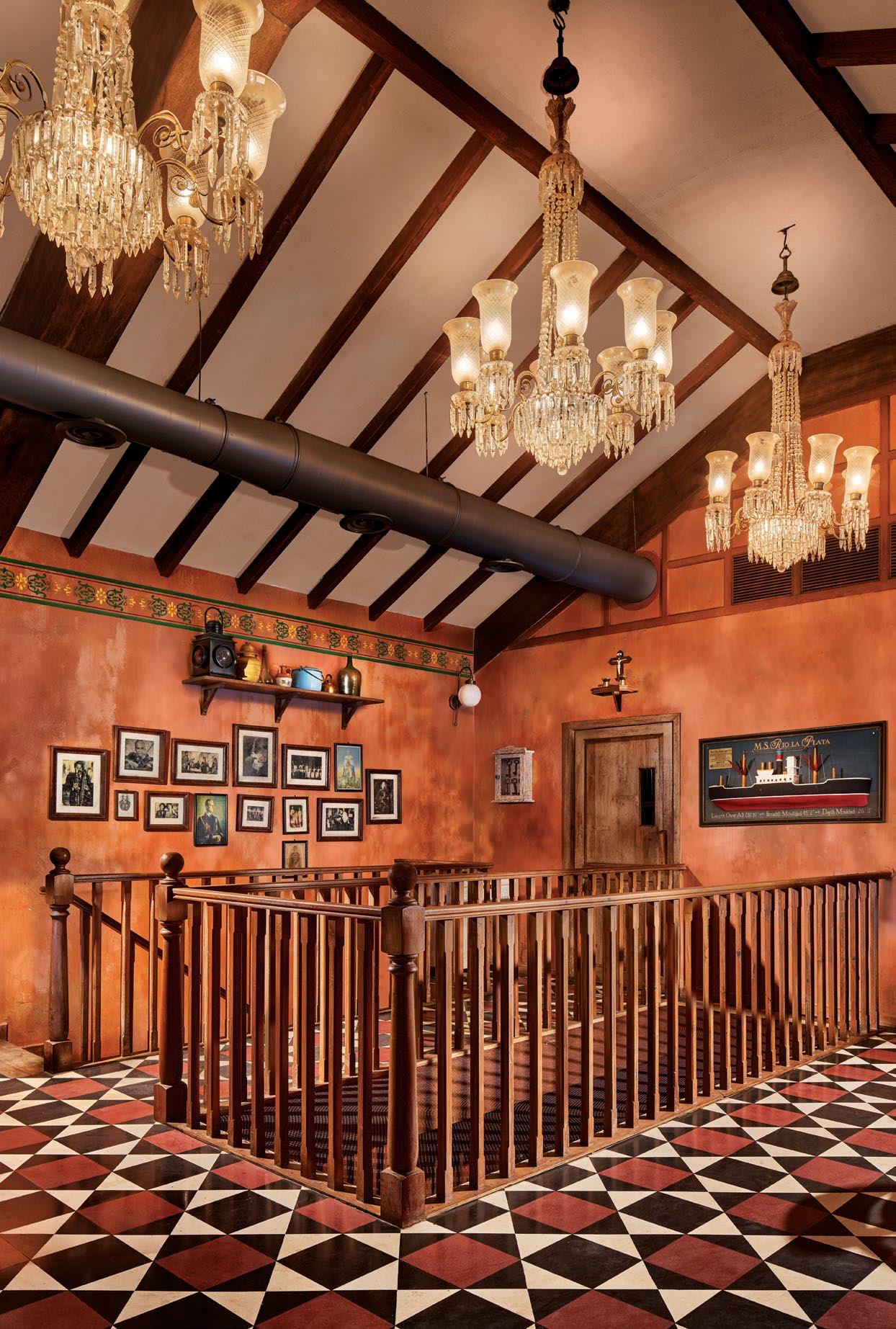

CHEF AND RESTAURANT CONSULTANT
“I think a lot of people in India are quite clueless about what they want. They typically want to do cookiecutter models.”
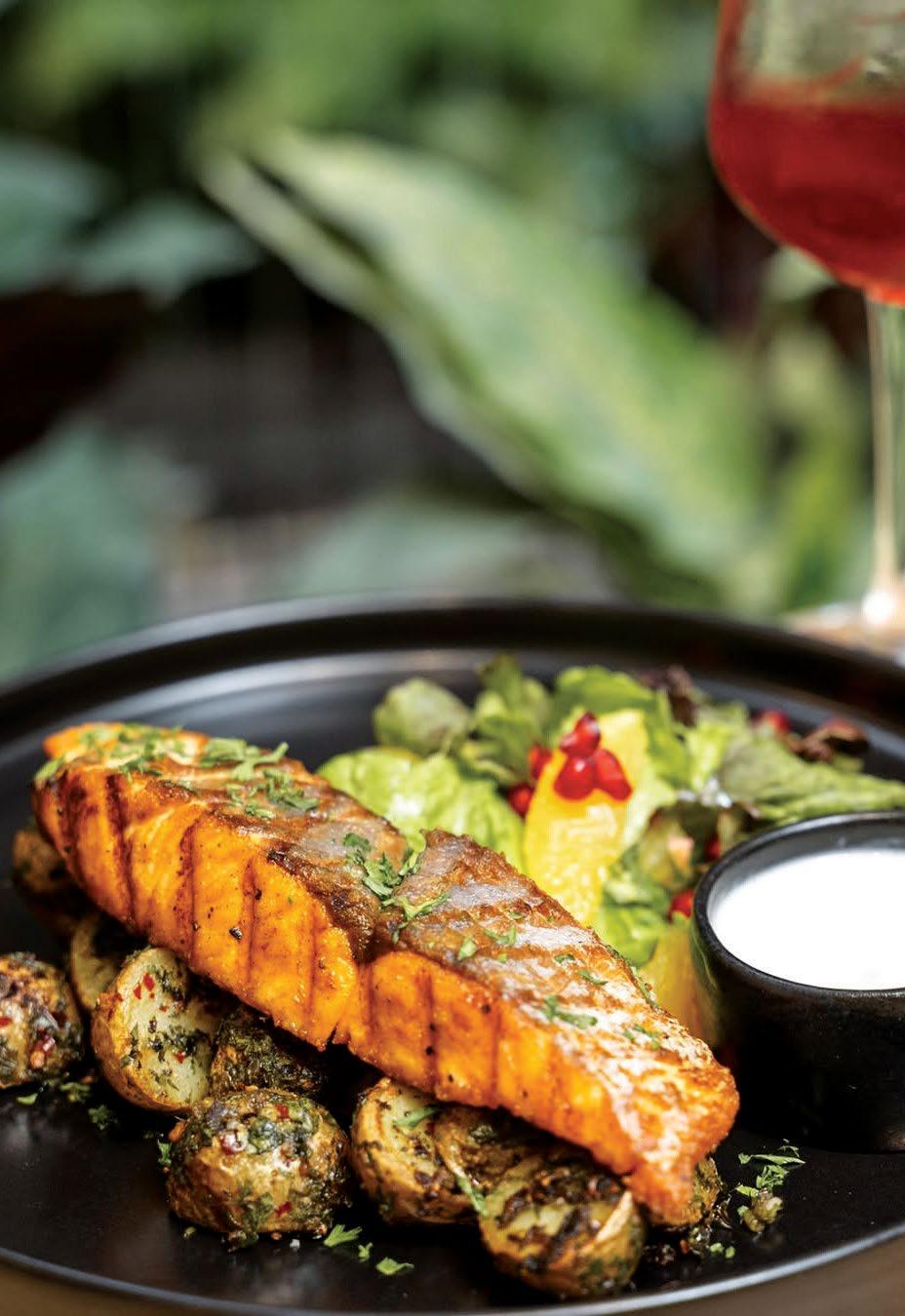
Even the most cursory glance reveals that restaurants, cafés and bars have upped their game considerably in the last few years—a combination of greater awareness, especially of global trends, better availability of ingredients, and of course, rising disposable incomes combined with a desire to experiment. Kula Naidu, Director, Secret Ingredient, explains that over the years, the process has become easier for them. “When we meet a client, we are also armed with the benefit of having done such a variety of applications in the food industry that it becomes easy for us to understand the project, understand the client. The idea, at the end of it, was just to do a good job and stand by the client. We never said we are your consultants, we said we are a part, an extension of your team.”
Naidu cautions that it can be tough. “Restaurants are unforgiving; the turnover rate is very high; it is actually much worse now. Customers have become more savvy and demanding. Now you cannot just have an average restaurant and expect it to last. Rents are going up, salaries are going up, staff are difficult to find, and retention is an issue. As a
consequence, we are seeing a lot of turnover.”
De Souza gets granular dissecting the planning process, pointing to common pitfalls.
“I would say don't open a large format restaurant, open a small format. If you start with a 300-cover French or Japanese cuisine restaurant, it is not going to work. You may get there may be in the year five. Start with a 40 to 50-cover restaurant. For a fine dining or even a casual space which concentrates on the cuisine, I think going above a certain cover limit is pretty difficult.


It's not about 50 covers; you can get 50 times five in a day. So it means you need 250 people every single day for your restaurant to be profitable. If you want to push the envelope, do something very traditional, be innovative, an entrepreneur has to have very deep pockets to sustain the losses over a period of time. I have seen the best businessmen just say it's a business. At the end of the day, if it's not profitable, then we need to shut down. So I think the smart move is to kind of bootstrap and make sure that you're not spending where spending is not required.”
He points to Cavern, his project in Coimbatore, which serves South Indian inspired bar food, put together in a fun way. “But Coimbatore, being Coimbatore, is not seeing the light of day in terms of where the menu is and where it could be because it's a small town, and probably doesn't attract the right audience.”
When advising clients, Naidu and Mathur emphasise that financial viability must be the top priority. “We encounter clients who want to enter the restaurant business for all sorts of reasons,” says Naidu. “Often, they’re not in it for the right reasons. Some come from considerable or even generational wealth, and their children want to start something of their own, believing that opening a restaurant will be glamorous, and a fun way to entertain friends. But we make it clear from the outset: this is a business, not a social hobby. If you're not treating it like a business—if you're not closely monitoring rent, keeping salaries within sustainable limits— you’re setting yourself up for disappointment. As Sid aptly put it the other day, for some people it's no longer about RoI—Return on Investment—but RoE: Return on Emotion, or worse, Return on Ego.”
All of them agree that having a viable, well-thought-out plan
is far less common than one might assume. “Research is one of the things we approach very differently at Secret Ingredient,” says Mathur. “We invest time in truly understanding the landscape—who your target demographic is, what the pricing benchmarks are, what trends are shaping the market, and most importantly, who your guest is. What’s their personality, their preferences? We bring all of that together to create a well-balanced, strategically aligned concept.”
Consultants are unanimous in suggesting that running any food and beverage establishment requires commitment, especially in terms of time. Philip points to United Coffee House, founded in 1942 by Lala Hans Raj Kalra, which is now handled by the third generation in the form of Akash Kalra. “He handles day-to-day
operations. He comes early in the morning, goes late at night, and is a very good example of how to make a restaurant succeed.”
An emerging trend is the growing demand from hotels seeking expert advice on how to operate their restaurants more effectively. In India, especially among top-tier hotels, there has long been a focus on offering multiple dining outlets. However, a significant number of these have become white elephants—high-cost operations that fail to generate adequate returns and ultimately weigh down the bottom line.
While F&B consultants have increasingly started working with hotels, they unanimously point out that there are differences. “One major factor is the time needed to create a hotel, says Philip.
Hitchens, Mumbai, a cocktail-forward resto-bar, is a byword for new age eateries.

“While for a café, the timeline is three months and for bars and restaurants, at the most, four to six months, a hotel project may take years. However, it's very comforting to create a menu because you have time to do research.”
At Delhi’s Le Meridien, Secret Ingredient recently played an instrumental role in presenting its legacy restaurant Le Belvedere in a new avatar. To bring XO & Mi @Le Belvedere to life, Mathur says, they went through a comprehensive approach encompassing research, concept development, design collaboration, and operational planning. “Starting with extensive internal research and a feasibility
study, Secret Ingredient conducted a deep dive into the target audience, local demographics and market trends.”
From interior mood boards to the development of brand touchpoints, every element was meticulously curated to create an unforgettable experience, Mathur elaborates. “Secret Ingredient worked closely with designers to conceptualise and bring to life this vision, ensuring every detail contributes to the immersive experience.” It also played a pivotal role in optimising operational efficiency, refining kitchen layouts, and selecting high-performance equipment to meet regulatory standards.
The contribution spanned the core structure and hiring process, defining the ideal team requirements and aiding in the recruitment of top-tier culinary talent, including sous chefs, CDPs, and mixologists.
Philip is working with The Park on a ten-room boutique property in Ranthambore. “We do everything—from restaurants to hotels,” Balachandran says. “We have done a bunch of hotel programmes, but they are also open to people running their venues. I think hotels are a bit more rigid when it comes to ideas. Fifteen years ago, they ran successful venues when nothing much existed. It's a slow



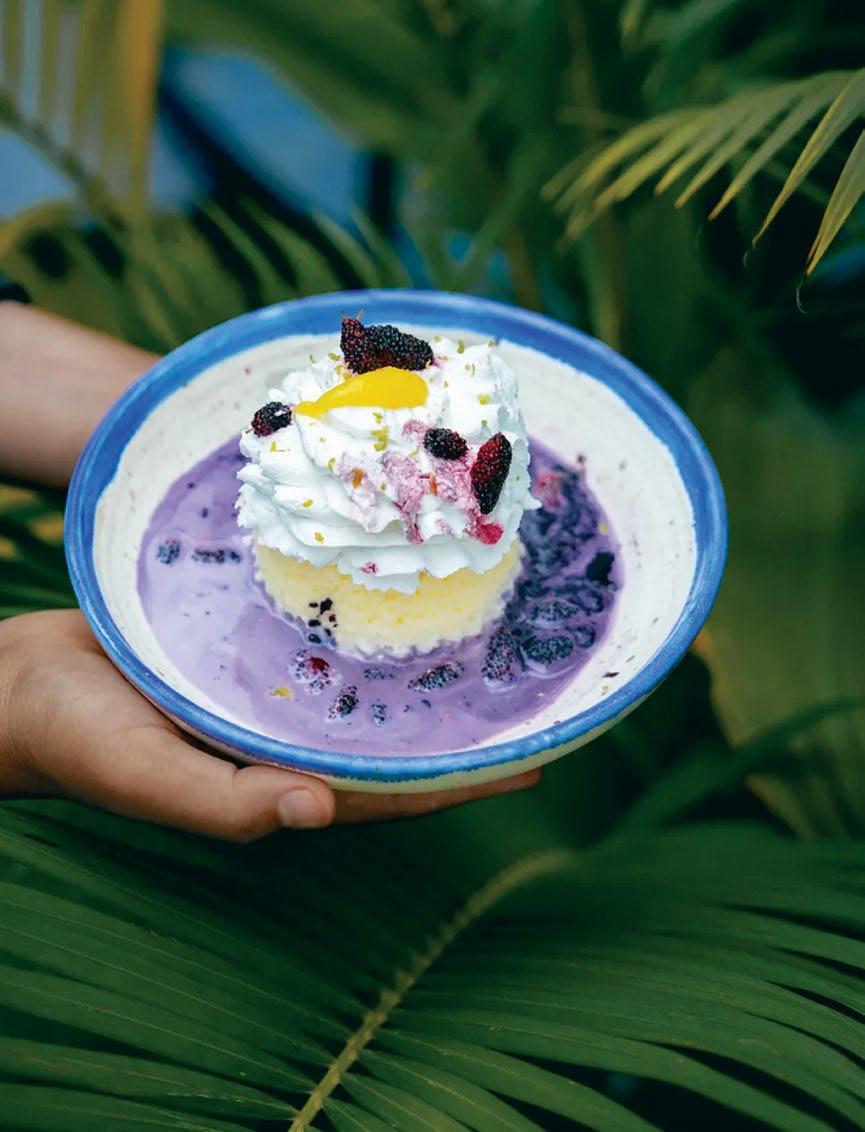
process with them, but I think it is happening.”
De Souza notes that smaller hotels are increasingly turning to consultants, recognising the untapped potential of their prime real estate. “I’m working with a very old group that recently decided it was time to revive their F&B offerings,” he says. “Once
“While for a café, the timeline is three months and for bars and restaurants, at the most, four to six months, a hotel project may take years. However, it's very comforting to create a menu because you have time to do research.”
industry players understand the value consultants bring—and once there’s a track record in place—I believe these partnerships can be very productive.”
He acknowledges, however, that working with hotels tends to be more time-consuming. “When you look at hotel hierarchies, there’s the general manager, the executive chef, the F&B director… but often, they lack exposure to the outside world—especially the dynamics of standalone restaurants. Now, hotel owners are starting to realise they want that culture to come in, which is why they’re reaching out to independent consultants to help elevate their food and beverage programmes.”
As for where the space is likely to evolve to, Philip says he would want to see consultants get involved in day-to-day operations. “Let's say a client is busy in marketing, arranging finances, expansion, etc. The consultant can handle the day-to-day operations in the kitchen and ensure quality control, leaving the owner to focus on expansion.” Balachandran agrees. “Because of the right guidance, help and support, many bars are now upping their game. Here, consultants definitely played a major part in improving overall systems. And this is likely to continue.”
De Souza emphasises the importance of hiring the right people with genuine passion to lead the process. “I’ve worked on around 80 projects over the past eight years—roughly 10 to 12 a year,” he says. “In my experience, the projects that have succeeded, or are still going strong, are the ones where the promoter and I, as the consultant, were aligned from the very beginning. That alignment is critical.”
The message seems clear. As the Indian hospitality sector grows, consultants are here to stay. The crucial question is: will clients heed their expertise, or disregard their suggestions? That choice could be the crucial difference between long-term success and yet another name on the turnover list.

To celebrate Pride Month, SOH sits down with renowned chef Suvir Saran to explore his trailblazing journey as an openly queer culinary leader, breaking barriers, and his vision for truly inclusive hospitality.
RACHNA VIRDI
In kitchens long defined by hierarchy and tradition, chef Suvir Saran stands out—not just for his culinary brilliance but also for his unwavering authenticity, courage, and transformation.
Out of the closet for years now, the celebrated culinary icon’s story extends beyond the boundaries of food and restaurants—the narrative encompasses dismantling norms, reclaiming public space, and championing equality through every plate and policy.
In this candid conversation, he reflects on navigating the culinary world as a queer professional, the deep intersections of identity and culture, and his steadfast belief in institutionalising inclusivity—not as tokenism, but as a conviction that should shape the very DNA of hospitality.
Looking back to when you started, how were LGBTQ+ identities perceived or treated within the industry?
I began my journey in hospitality in 1993, in New York City, at the age of 21. I didn’t have a kitchen job or a formal setup—I had a tiny student apartment where my roommate and I threw wild dinner parties. I cooked. He cleaned. People came, they brought their friends, and we created a stir. It was chaotic and beautiful, and every night was a ride.
Being queer back then was still a complex thing, even in Manhattan. The gay community was coming of age, but I was still seen as “the other”—I looked foreign, I looked Arab, I looked Sabra. People didn’t quite know what to make of me. Was I closeted? Not really.






In America, I didn’t feel I had to hide—I lived alone, away from family, and the people around me were strangers who quickly became friends. I had the freedom to just be. But the weight of not being out to my parents in India gnawed at me constantly.
At what point in your professional journey did you choose to be publicly open about your sexuality? How did that decision influence your approach to leadership, team dynamics, or professional relationships?
I wasn’t hiding, but I wasn’t fully out either—not to my family. And that weighed on me. The turning point came in 1994. My partner and I had been living together for months. I’d call my boyfriend “my roommate” when speaking to my grandparents. That duplicity felt corrosive. One day he said, “Either you acknowledge me fully, or let’s rethink this. If we’re living together, and we’re real, then you owe it to yourself to be honest.” That moment pushed me to come out to my family—over the phone. It wasn’t easy, but it was honest. And it freed me.
Professionally, being open didn’t hurt me—at least not in any obvious ways. What helped was that I was offering something radically new: home-style Indian food that America hadn’t tasted before. And people respected that. I created inclusive spaces because I craved inclusion myself. My teams were diverse because I wanted to build what I didn’t see around me—mutual respect and real representation.
Visibility often brings scrutiny—especially in conservative spaces. How did being openly queer shape your brand’s reception in India? I never felt my queerness closed doors. If anything, it set me apart. I wasn’t cooking Butter Chicken and Dal Makhani. I was cooking Nadru ke Chaap, Phool Makhane ki Sabzi, Patta Gobi—dishes people hadn’t seen in a restaurant setting. The food spoke volumes. The media, the guests, even the staff—they responded to authenticity, to colour, to story. Being openly queer didn’t hurt that; it amplified it.
As a business leader, how have you embedded meaningful inclusivity—beyond token gestures—into your team culture,

“
At
Neuma and Jolene, we are openly queer and proudly at the forefront. We've faced no marginalisation. In fact, we've been celebrated. So yes, India is more ready than we think. We just need to lead boldly, with integrity, heart and a vision.”
hiring practices, and guest experiences?
From day one, I led by example. If I wanted respect, I gave it. If I wanted inclusion, I practised it. My staffing was diverse because I wanted to reflect the world I believed in. I didn’t have a big HR team. I was the chef, the CEO, the dishwasher, the creative director—and the culture I built was inclusive as I needed it to be.
I hosted Pride events. I marched with SALGA. I once wore a Pakistani flag for Pride when no one else would—not to provoke, but because my grandparents came from there and I saw no borders in love or solidarity.
Can you share specific initiatives or policies you've implemented to create a more inclusive and equitable workplace?
At Neuma in Mumbai and Jolene in Goa—both projects I lead with my partner Gaurav Batra— we’re two openly queer men at the helm. We bring our identity into the space, openly and proudly. That sets the tone. We make it clear to our teams: if you can’t respect your queer colleagues, you can’t work here. Period. It’s not about policies pinned to a wall. It’s about lived culture—respect, safety and openness.
In what ways has your identity shaped the creative direction, values, and overall vision behind the brands you’ve built?
My identity is a part of how I live, how I love, how I cook, how I design. I studied graphic design and art history. My menus, uniforms, and interiors all reflect my sensibility—bold, colourful, inclusive, and thoughtful. My queerness isn't a feature—it’s in the fabric of everything I create.



Have you felt a sense of responsibility to advocate for queer rights? If so, how have you used your platform to do so?
It’s not a responsibility—it’s an instinct. My father taught us early: if you have a stage, use it to amplify the unheard. We were raised on the idea of Vasudhaiva Kutumbakam—one world, one family. So when I speak up, it’s not a performance. It’s a reflex.
Has inclusivity evolved beyond just a CSR checkbox in the Indian hospitality sector?
We have come a long way. Social media has made everything visible—the good and the hateful. But overall, there’s more acceptance. More conversation. More people are willing to learn. There’s still a long way to go. Inclusivity can’t stop at rainbows and hashtags. It needs to be a policy. It needs to be protected. Too much of it is still performative. A rainbow sticker doesn’t mean you’re in a safe space. Real inclusion is about agency, access, and equity. Not just posts and posters.
When working with conservative investors, how do you navigate the balance between your convictions and making pragmatic business decisions?
I’ve had to push back—many times. Investors have said offensive things about queer people, women, and the differently abled. And I’ve had to correct them. Not for applause, but because staying silent would make me complicit. You can’t build a brand of dignity if you don’t defend it.
Do you believe the Indian hospitality industry is ready to embrace queer-led spaces as a viable and sustainable luxury offering?
It’s not about India being ready—it’s about us making it ready. And we are. At Neuma and Jolene, Gaurav and I are openly queer and proudly at the forefront. We have faced no marginalisation. In fact, we’ve been celebrated. So yes, India is more ready than we think. We just need to lead boldly, with integrity, heart, and with a vision.
If you were to reimagine Indian hospitality from the ground up, which existing structures
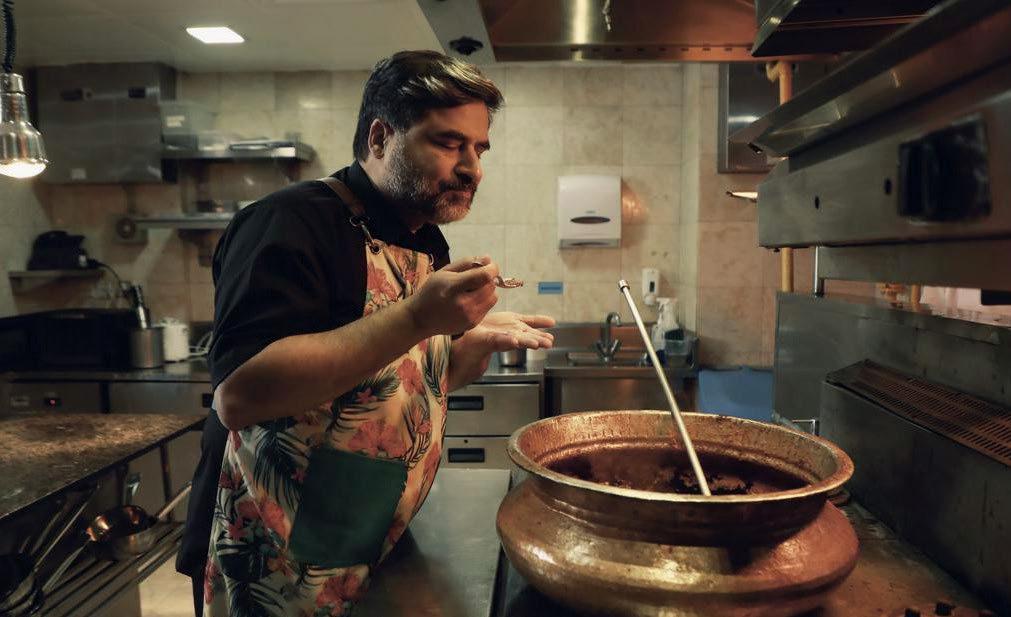
or mindsets would you prioritise dismantling?
I’d start with how we treat our staff. We underpay them, delay salaries, disrespect their time and dignity—and then wonder why they leave. Hospitality starts with the people on your floor. If they feel seen and supported, guests will too. The industry must learn that.
How receptive is the indian hospitality industry to hiring professionals from the LGBTQ+ community?
There are leaders like Keshav Suri and Vivek Shukla at The Lalit doing exemplary work. But they’re the exception. Most others still treat queerness as a PR strategy, not a lived priority. We need more action and less performance.
How do you perceive the value of the ‘pink rupee’ within the Indian market and hospitality industry?
Right now, the pink rupee is mostly lip service. It’s not being taken seriously by most investors or partners. Brands want the market without doing the work. That has to change.
What advice would you offer to young queer professionals in the hospitality industry?
Be proud, be professional, be prepared. This is not a quick path to fame. It’s a demanding, exhausting, deeply human business. Work hard and stay kind. Find your allies—especially women, who face similar marginalisation. Aim for excellence and not applause, as that’s what lasts. And always, lead with grace and integrity.


BY DEEPALI NANDWANI
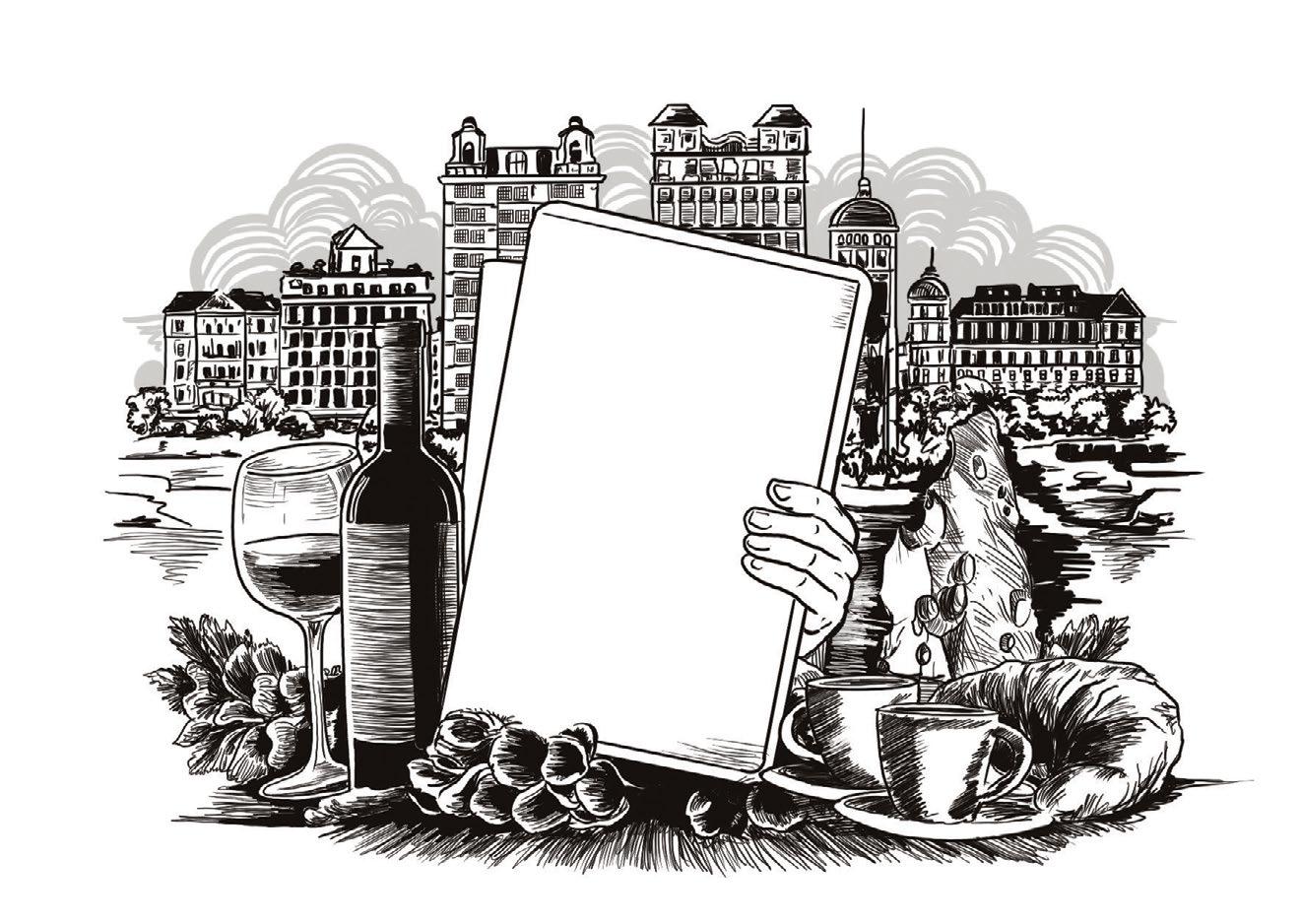
Iceland is fast becoming a bucket-list destination for Indian travellers seeking experiences beyond Asia. Drawn by the Northern Lights, glaciers, geothermal wonders, and the midnight sun, a growing number have already explored this remote Nordic gem. Reykjavik, with its museums, street art, and striking churches, adds a cultural edge to Iceland’s dramatic natural beauty.
China is set to break another aviation record with Jinzhou Bay International Airport—soon to be the world’s largest on an artificial island. Rising off the northeast coast near Dalian, the 20-square-kilometre hub will feature a 900,000 sq. m terminal and is designed to handle 80 million passengers, surpassing both Hong Kong and Japan’s Kansai airports as the largest offshore aviation hub.
Opened in late 2023, Hotelito at Musa is redefining eco-luxury on Mexico’s Pacific coast. Fully solar-powered, it uses greywater recycling and rainwater harvesting to cut freshwater use—vital in this water-scarce region. A chemical-free natural pool and cutting-edge coral reef restoration efforts highlight its commitment to regenerative, lowimpact hospitality.
A quiet coastal district in Andhra Pradesh is fast gaining attention in hospitality circles. Here, the Godavari River spreads into lush islands before meeting the Bay of Bengal, offering 93kms. of untouched shoreline, Kerala-like backwaters, and sacred landmarks. Considered southern India’s next tourism hotspot, it blends natural beauty with cultural richness— captivating both travellers and investors.











